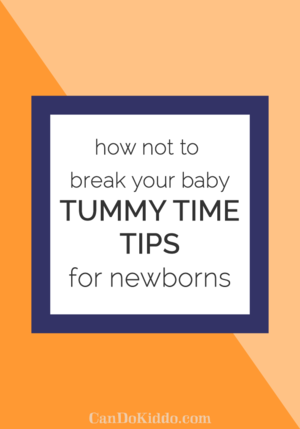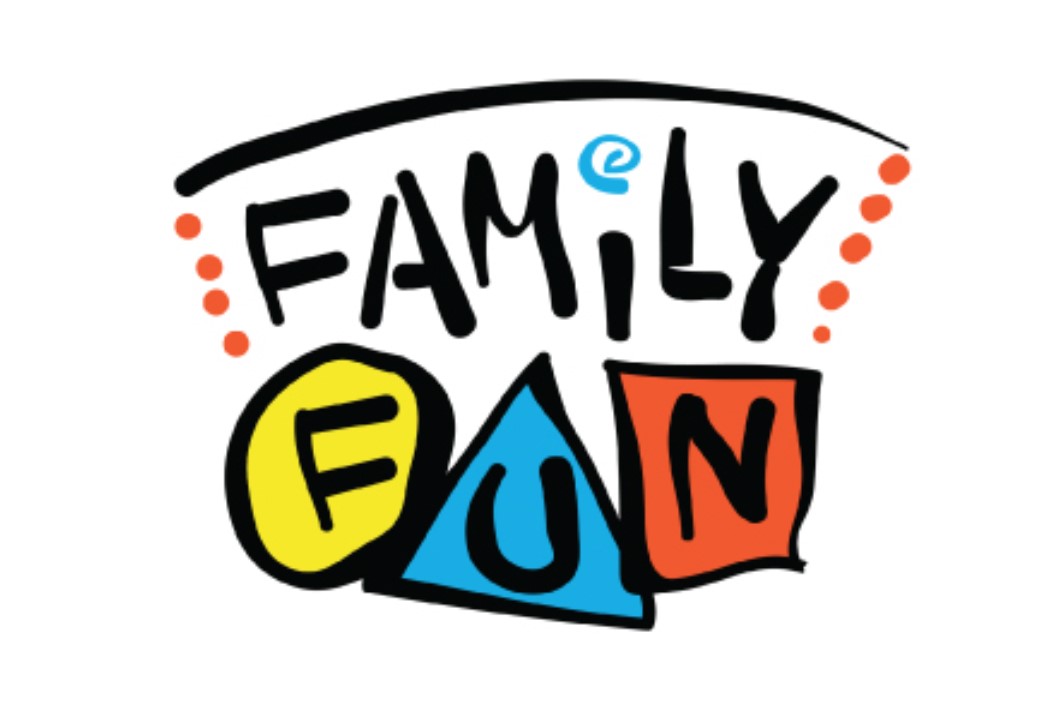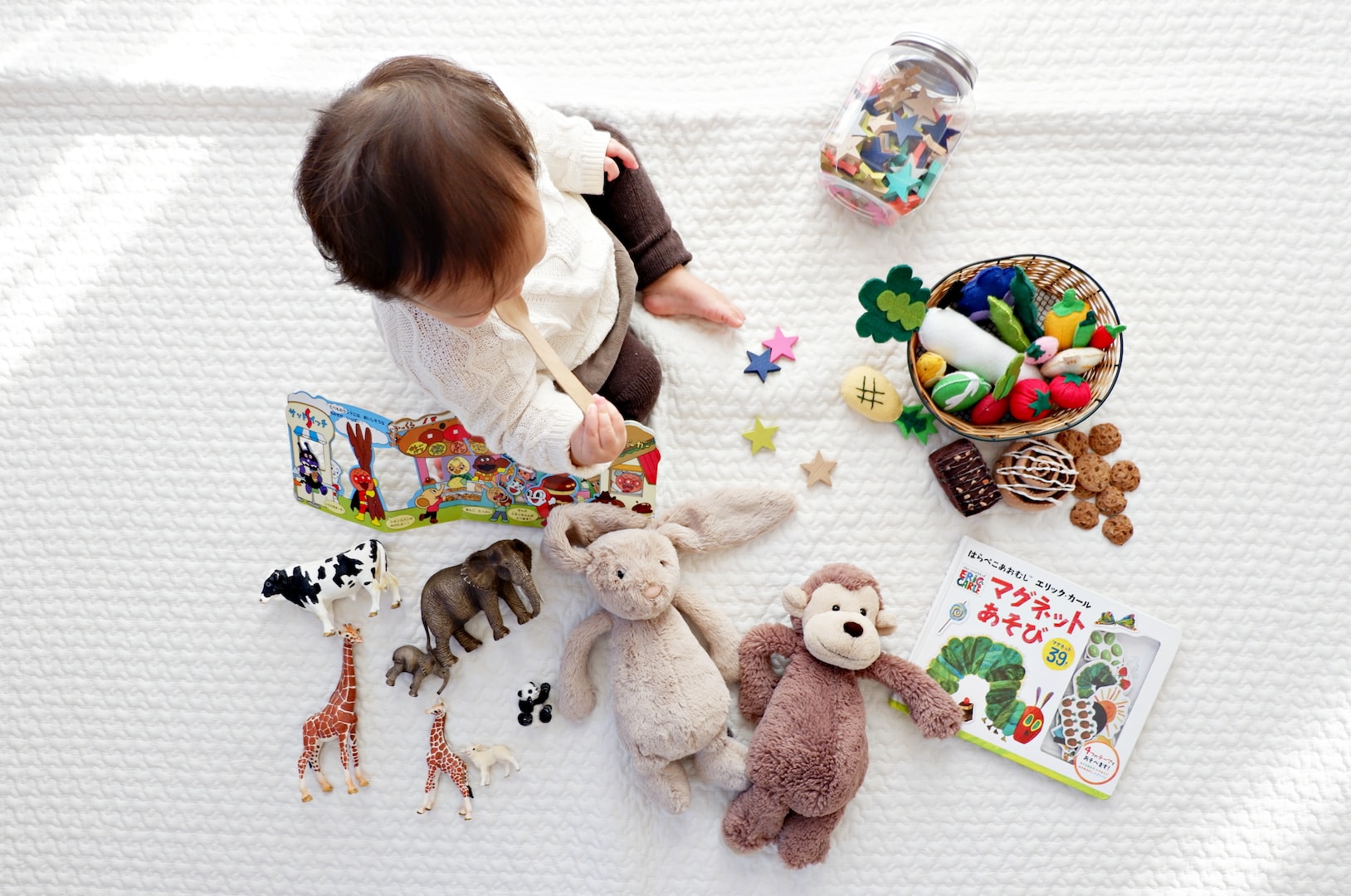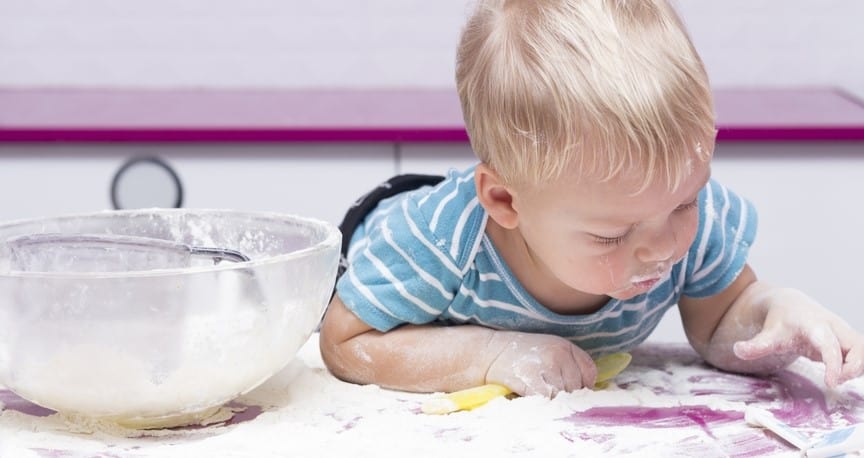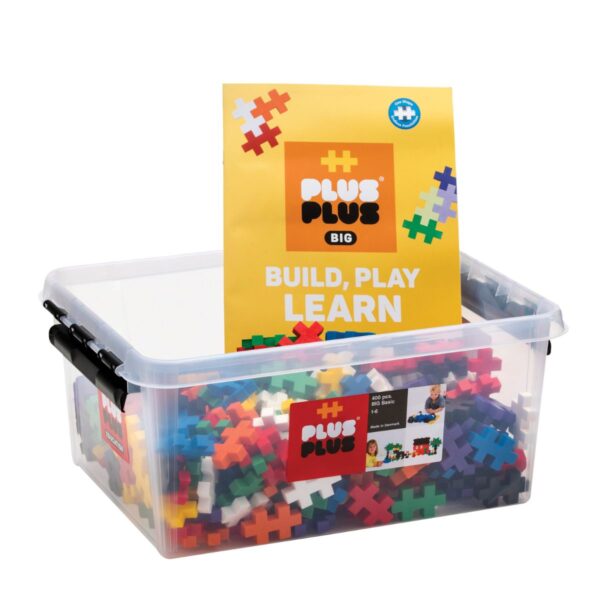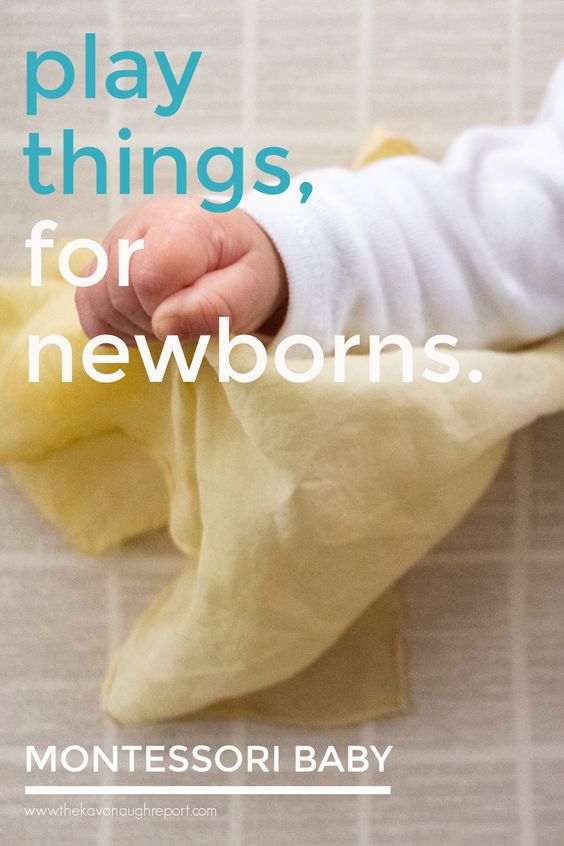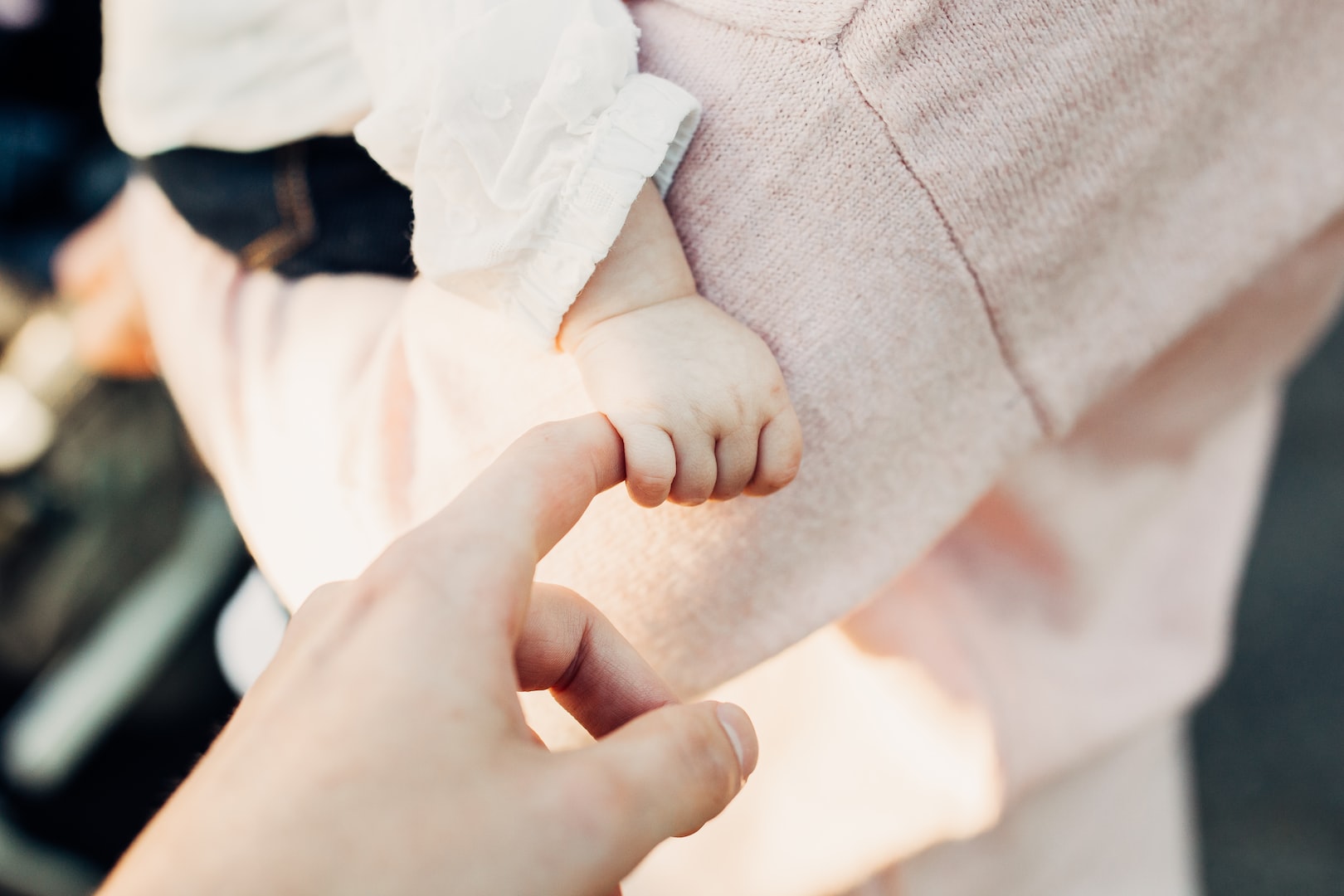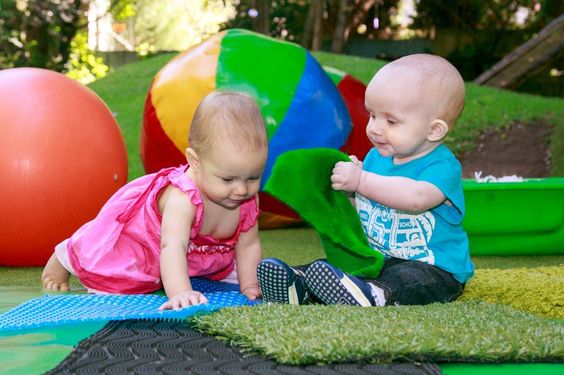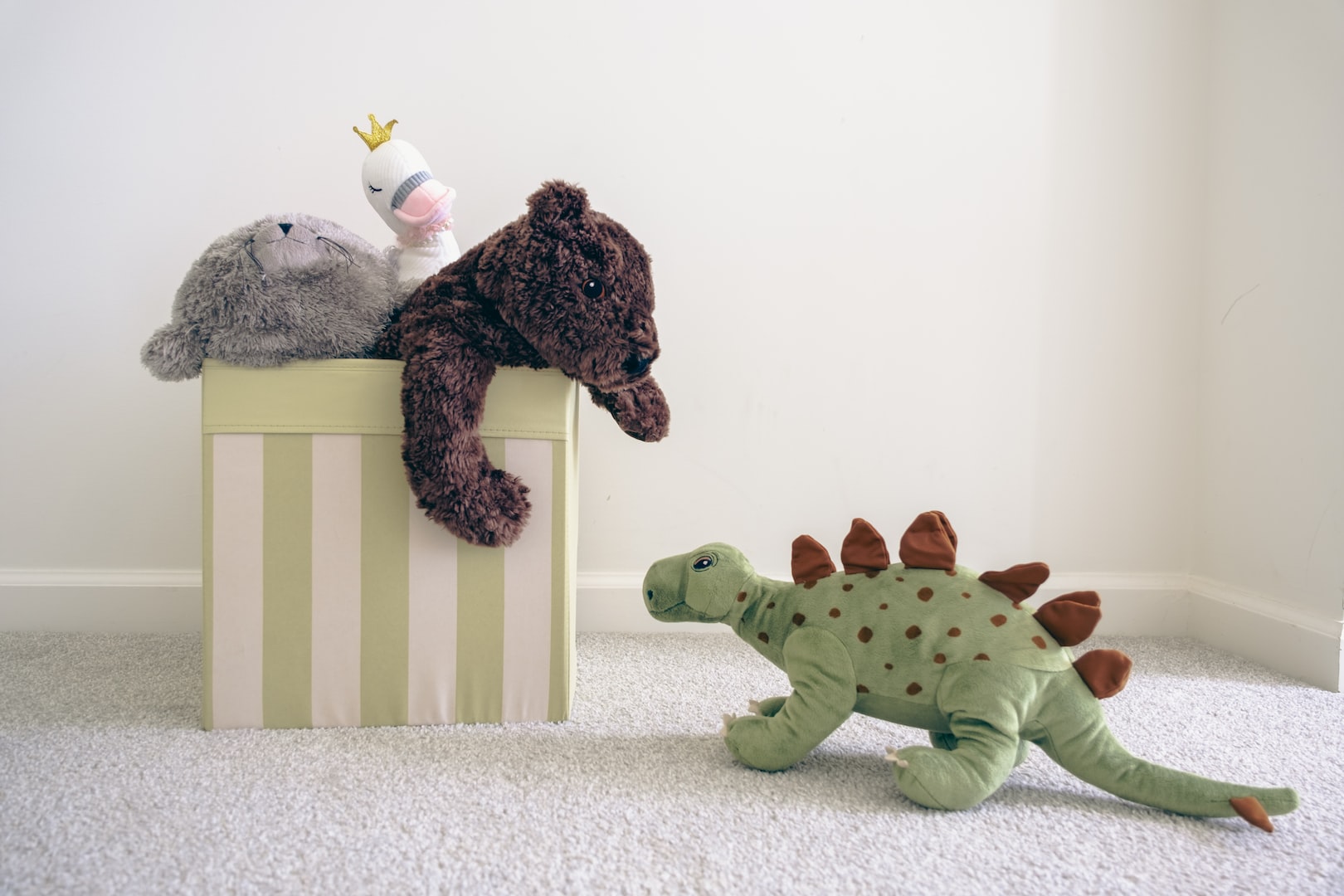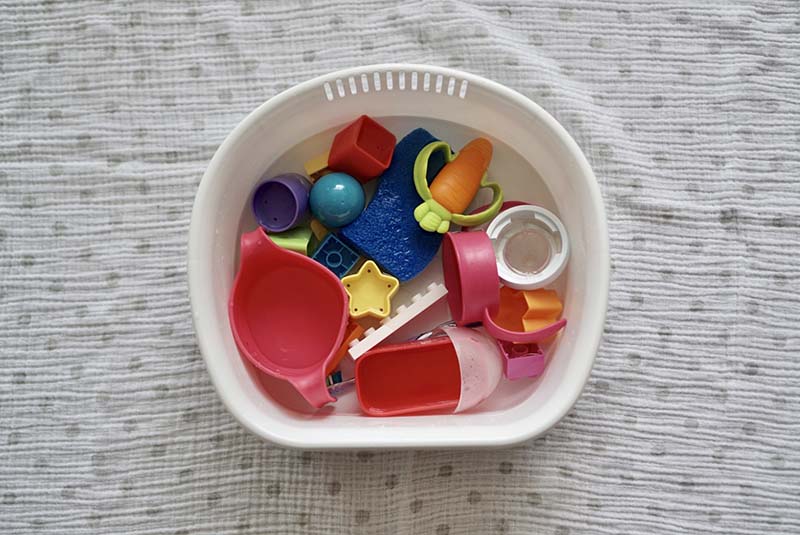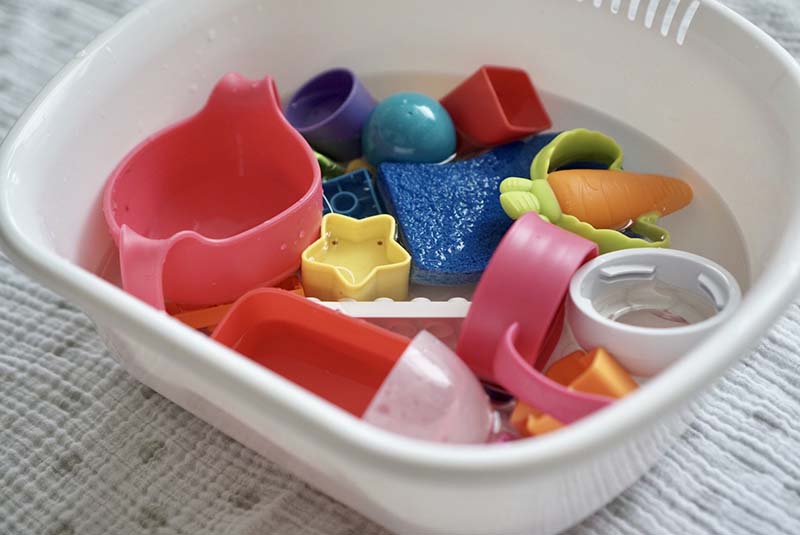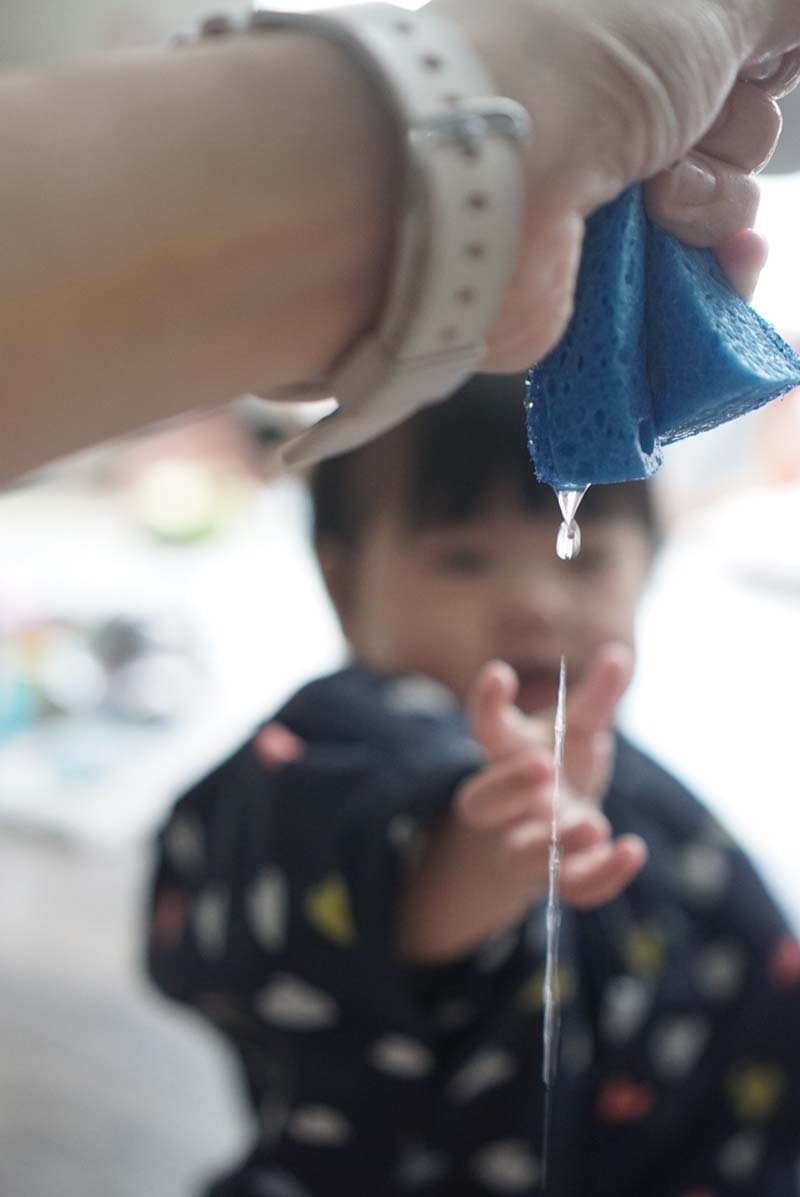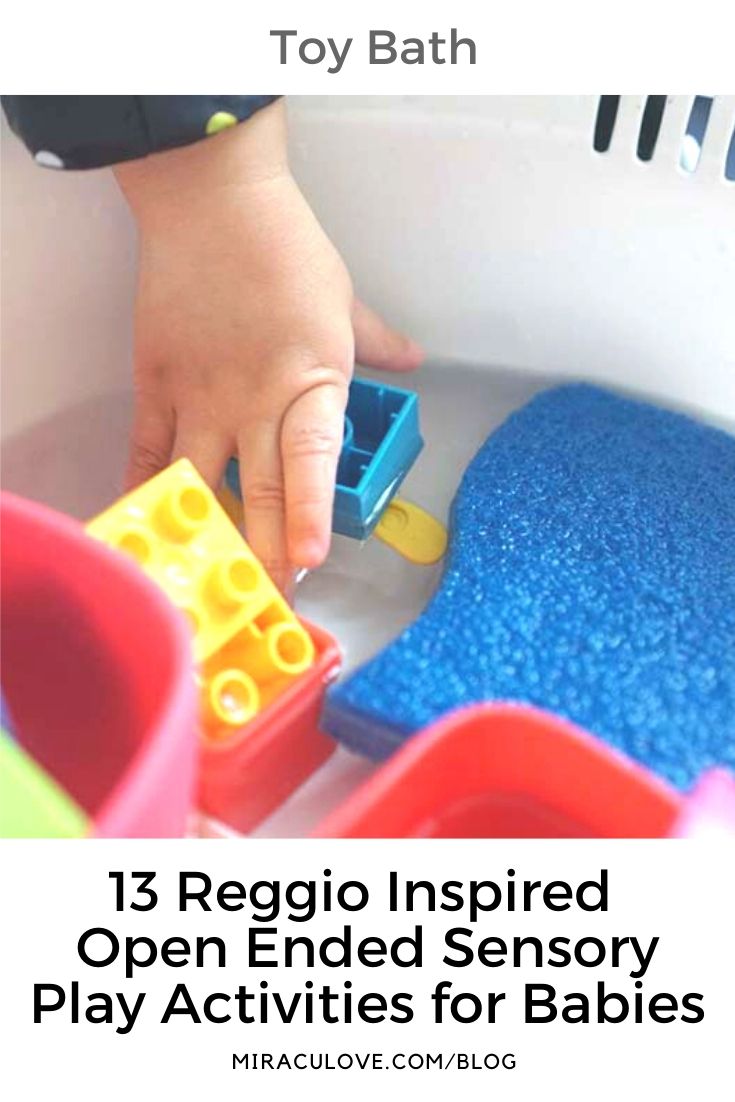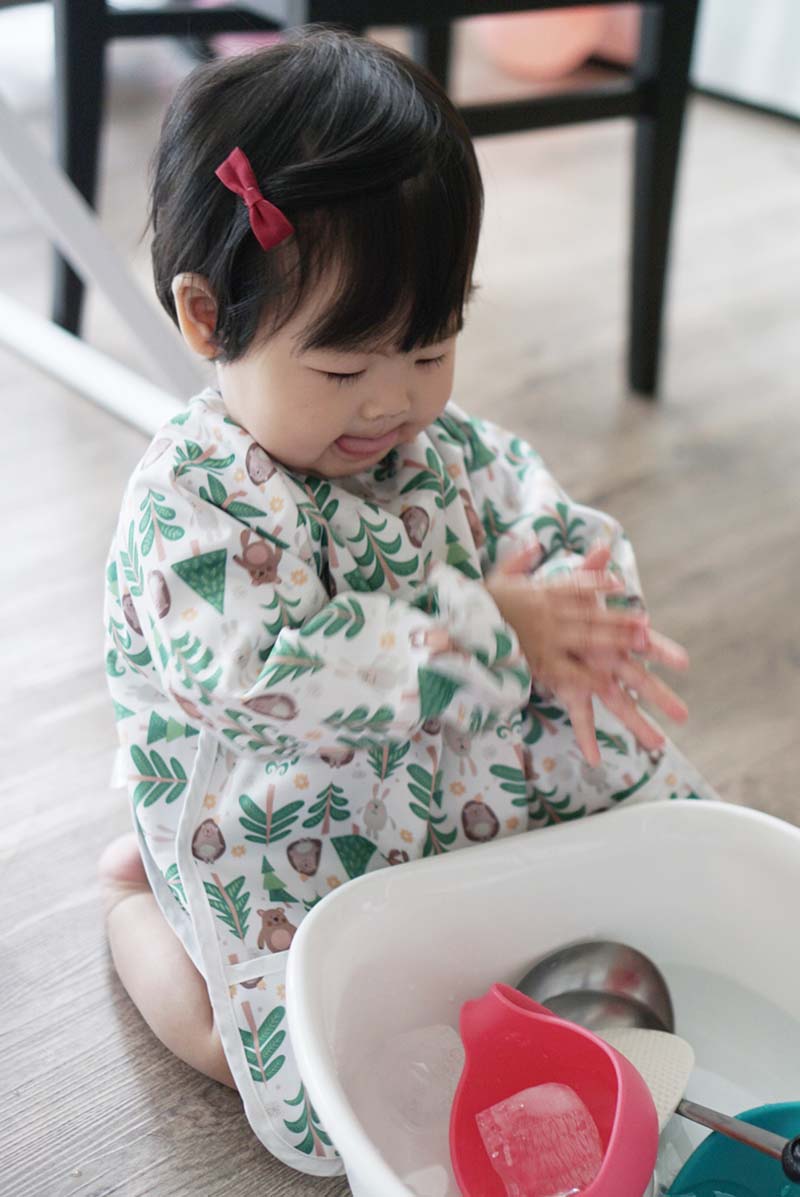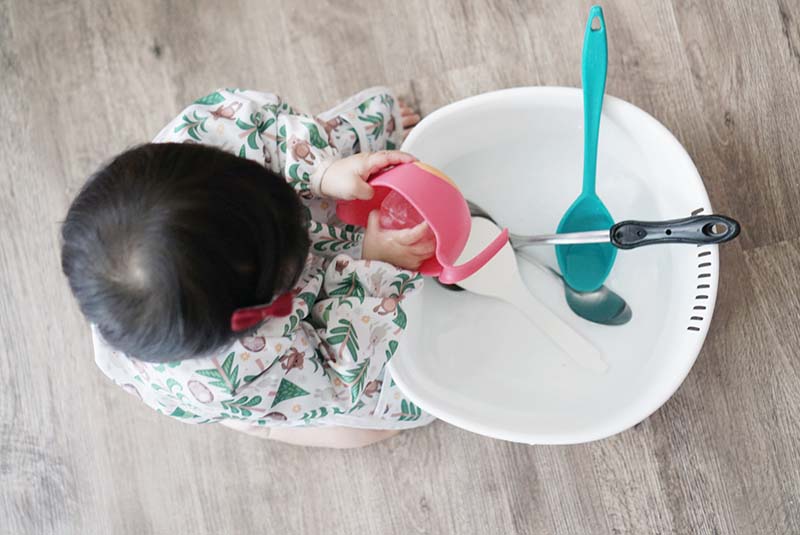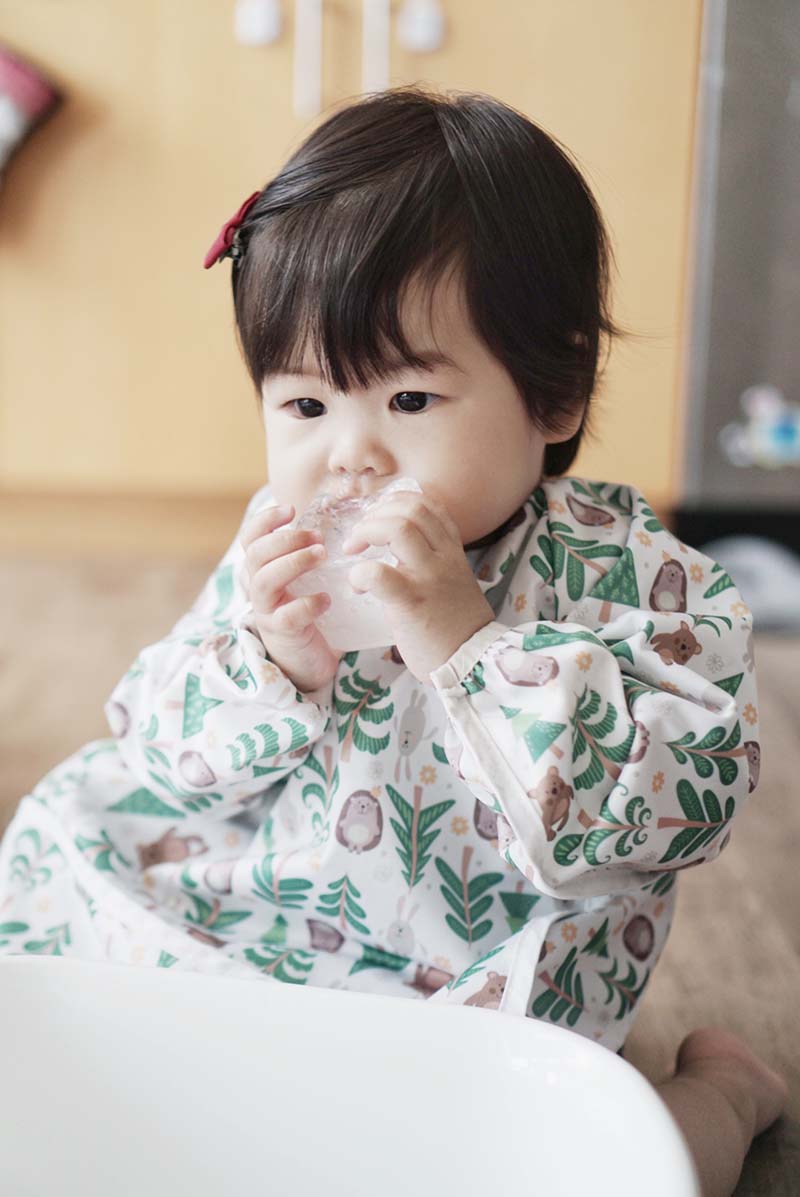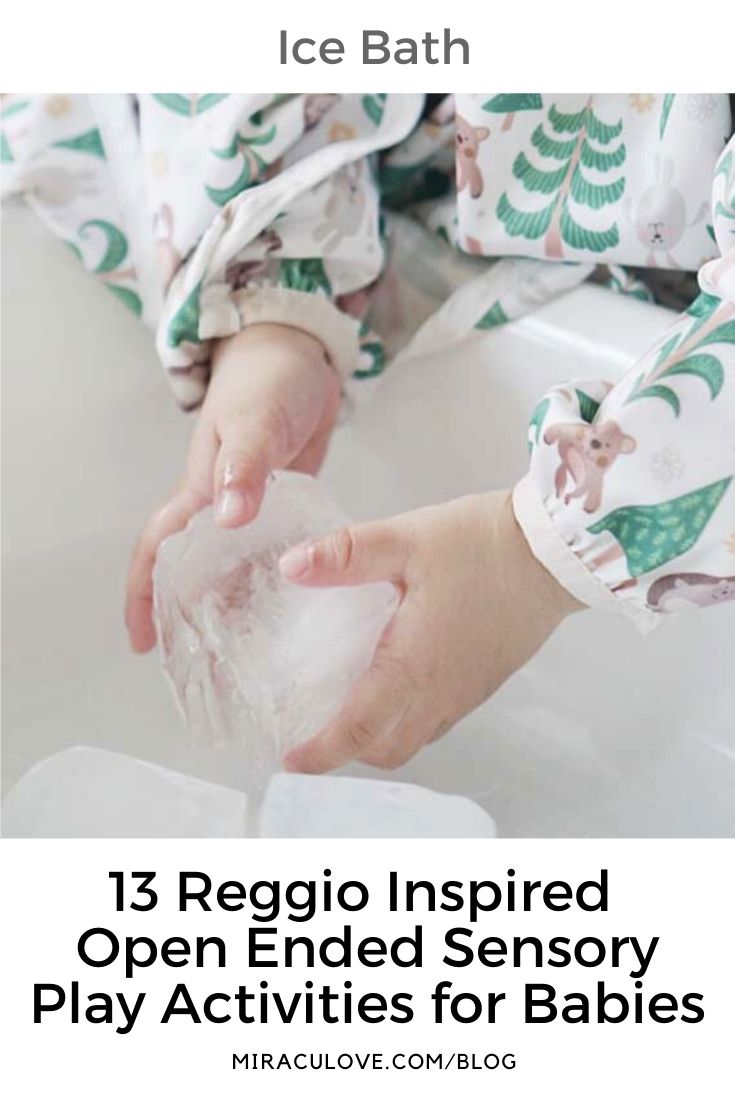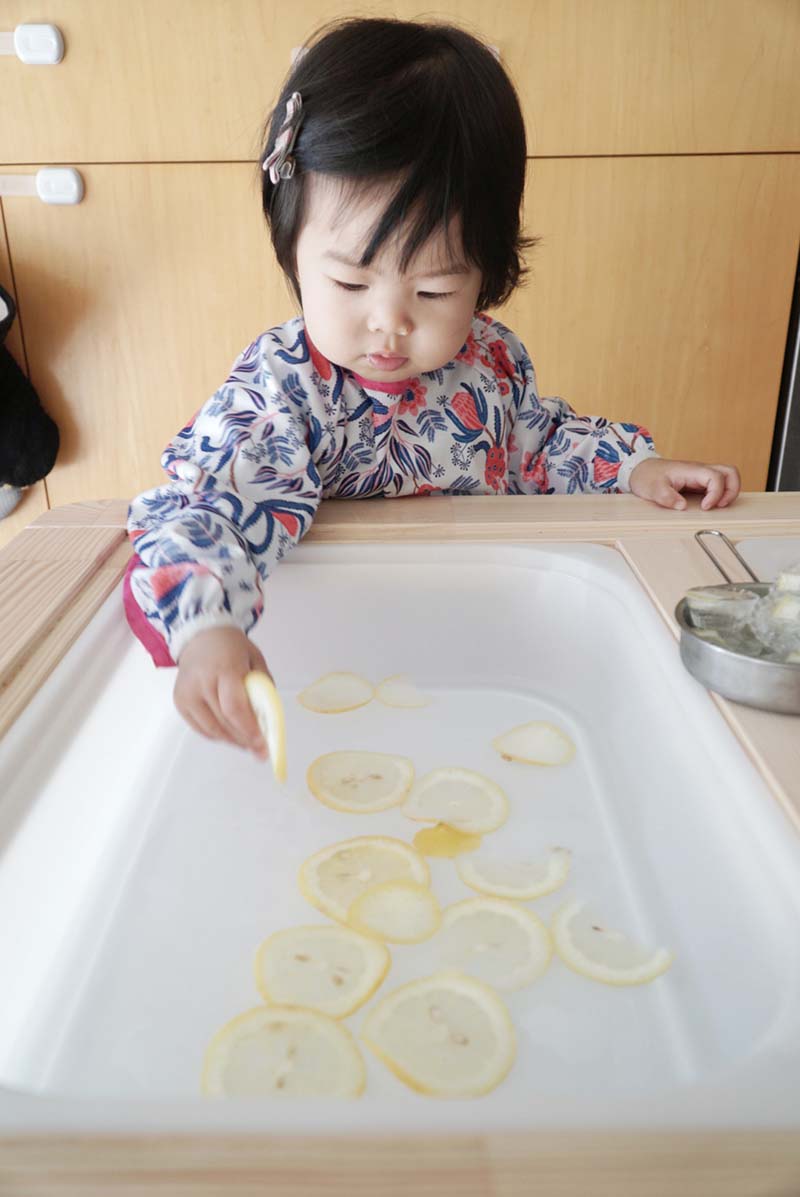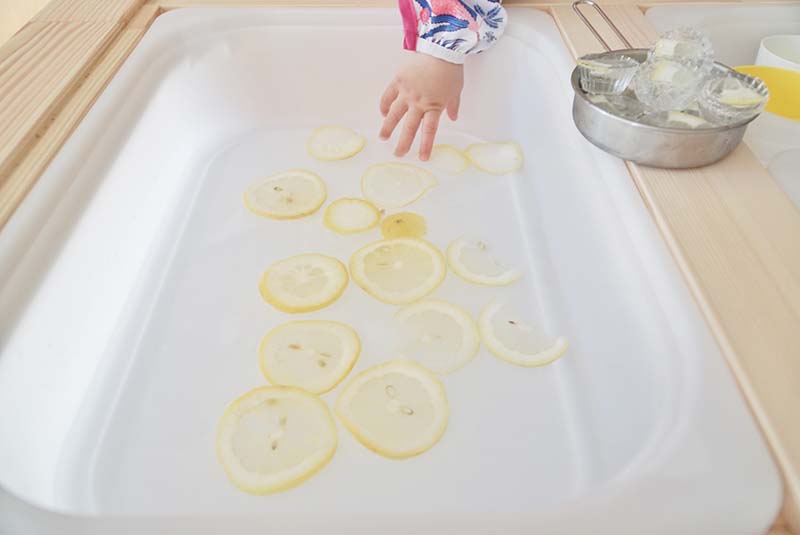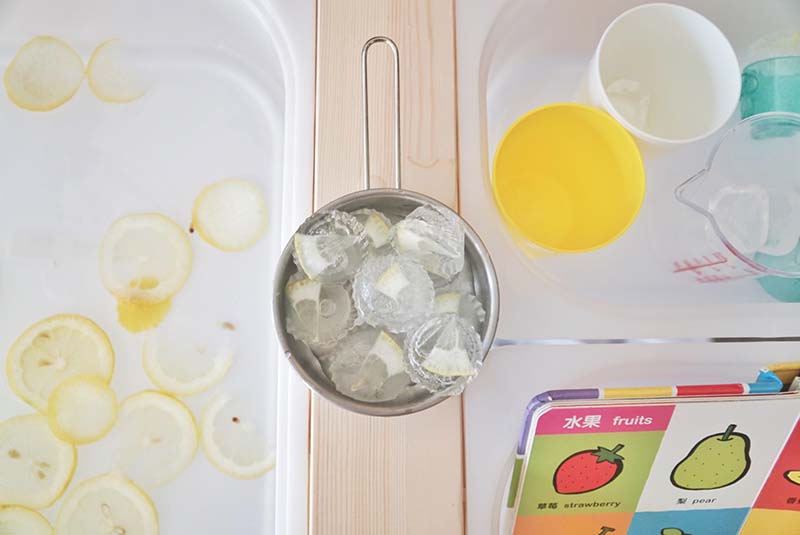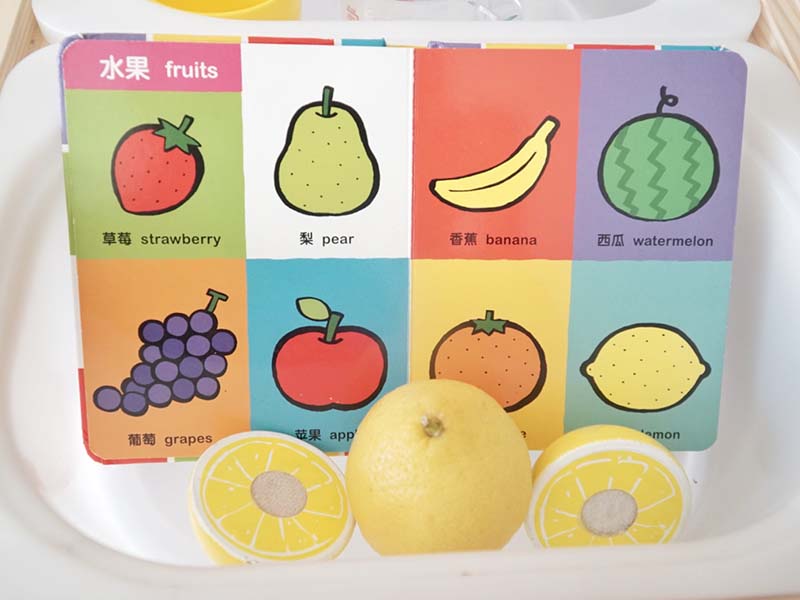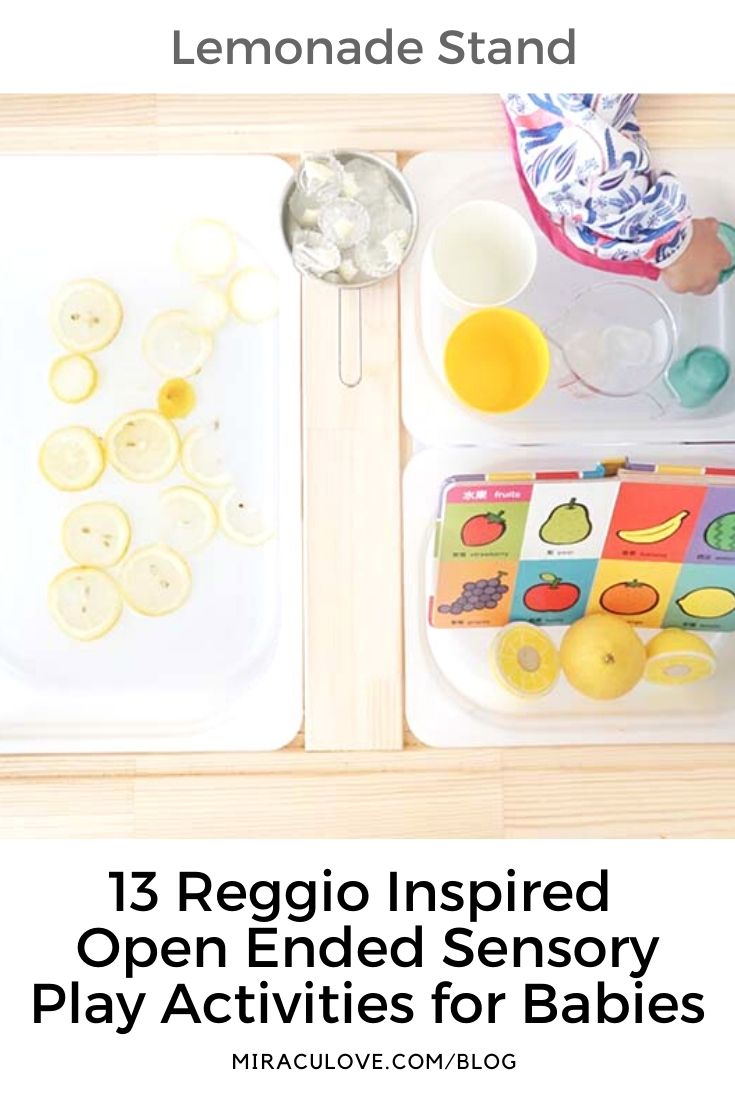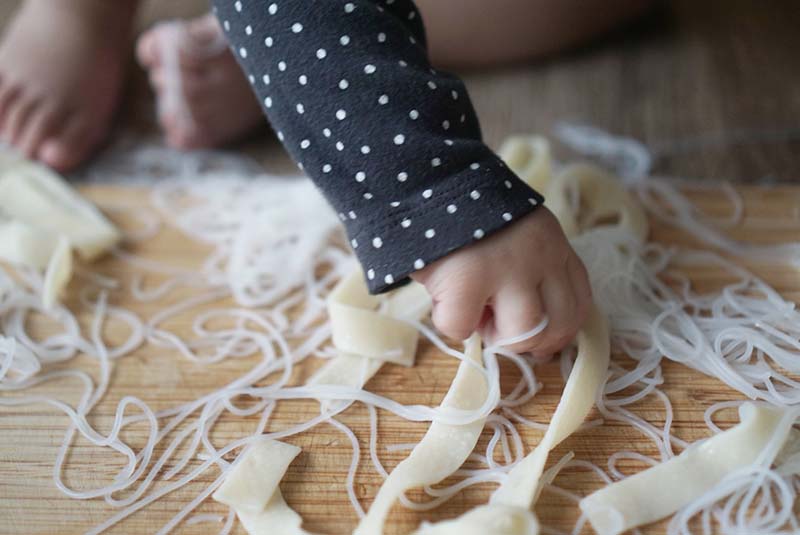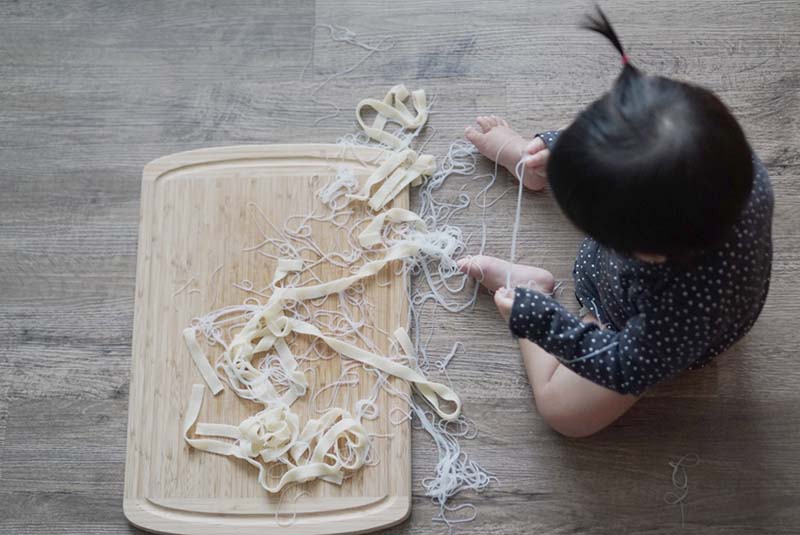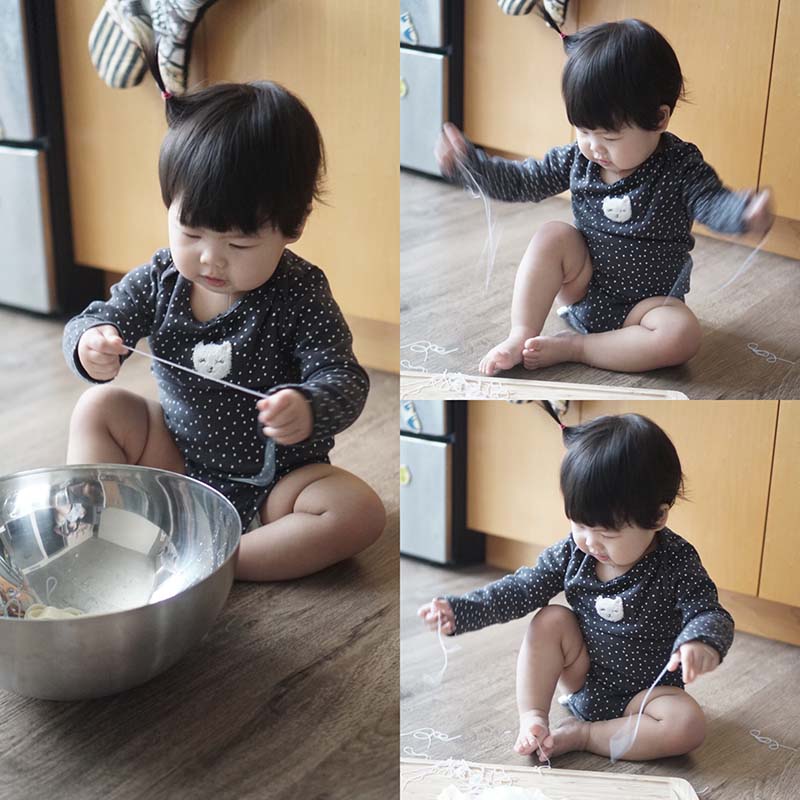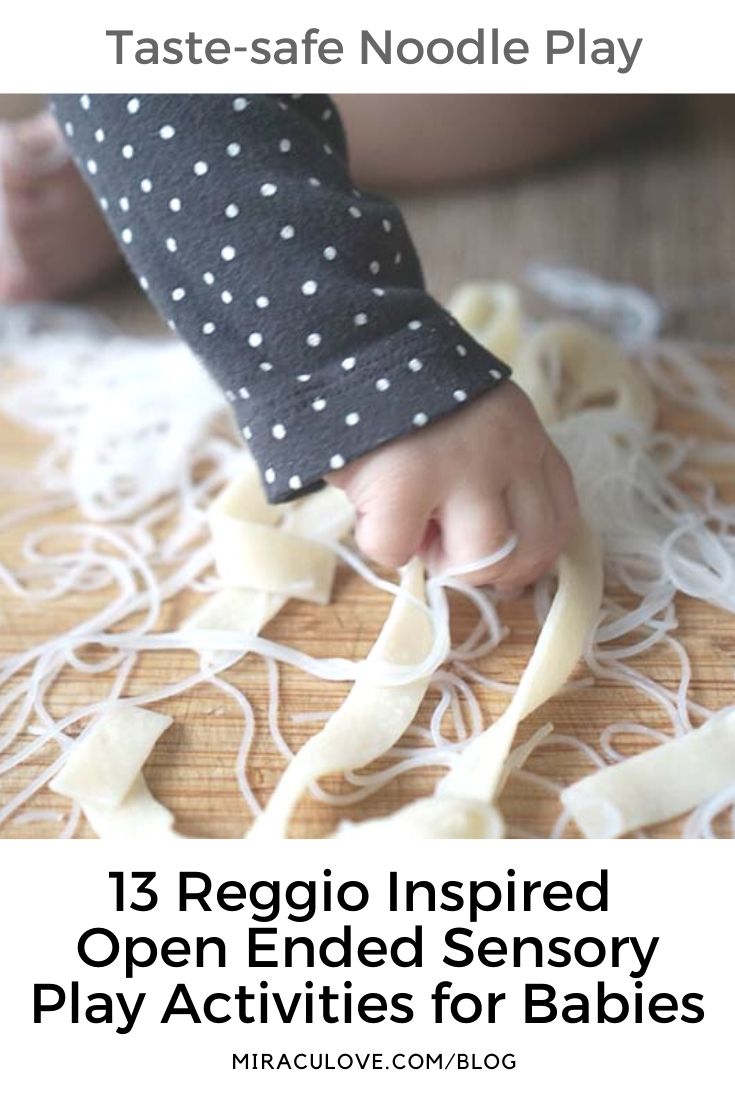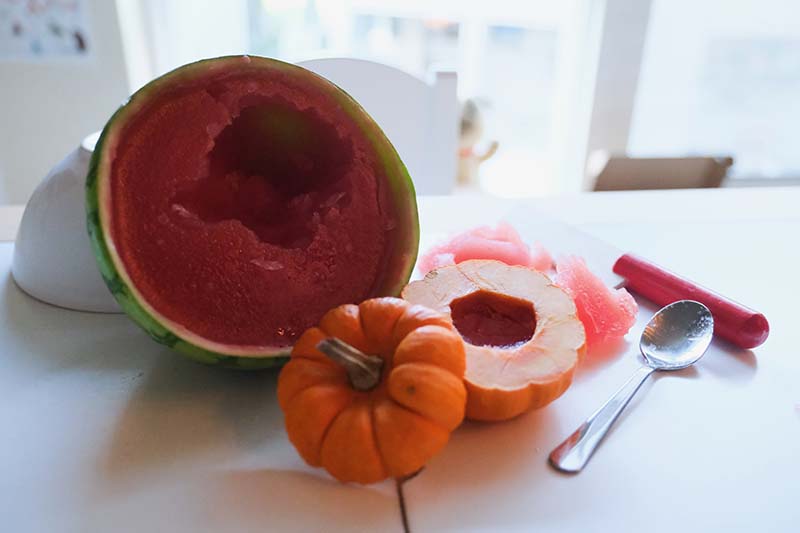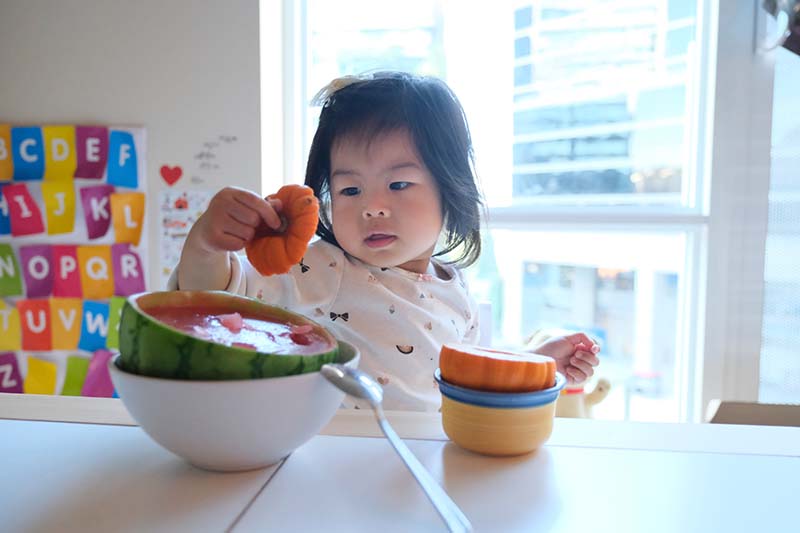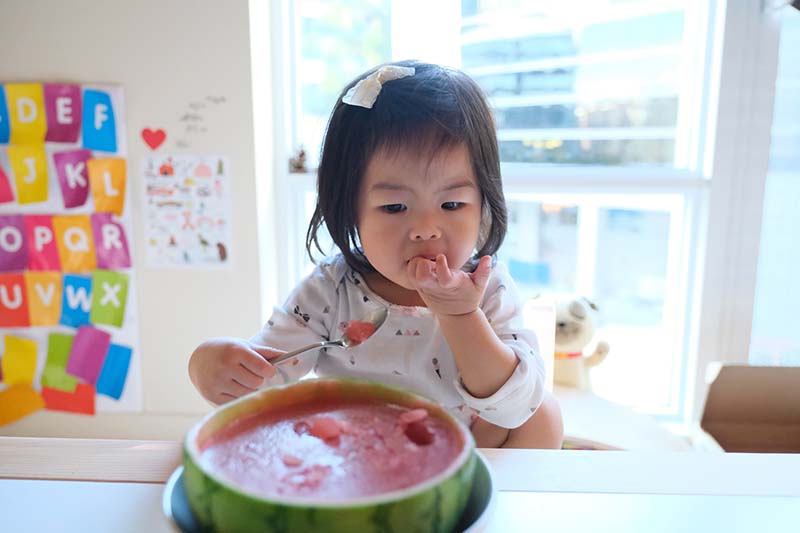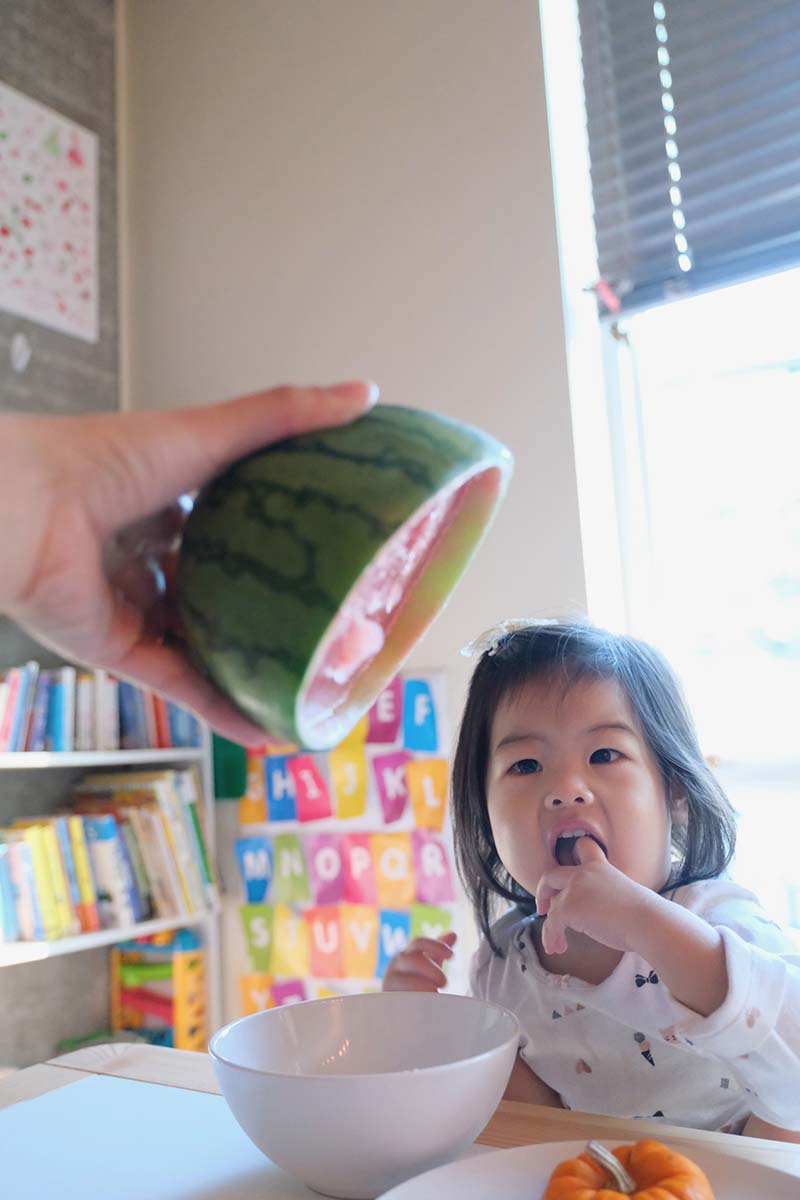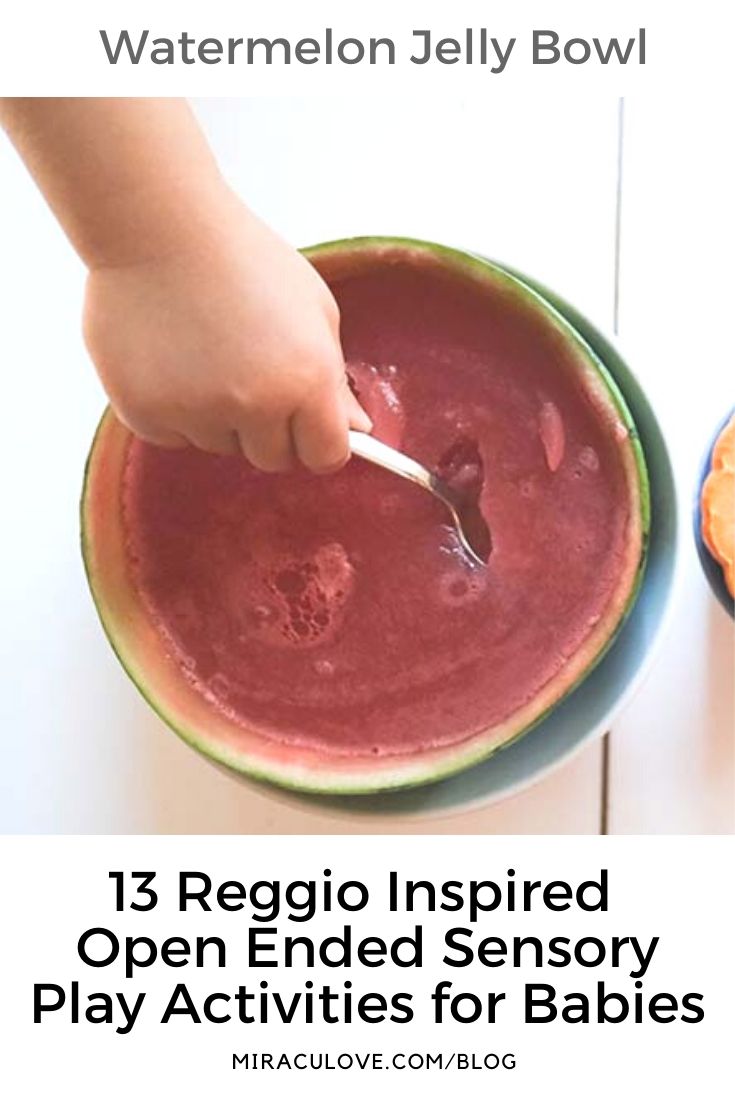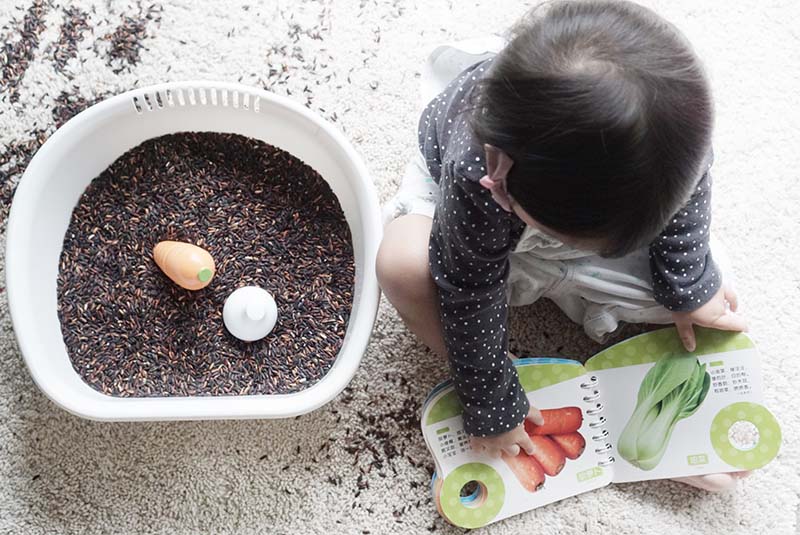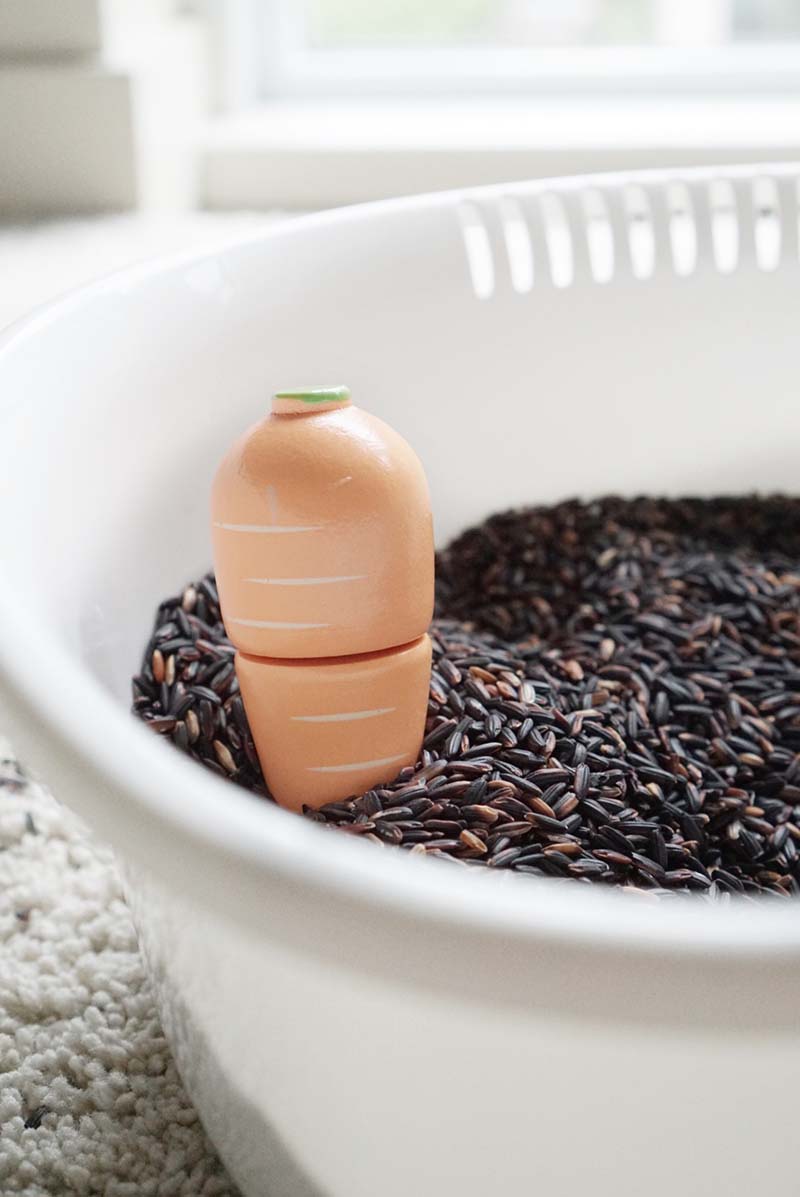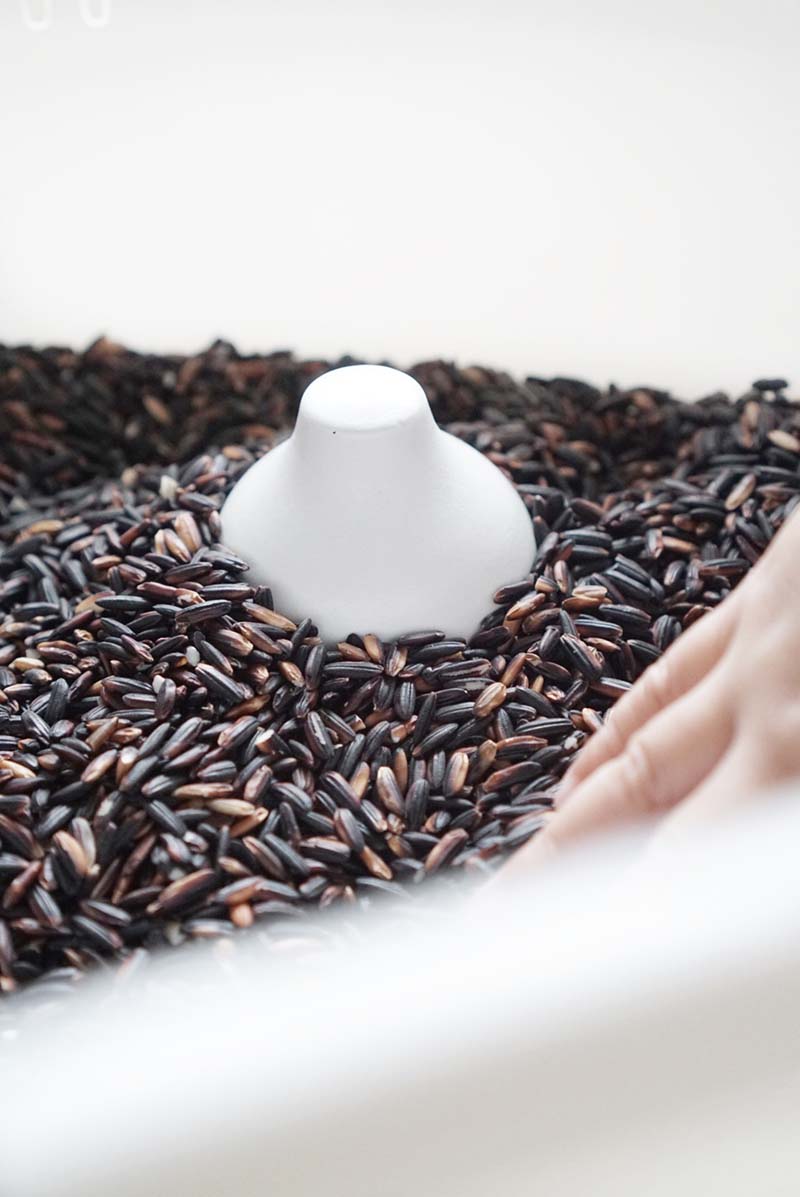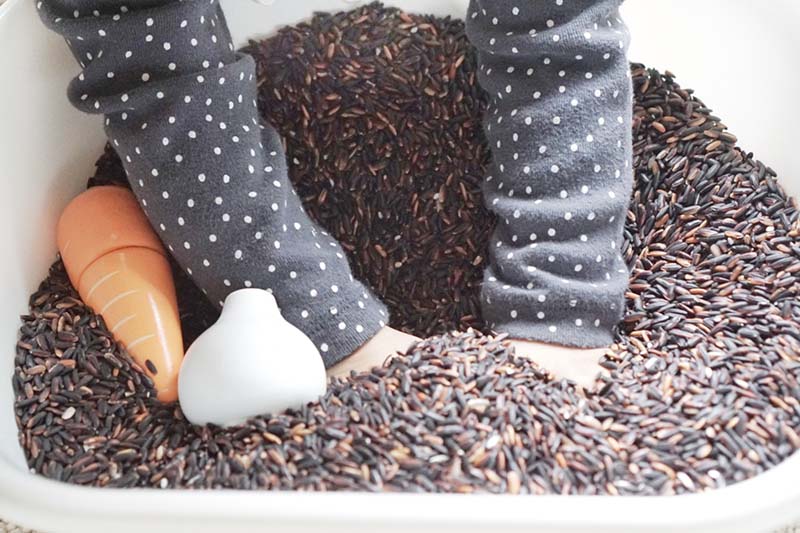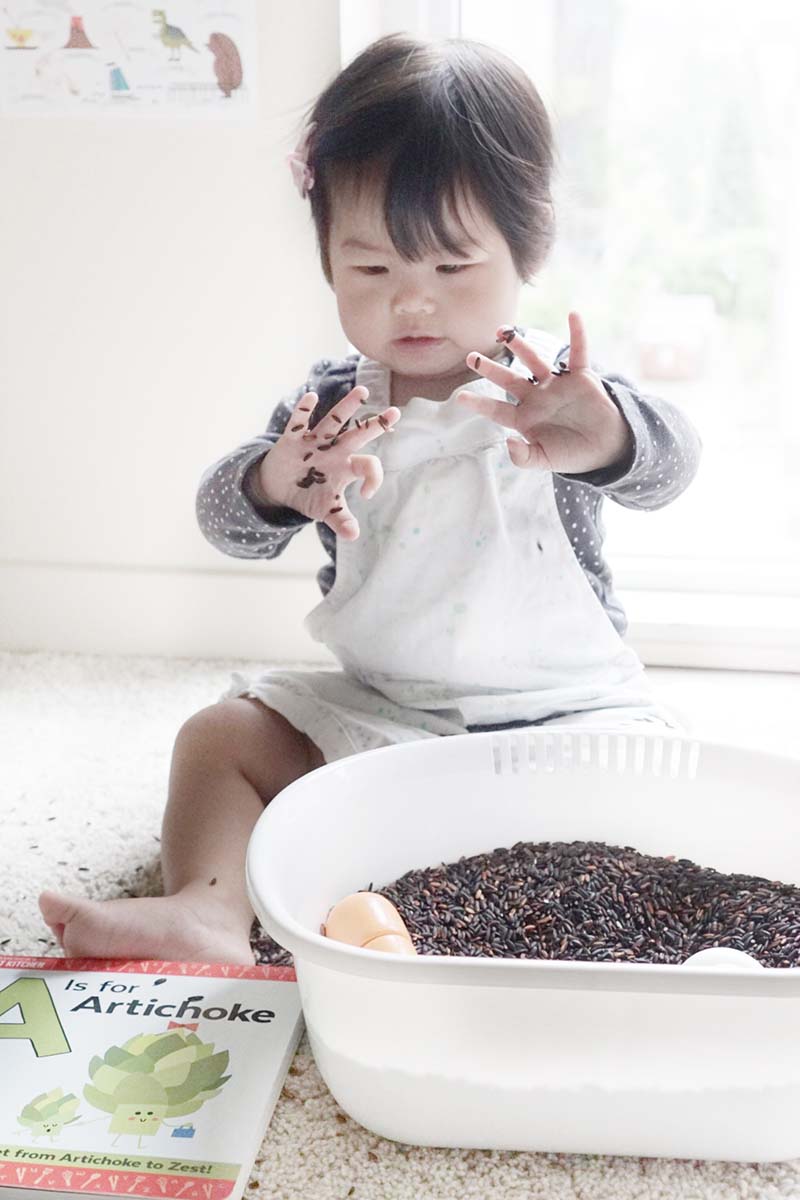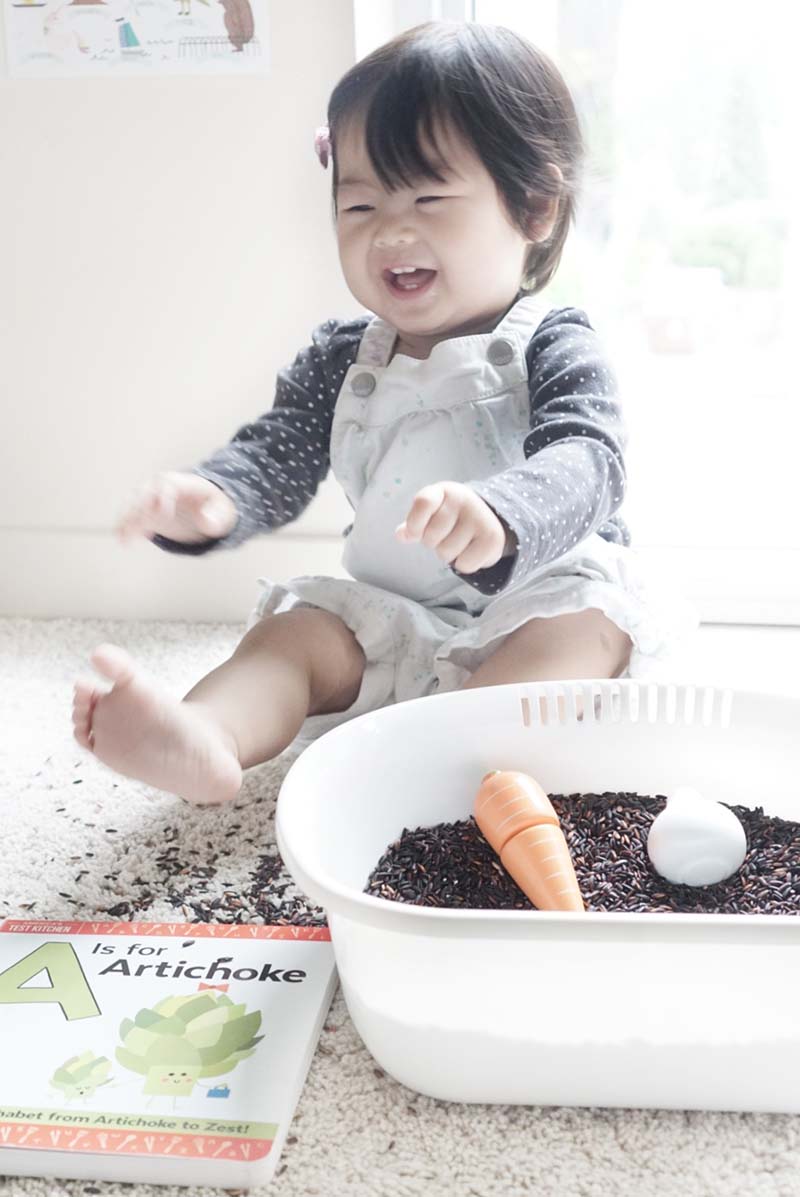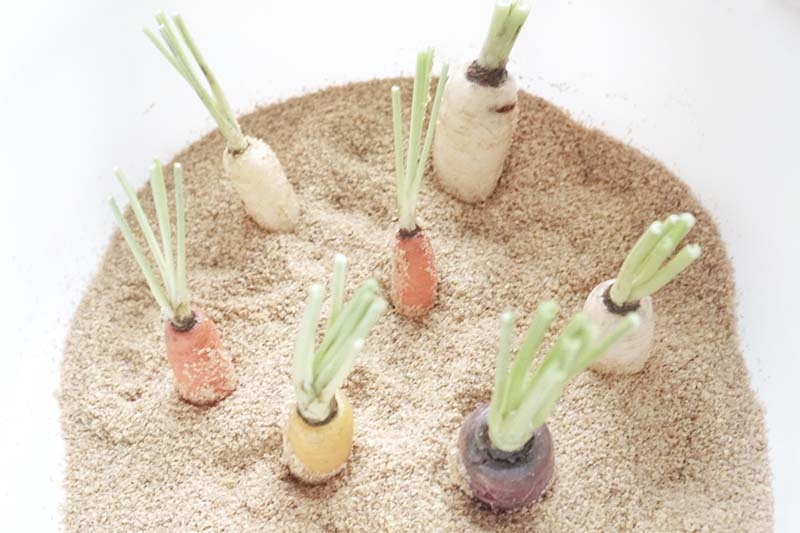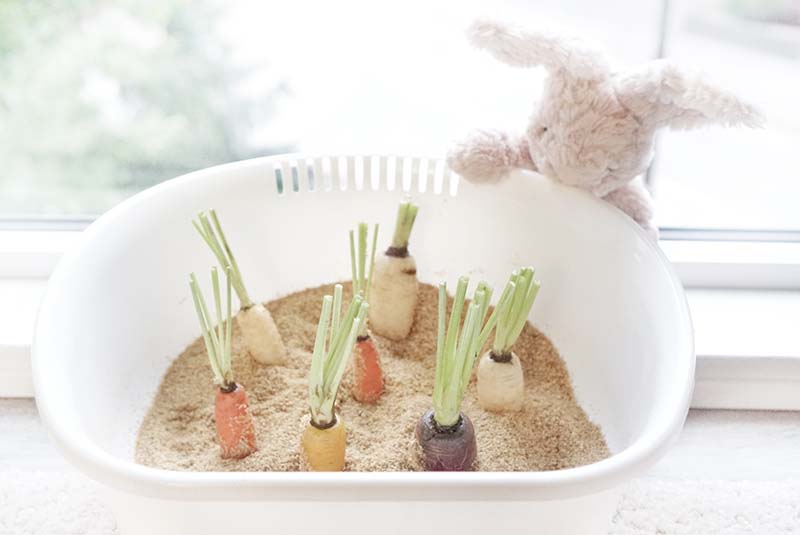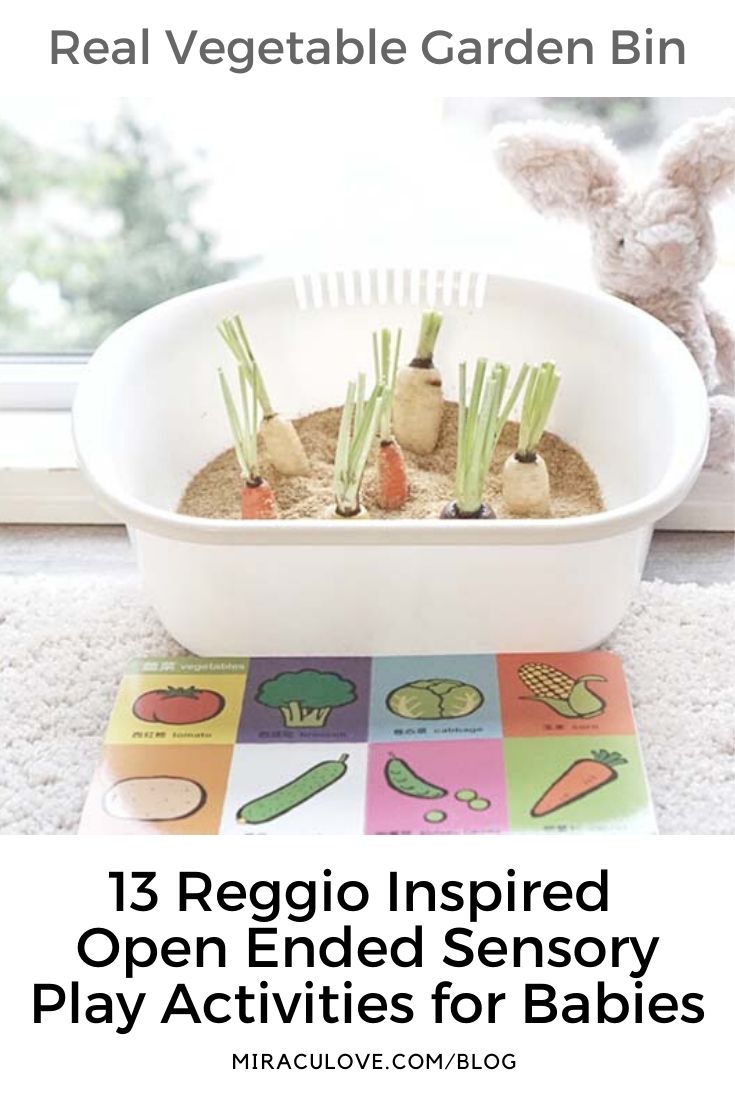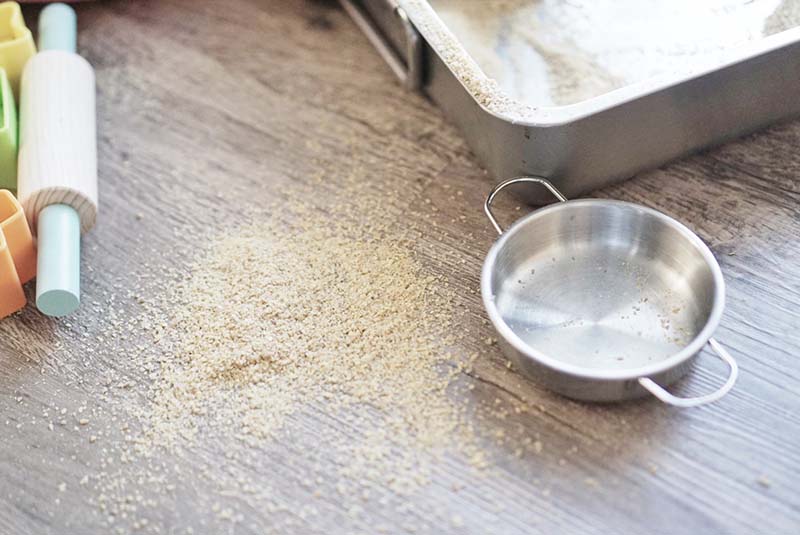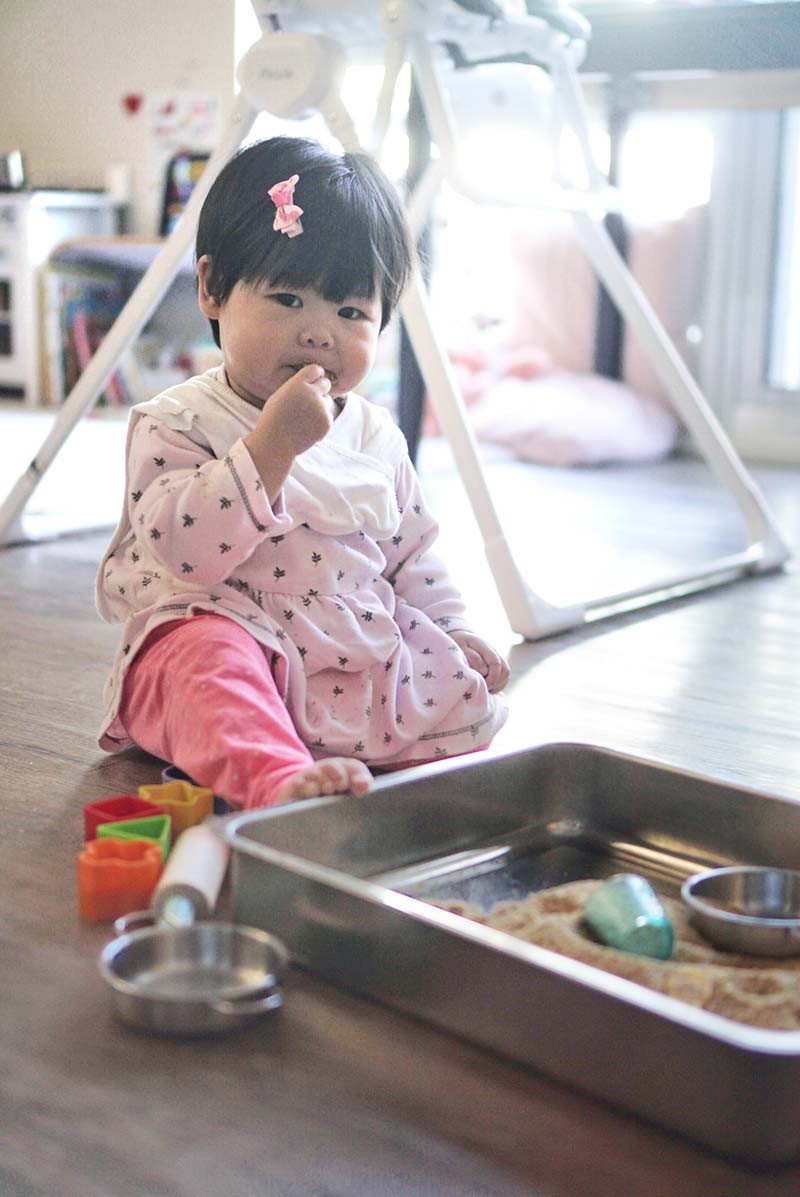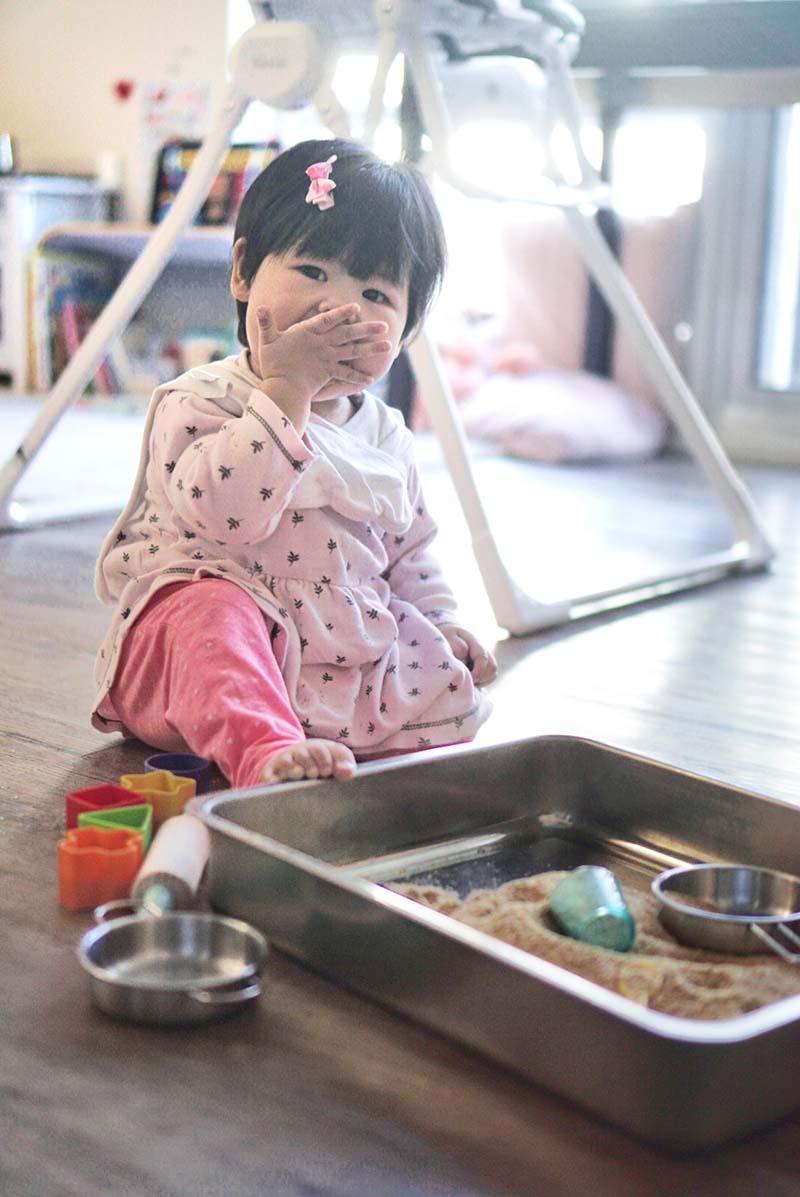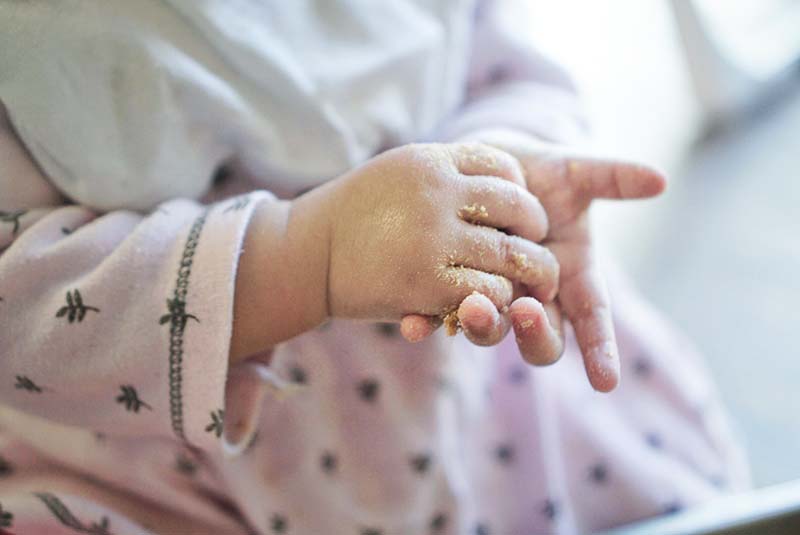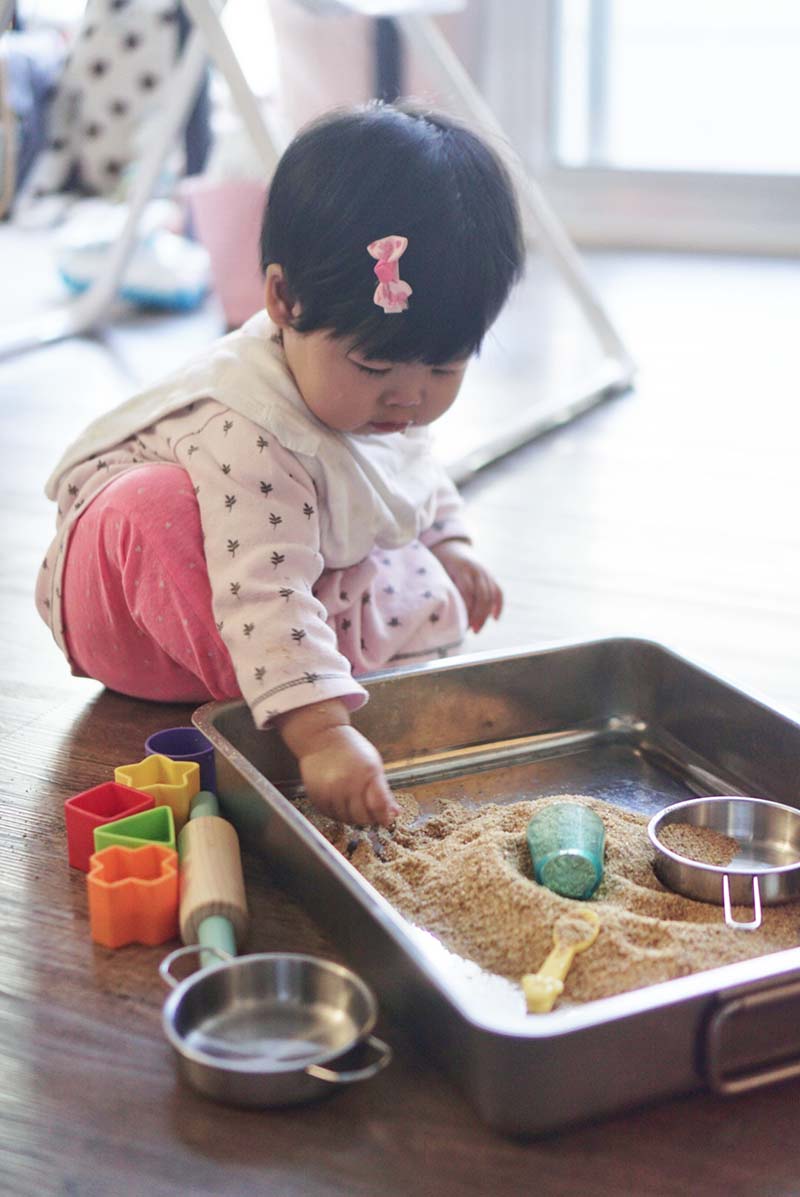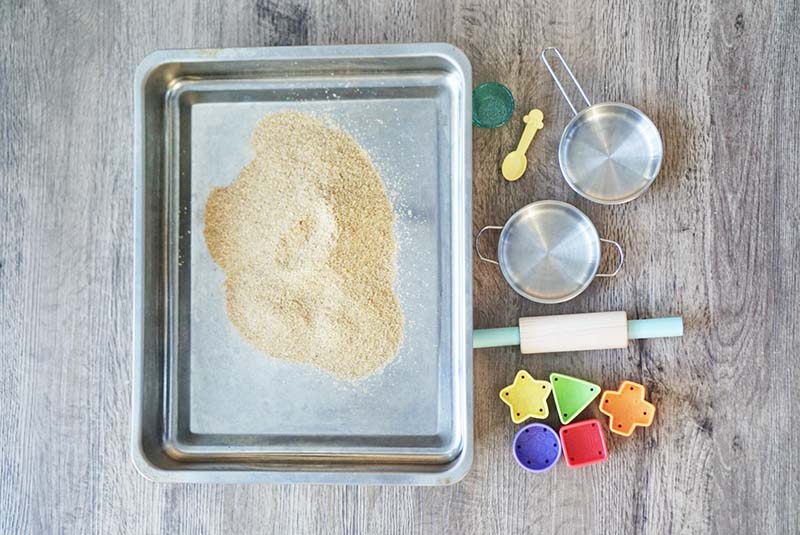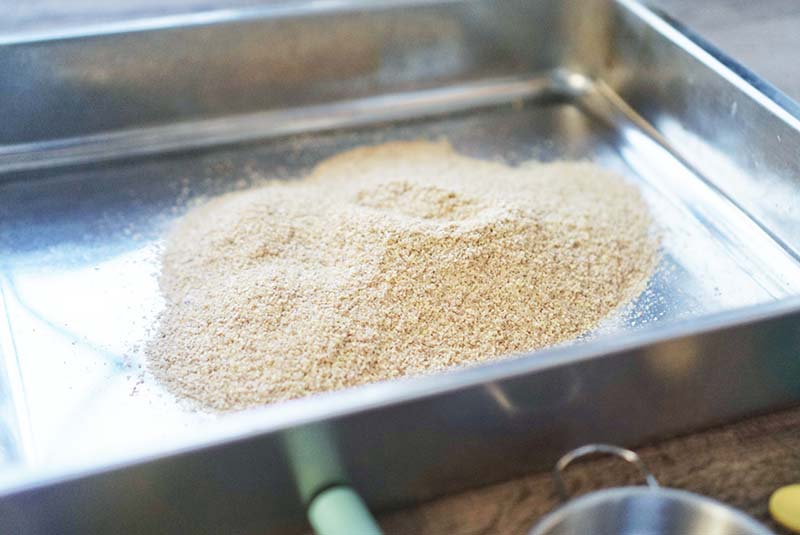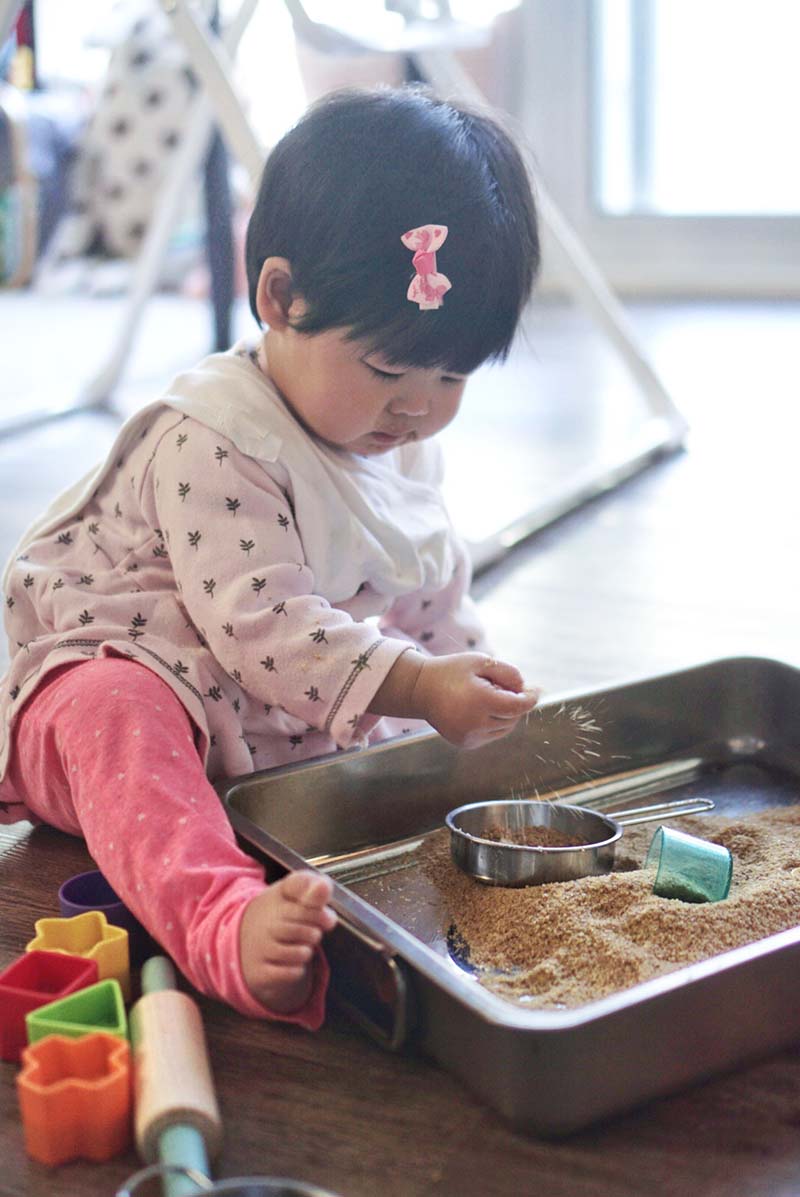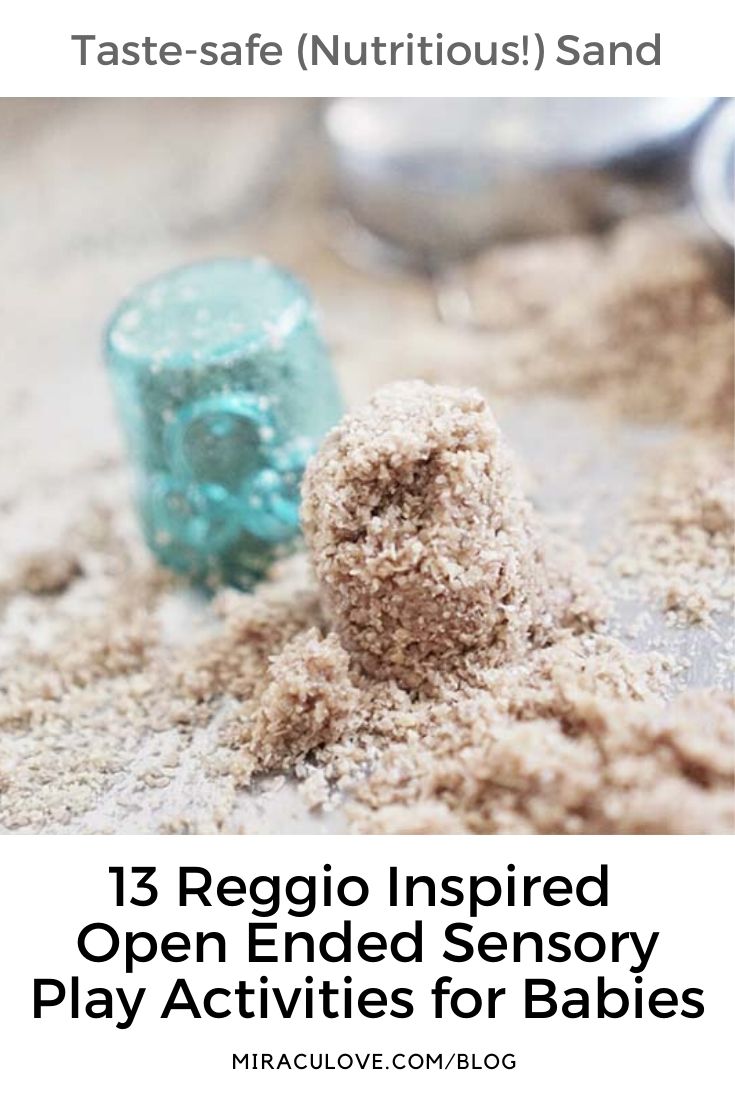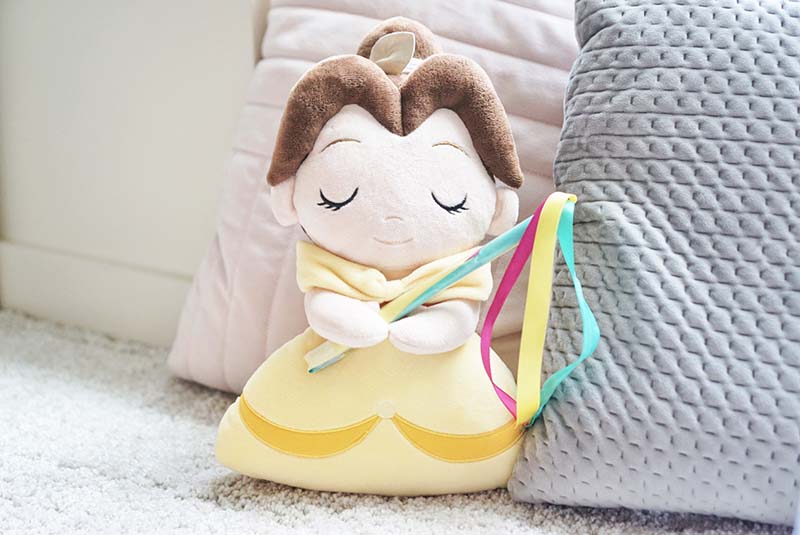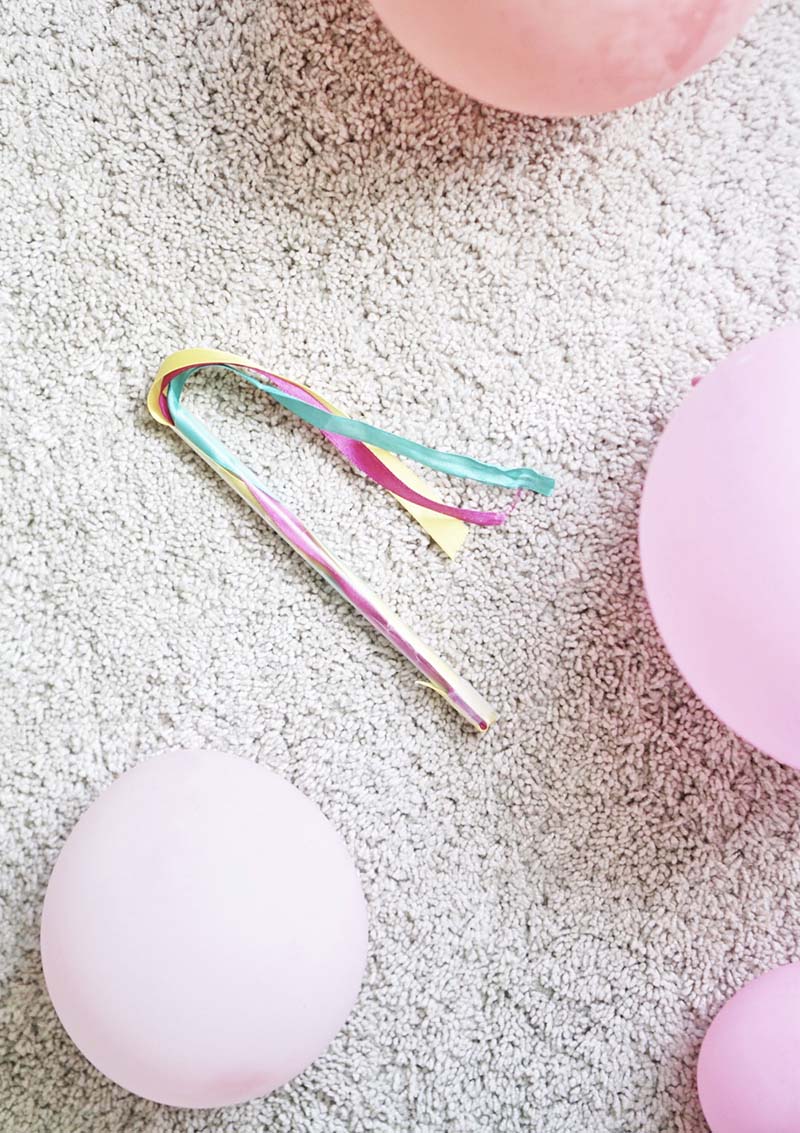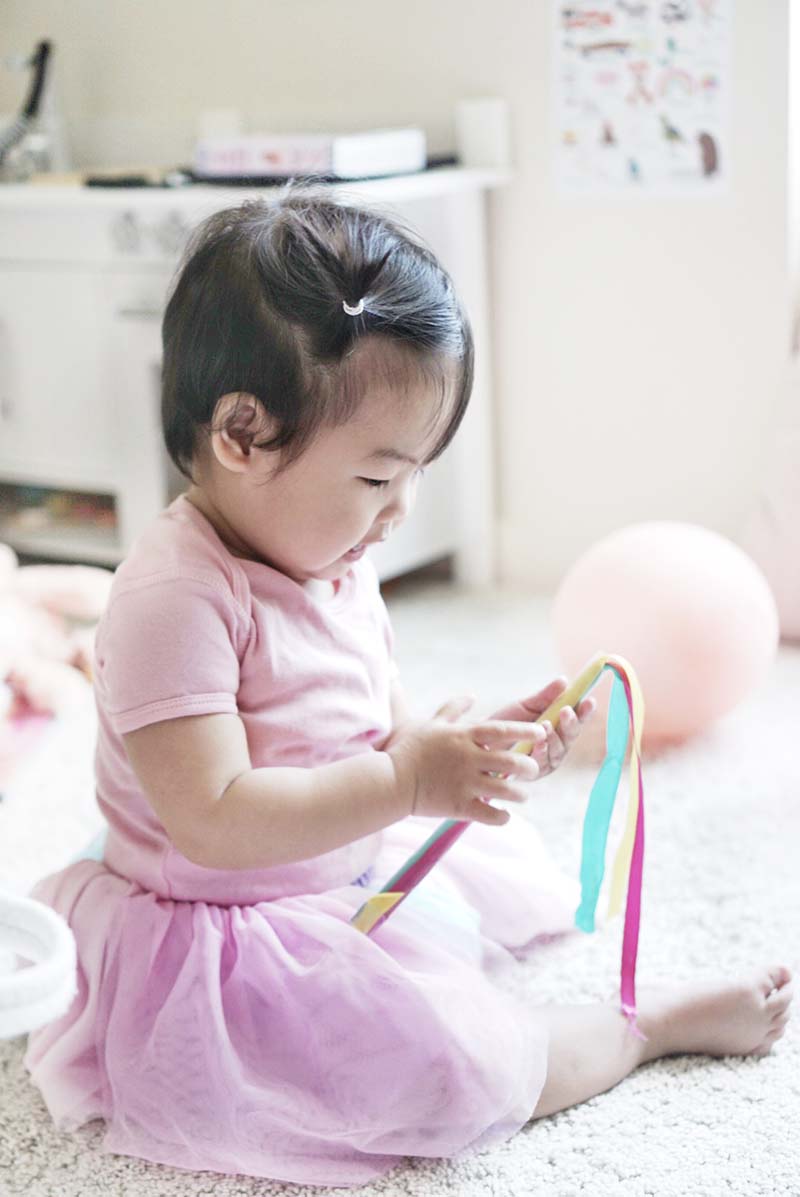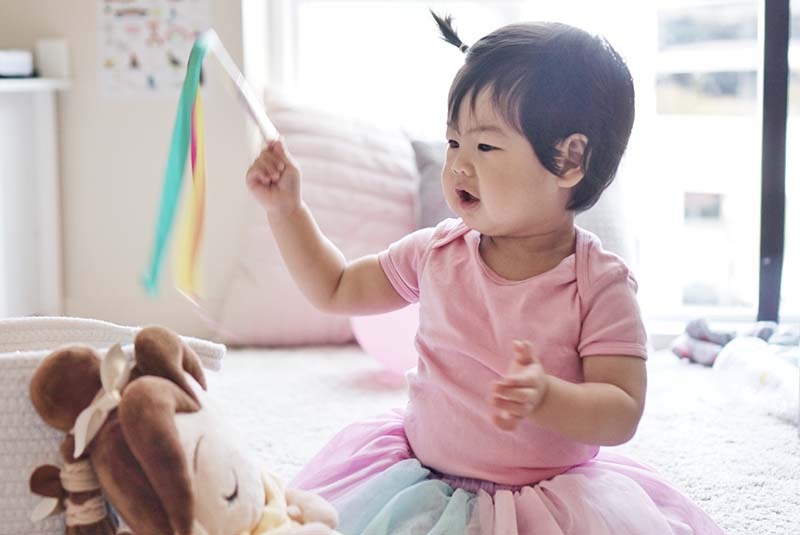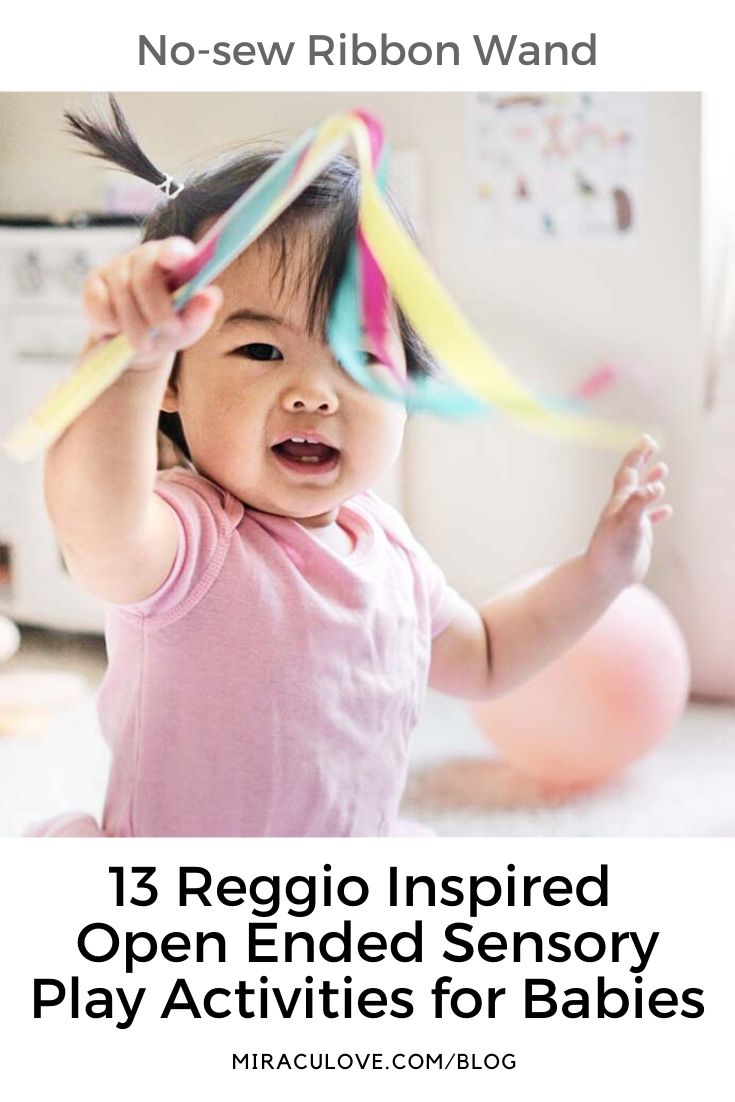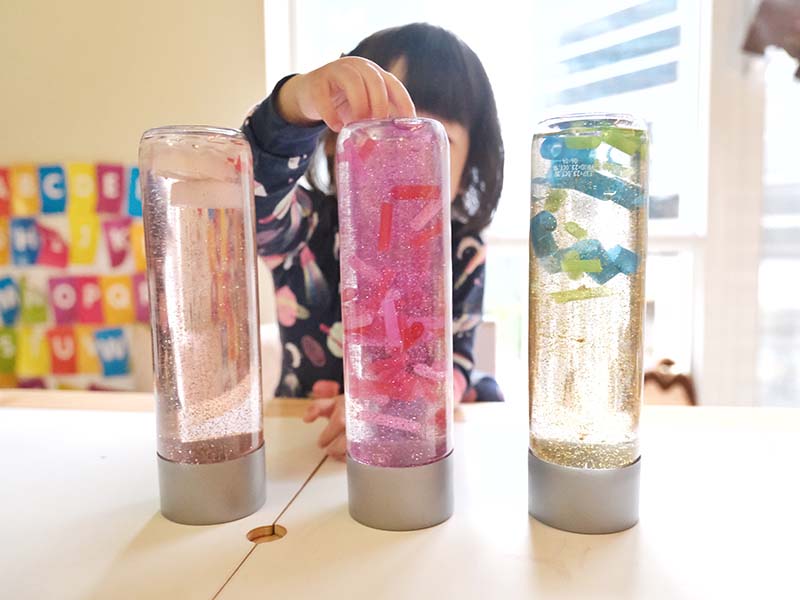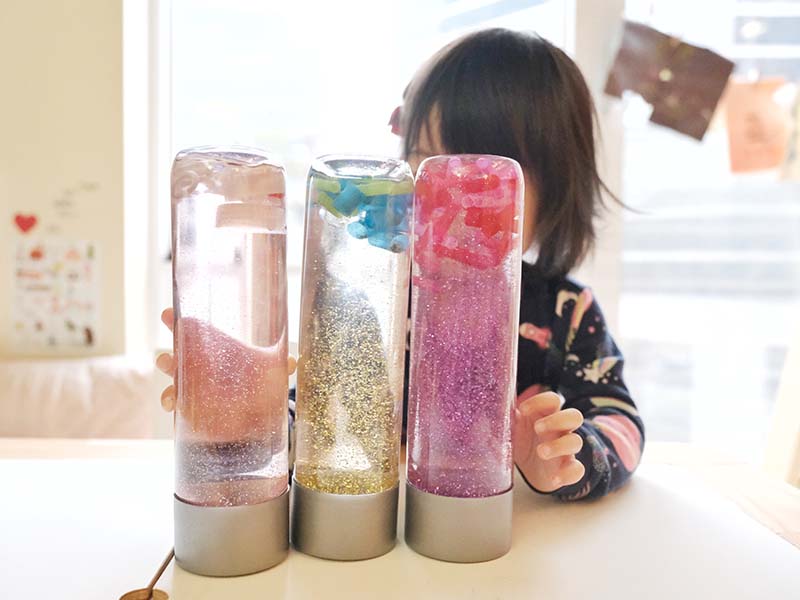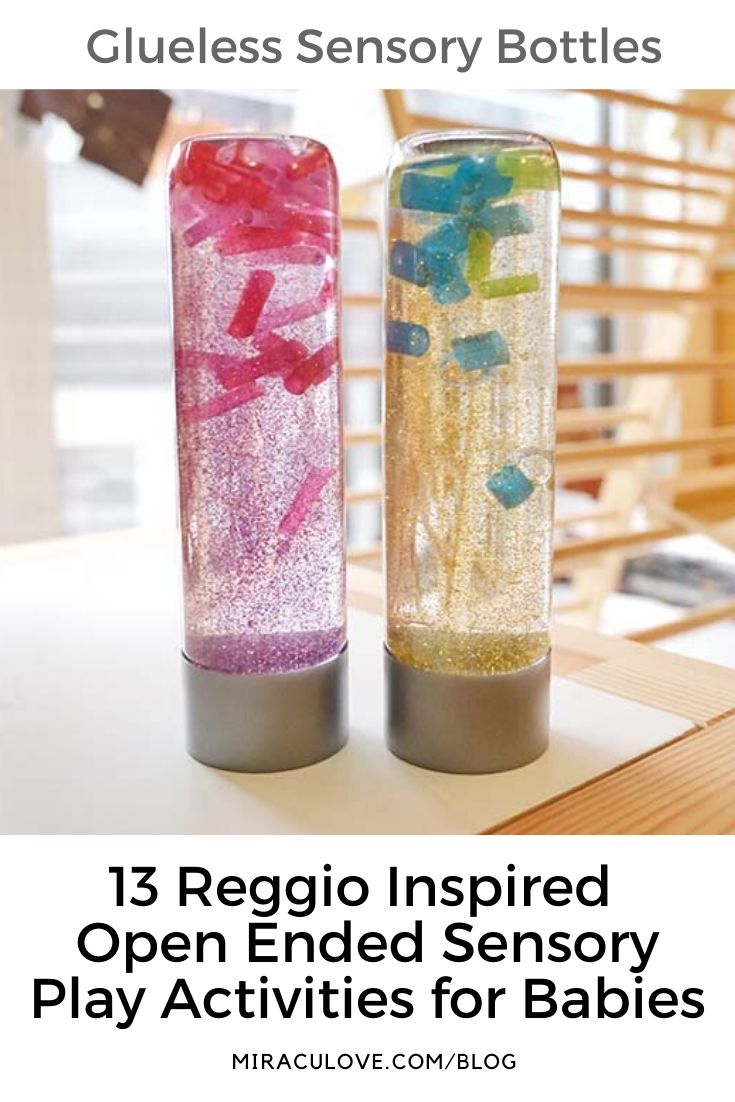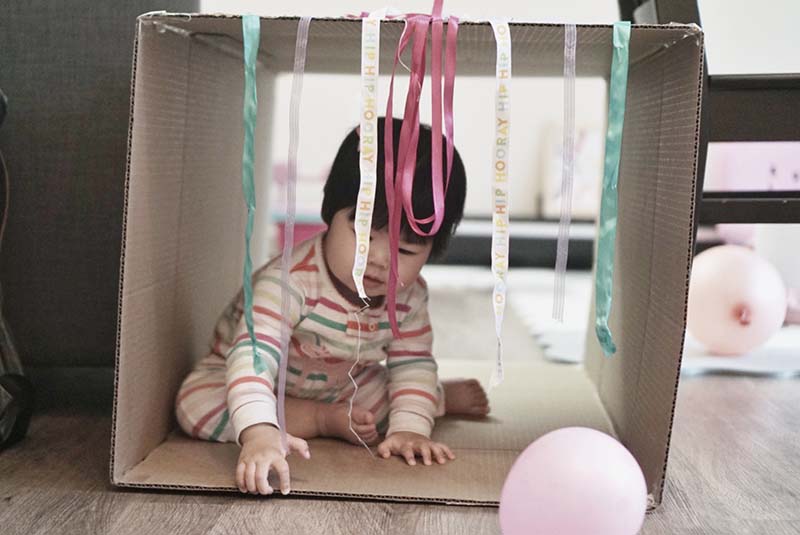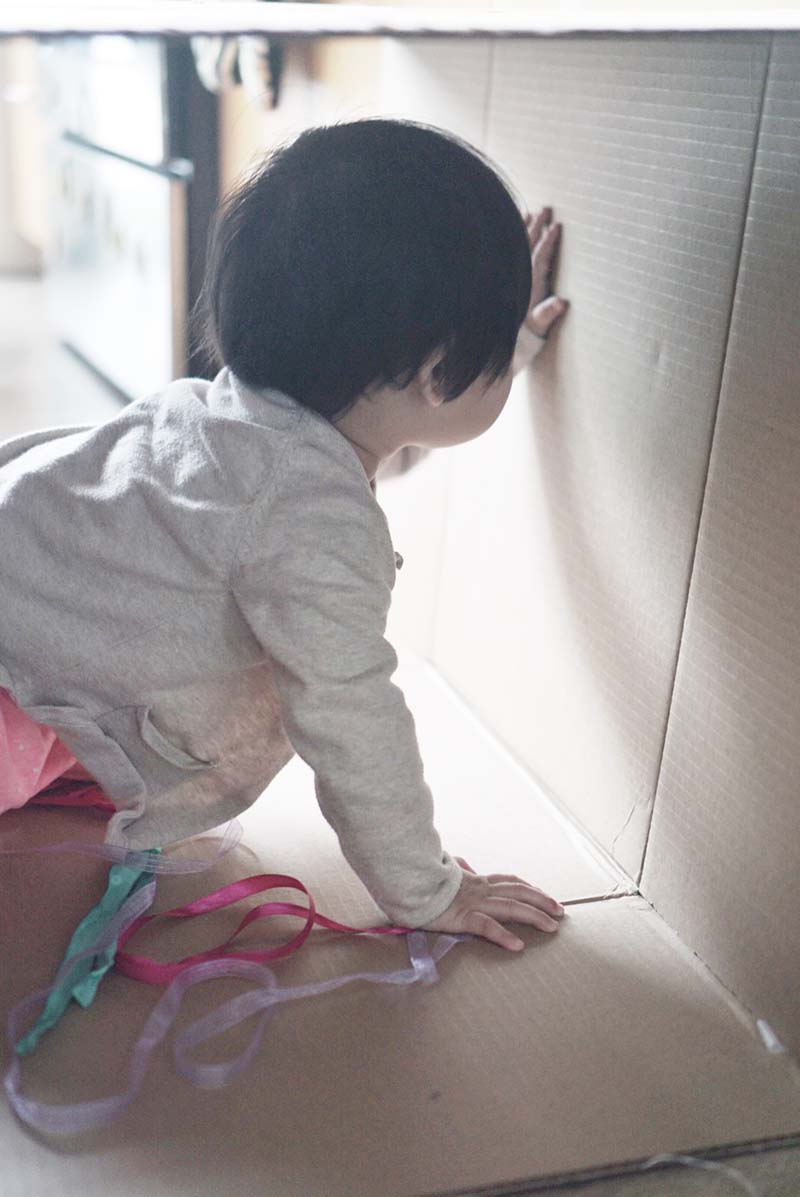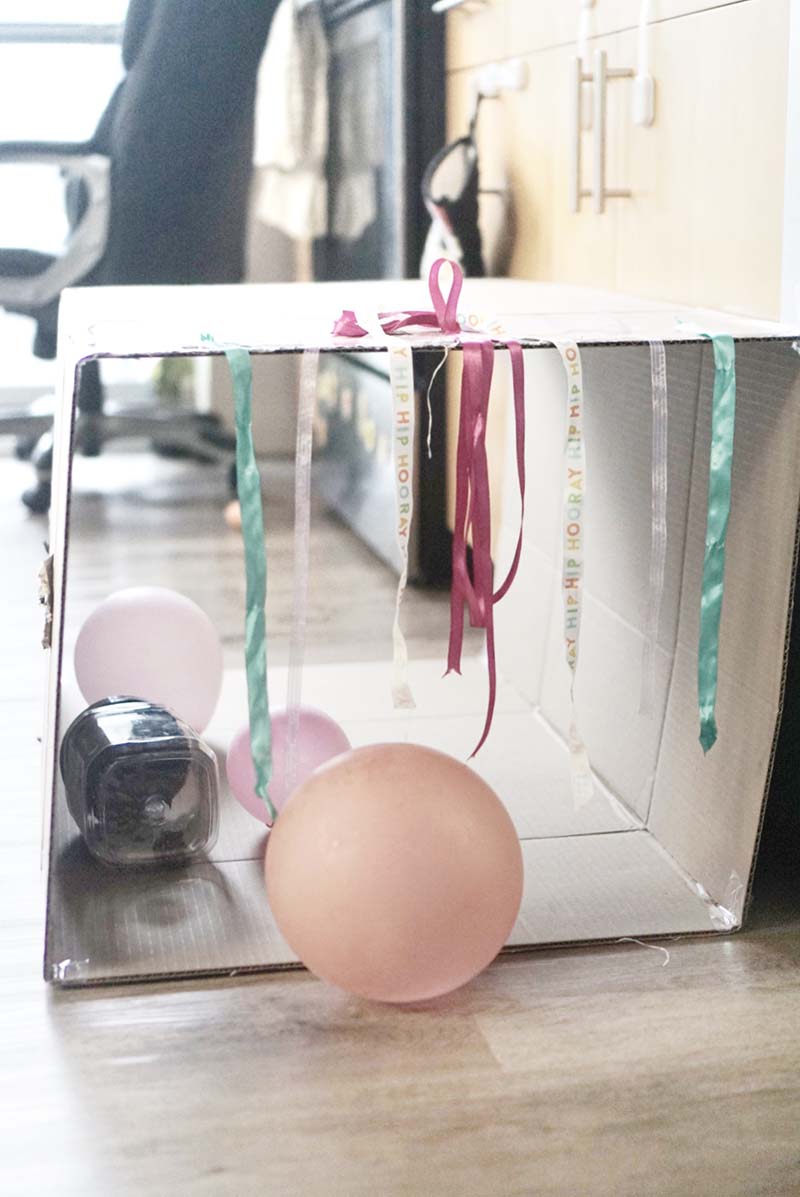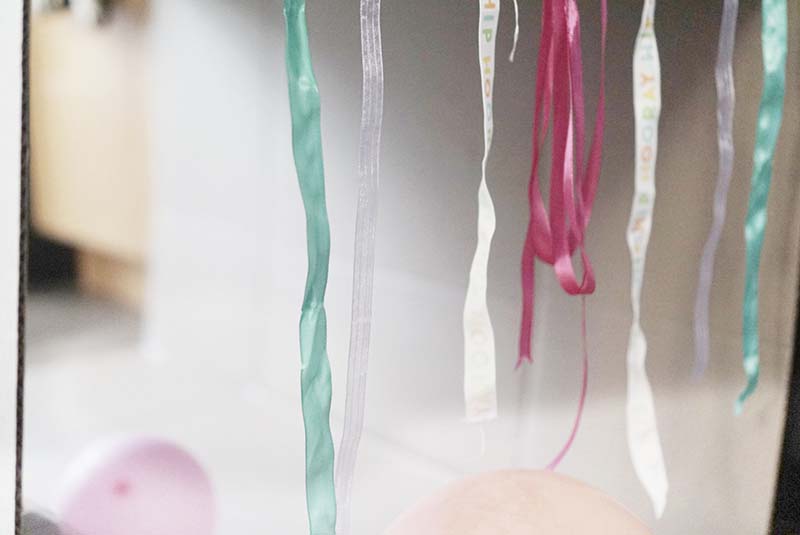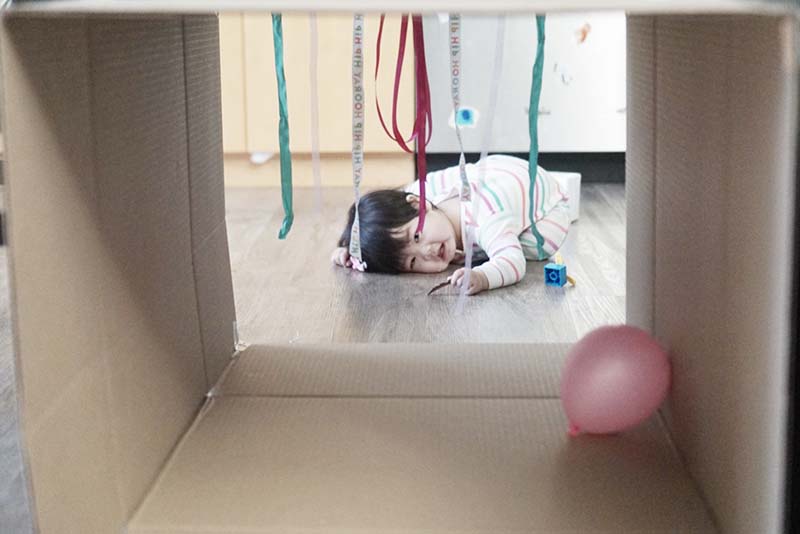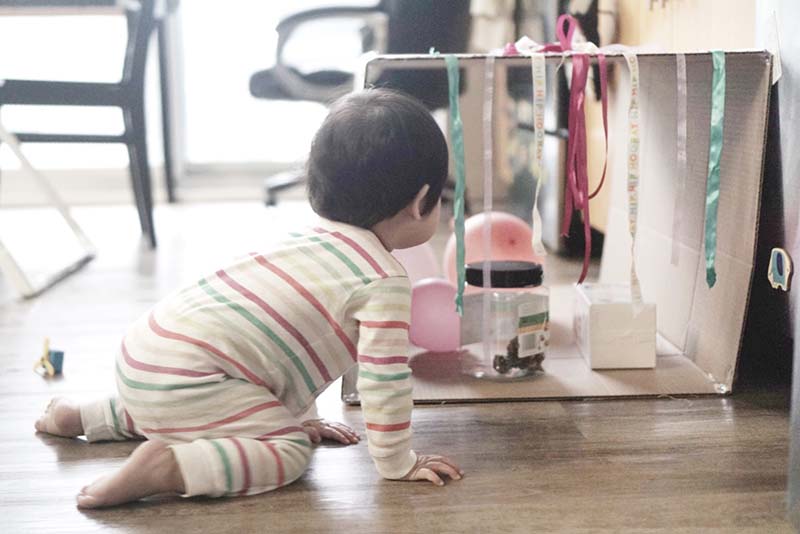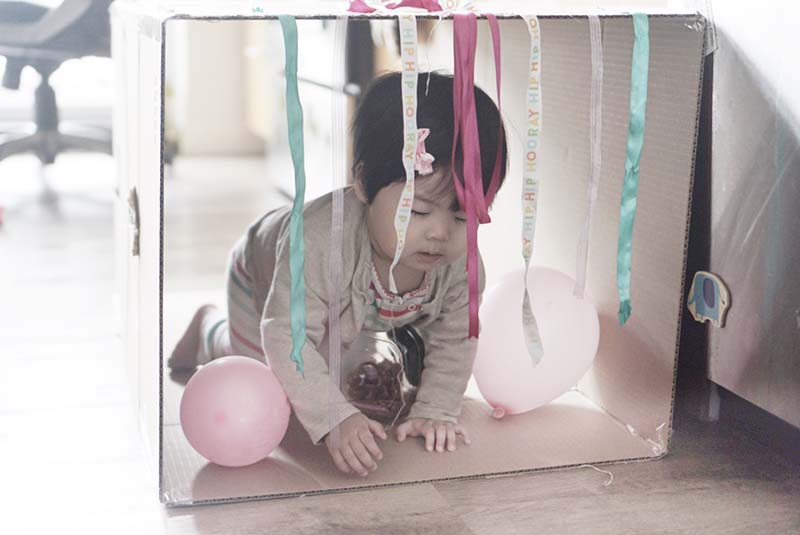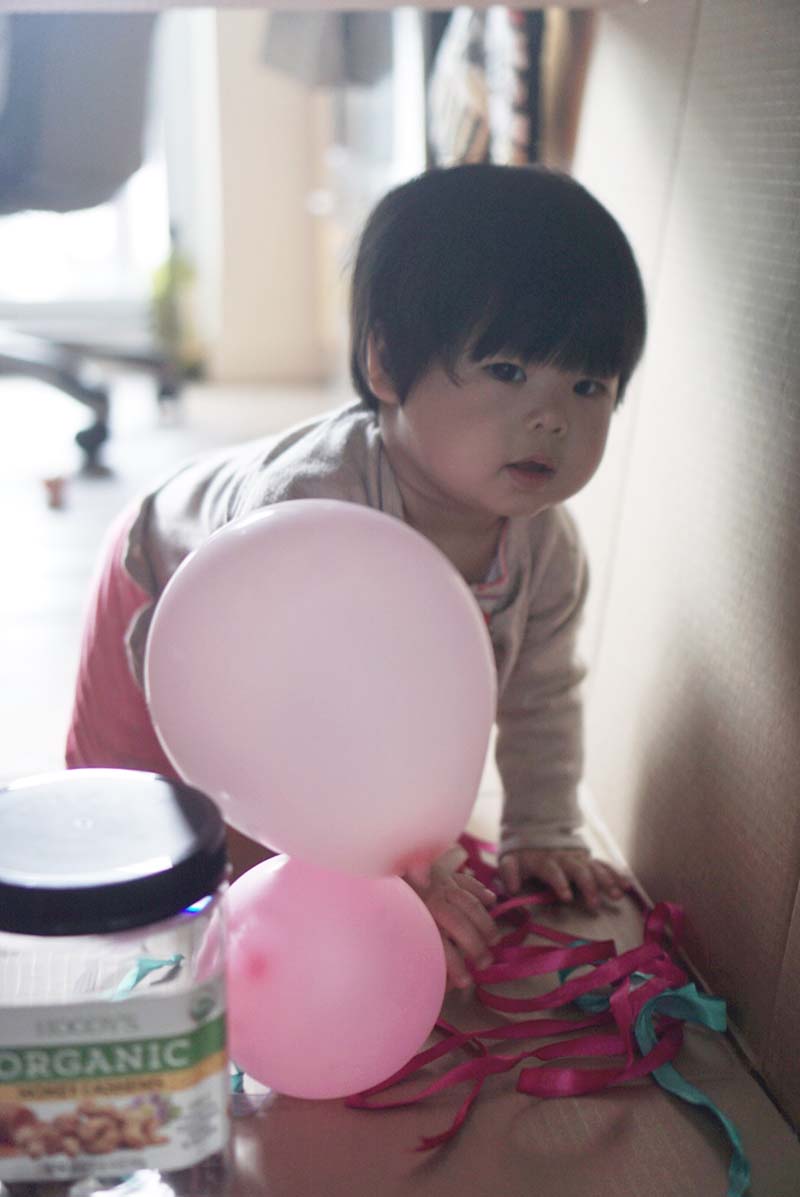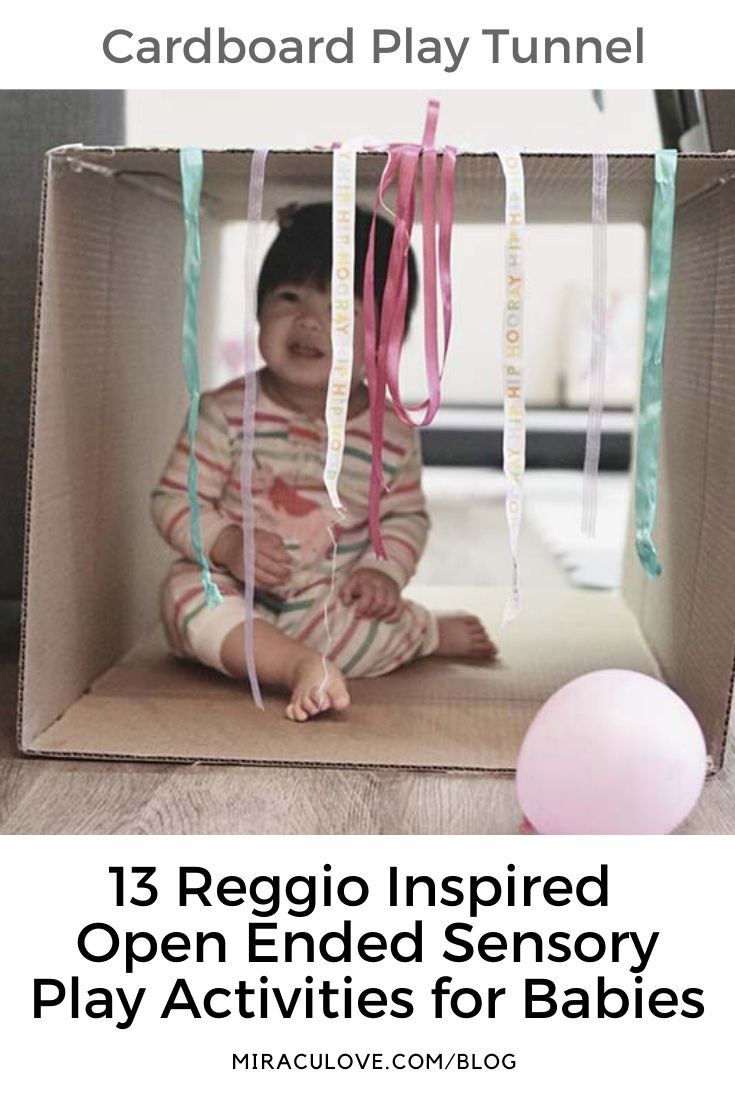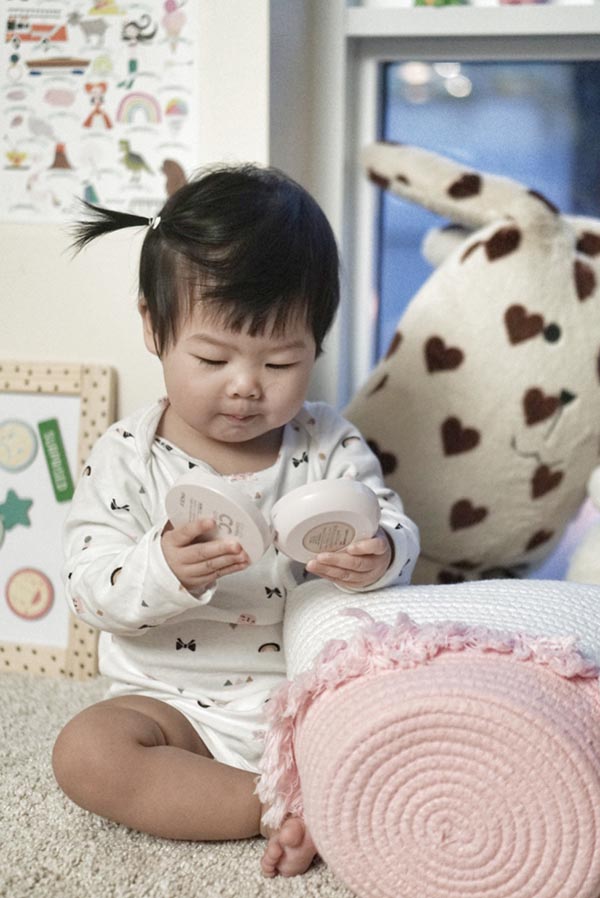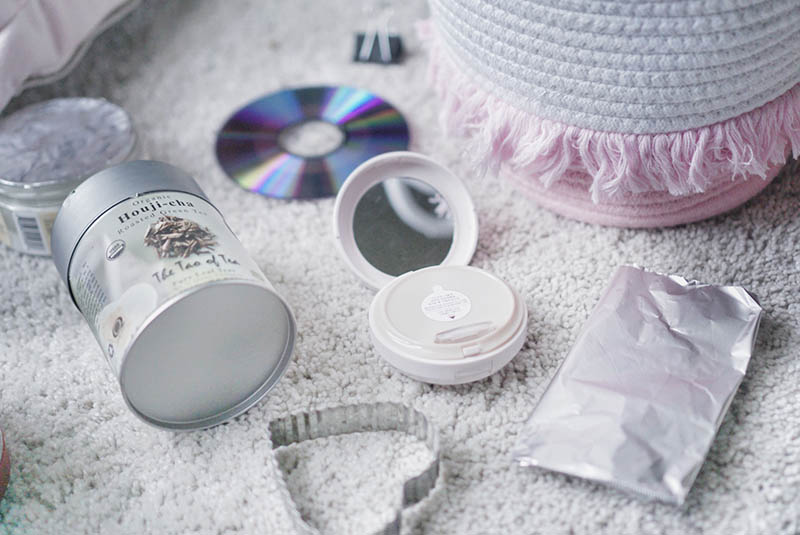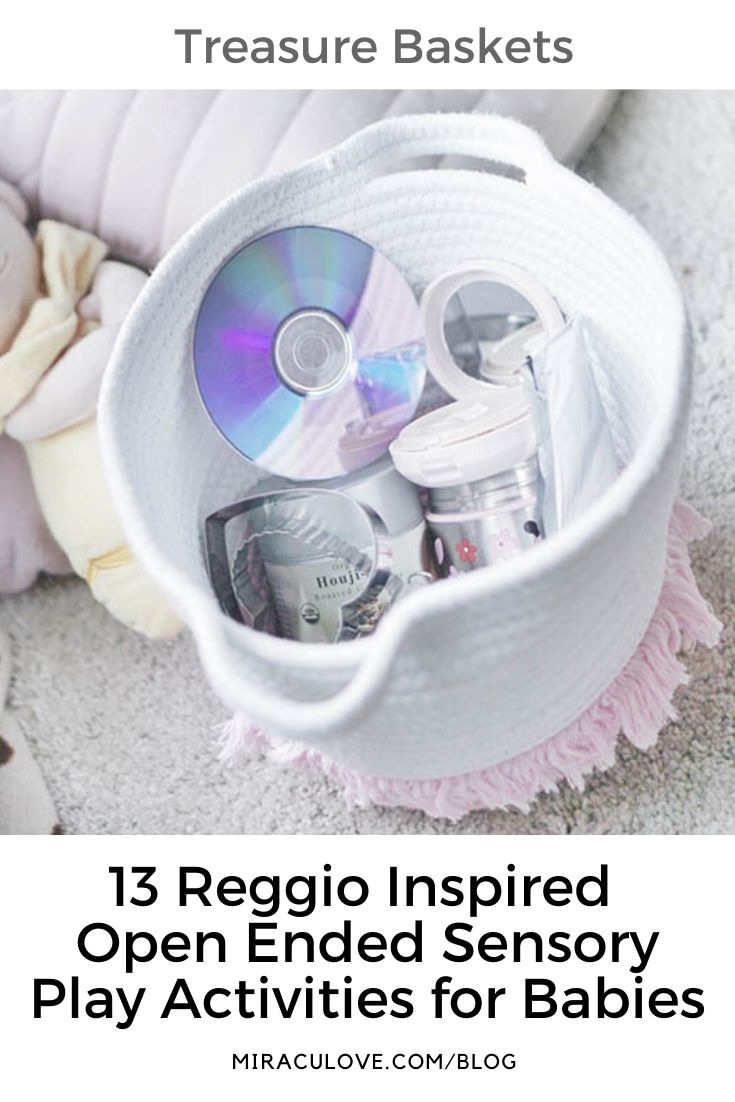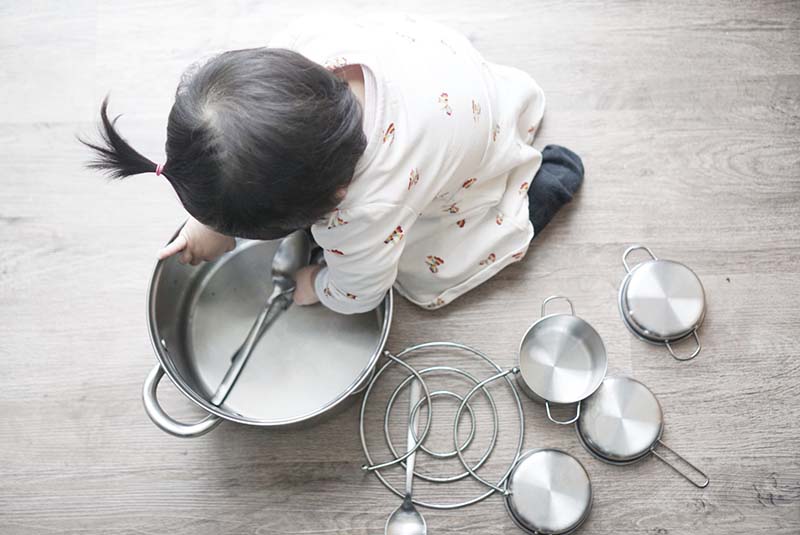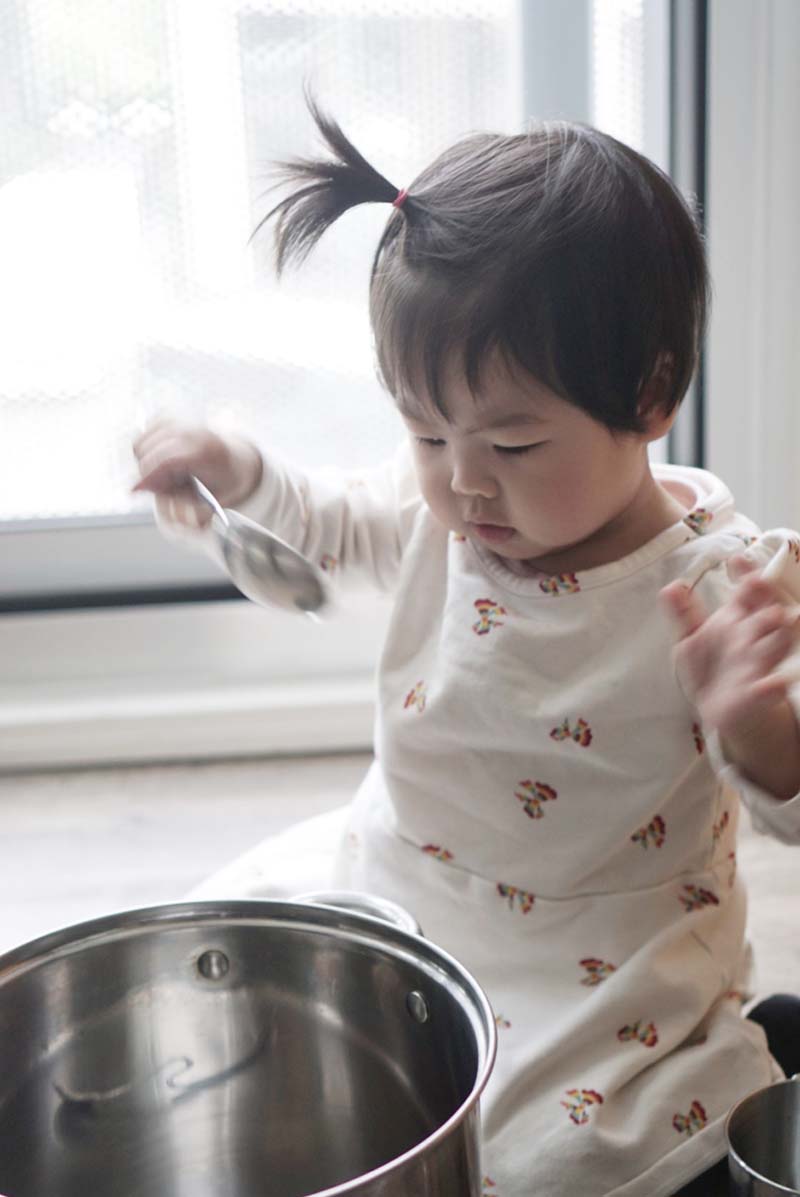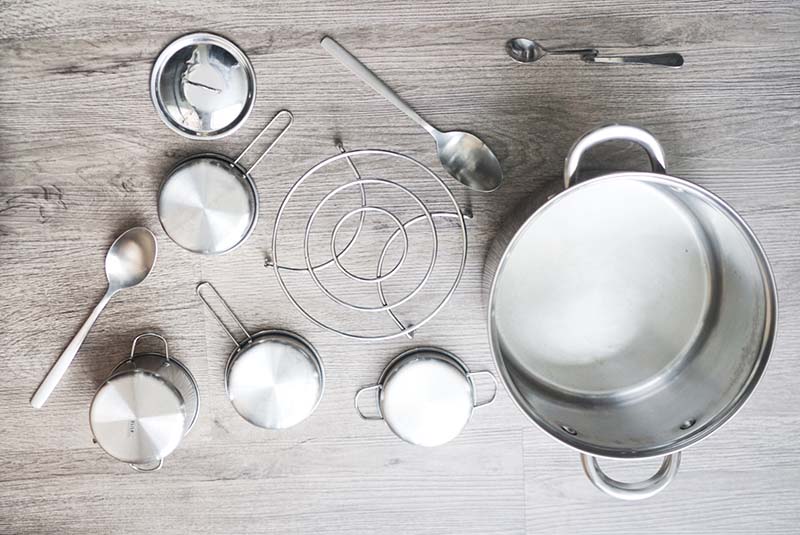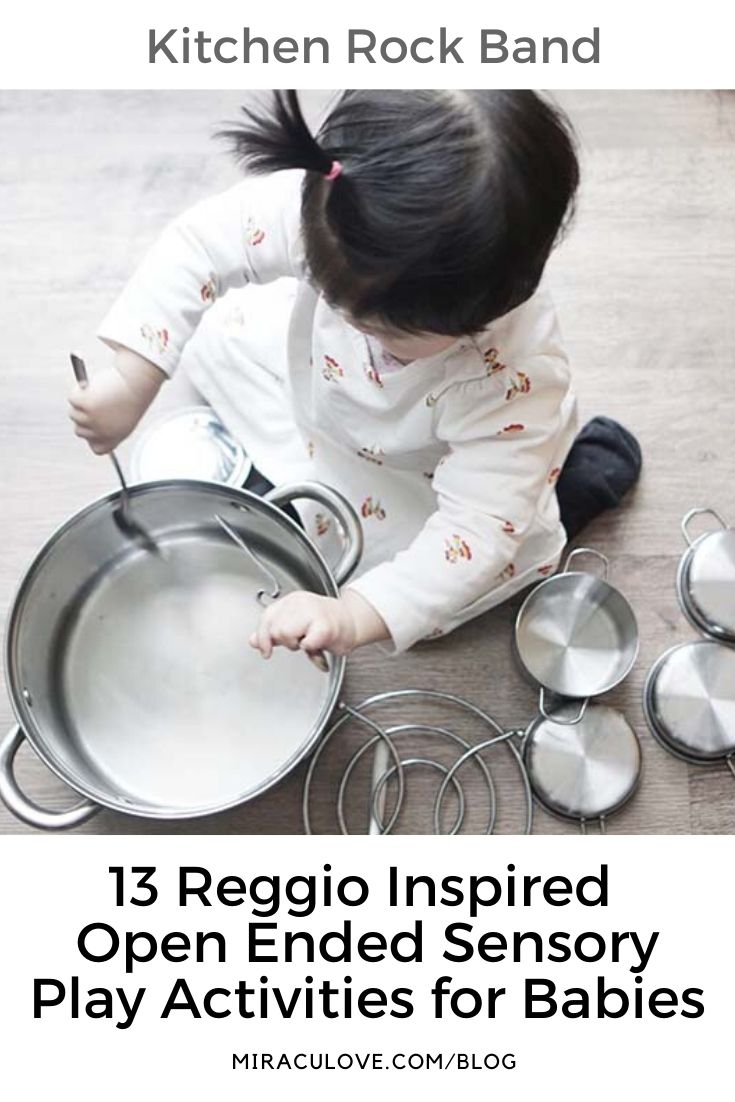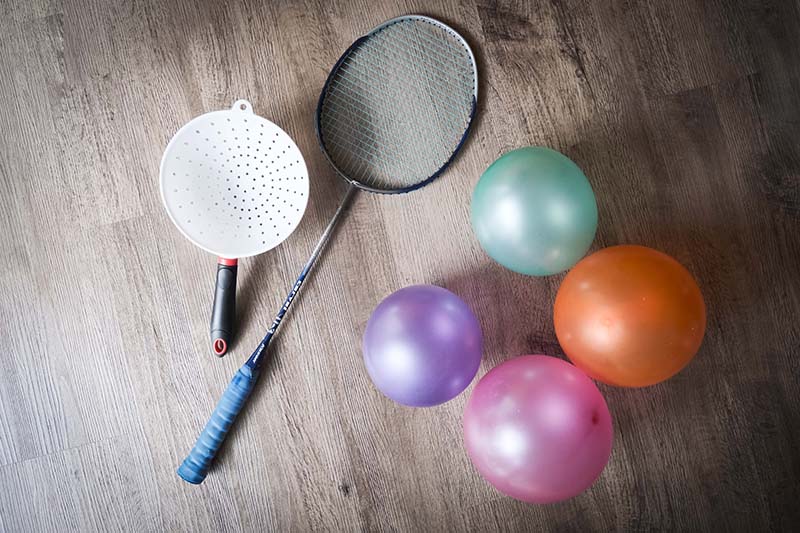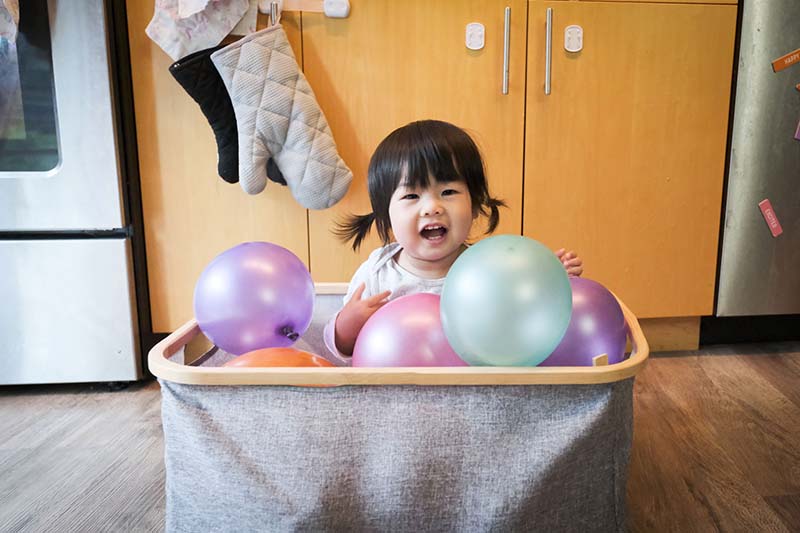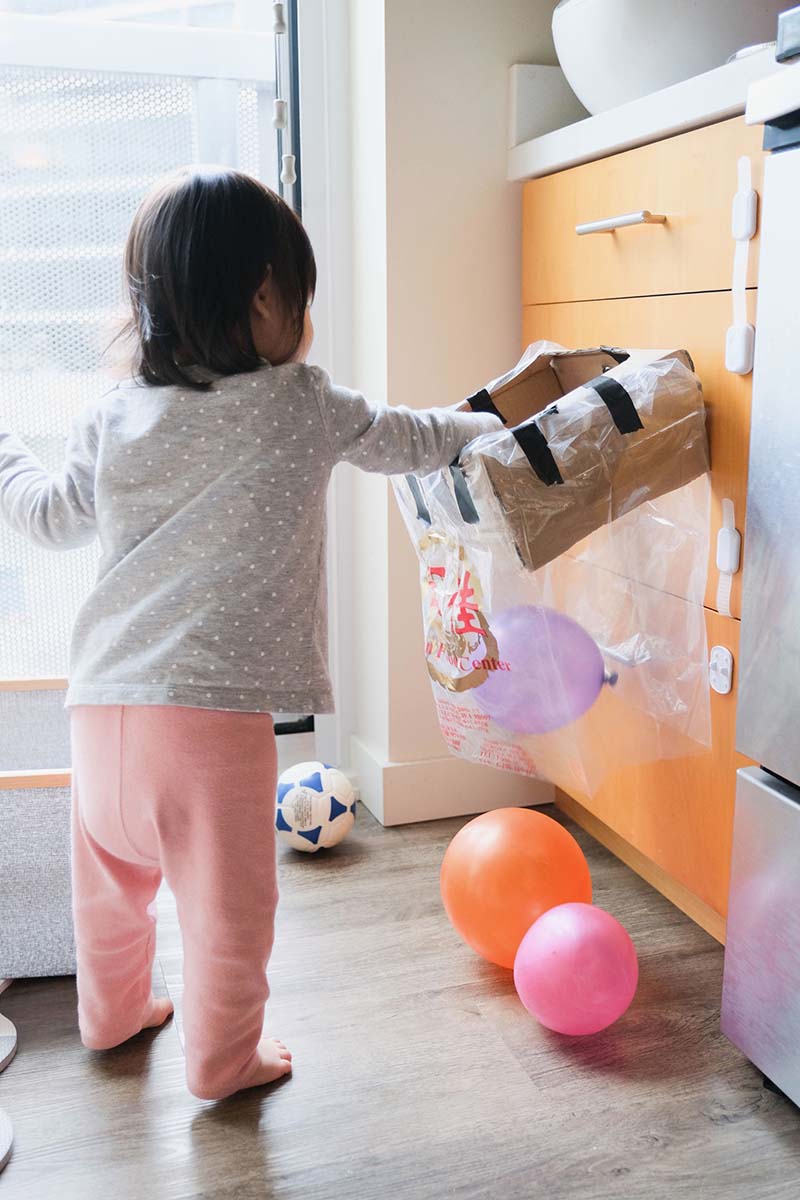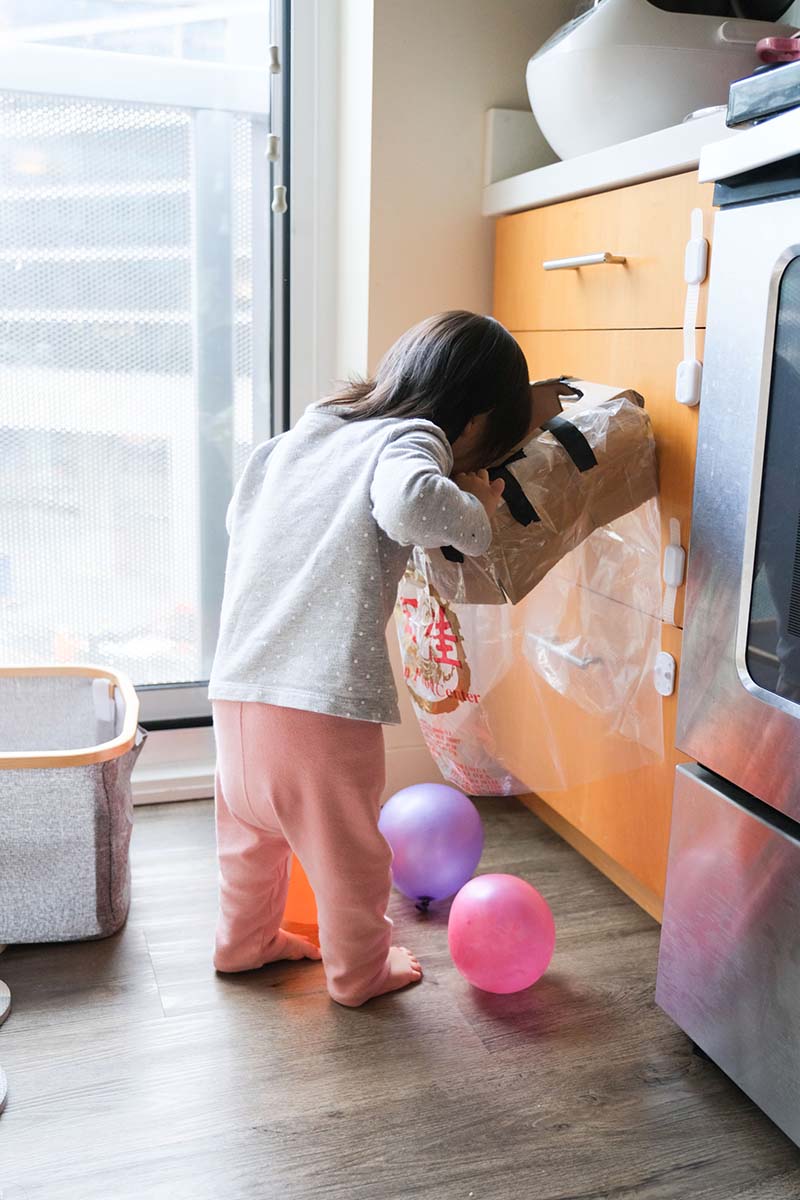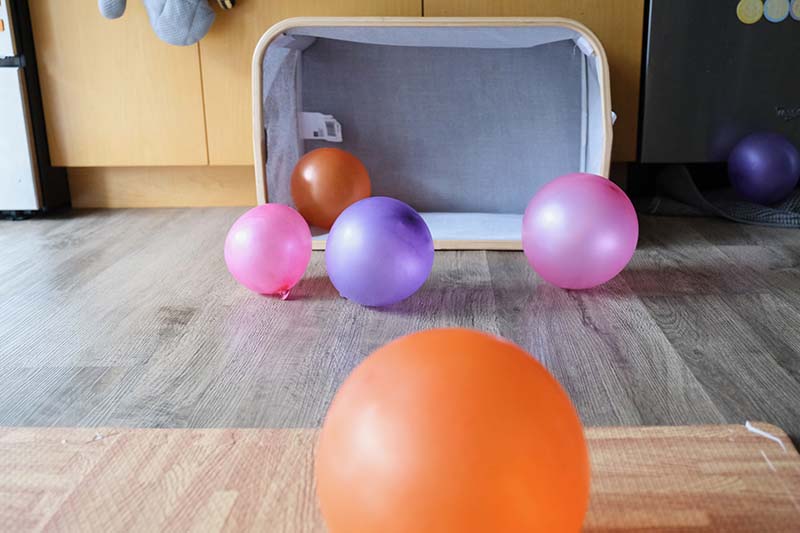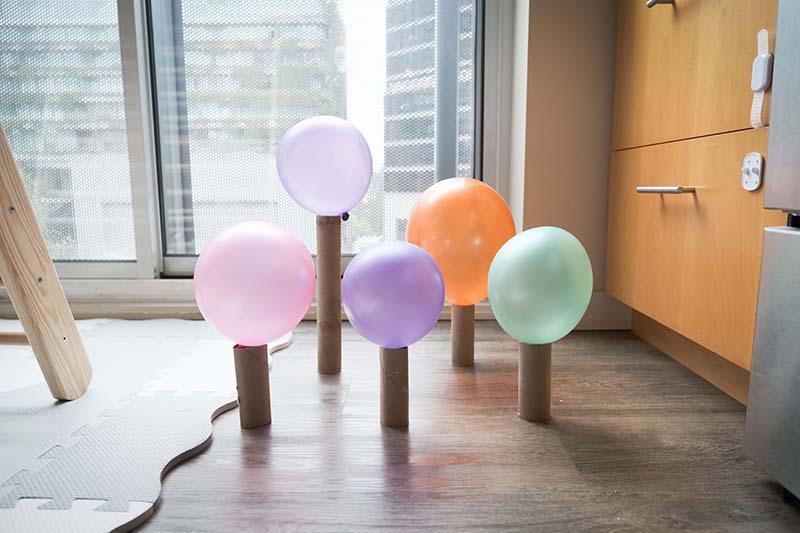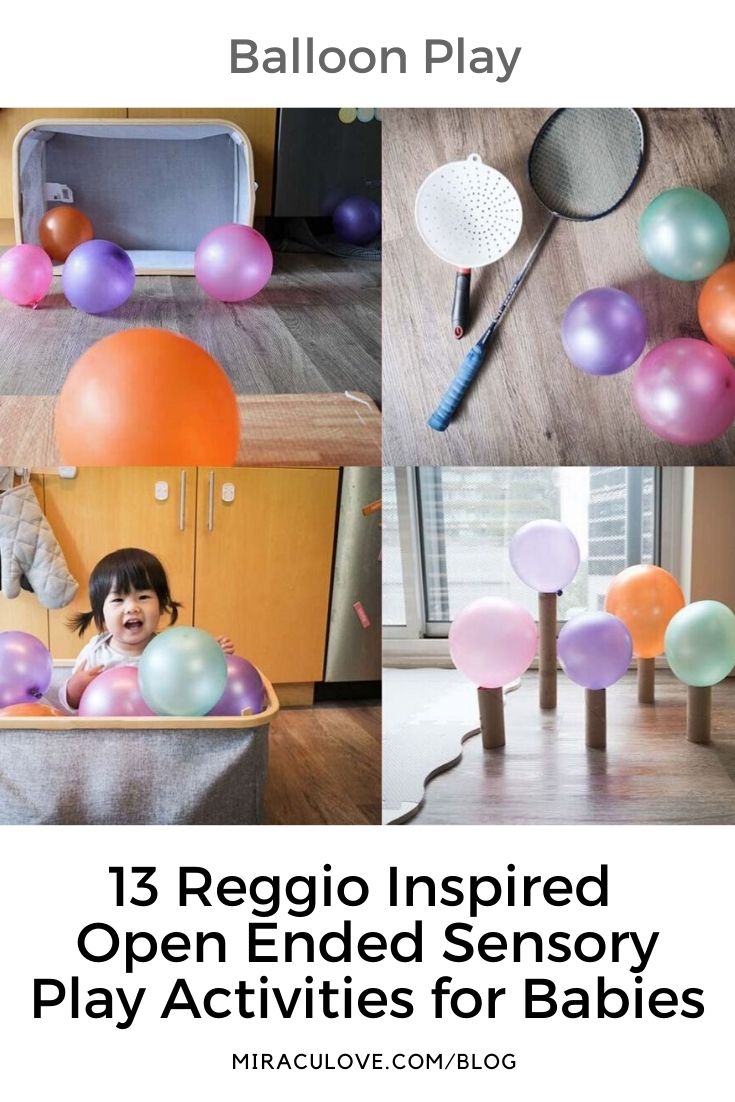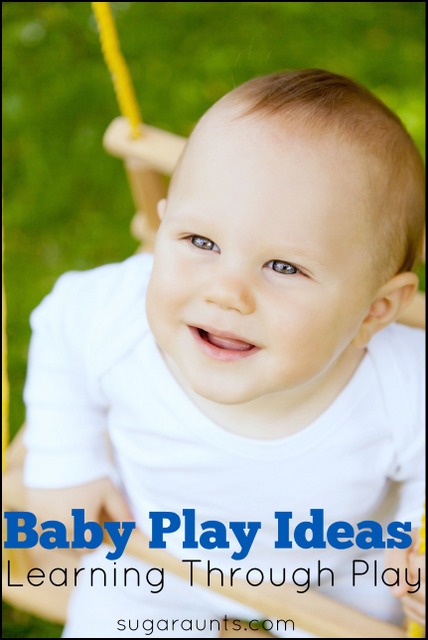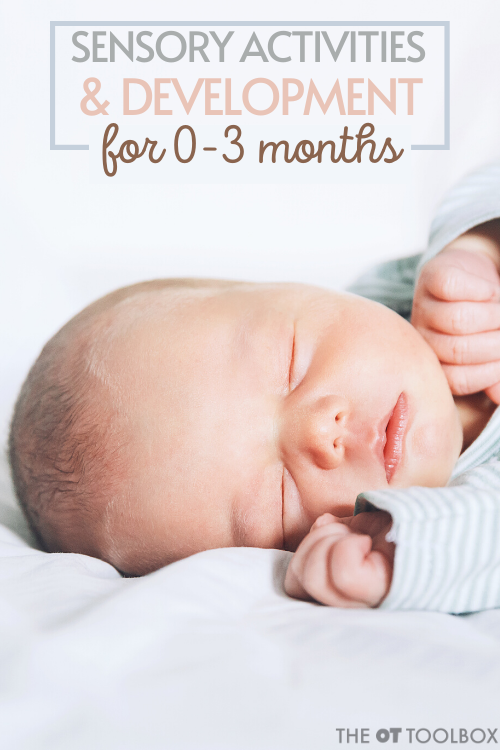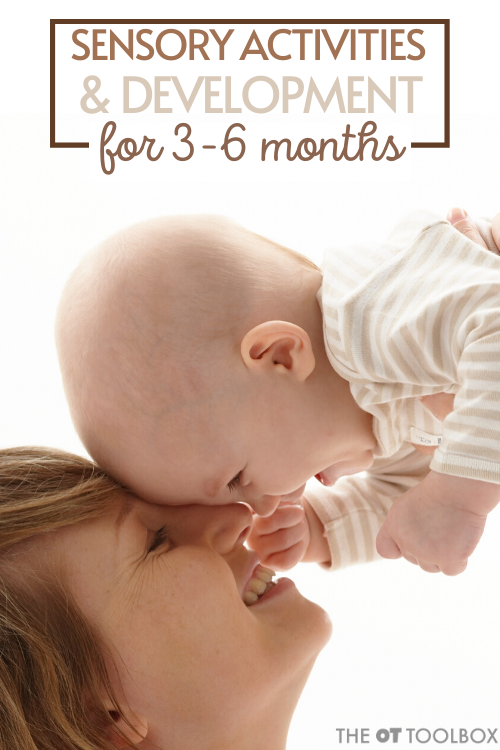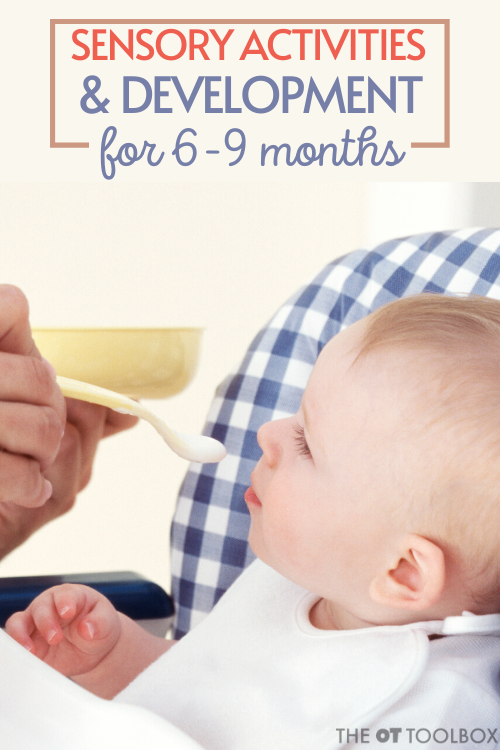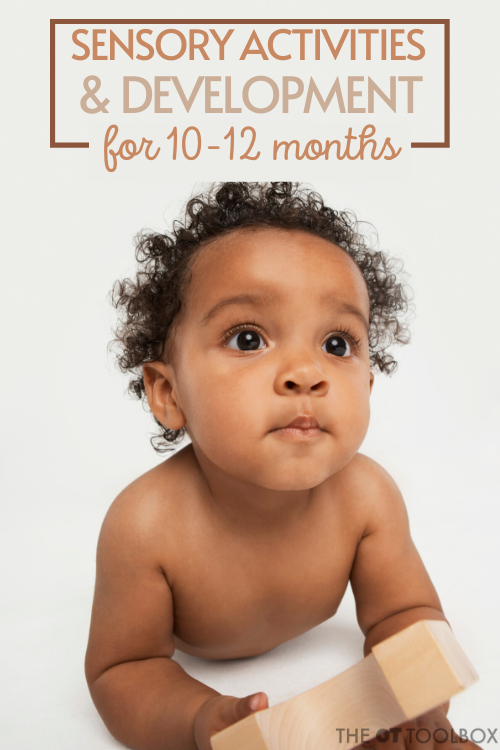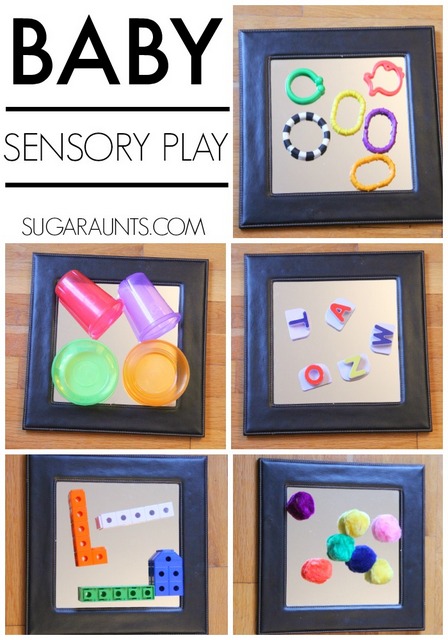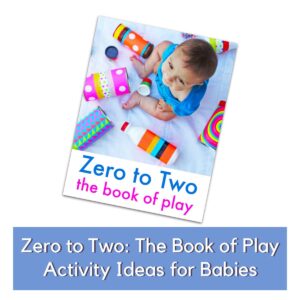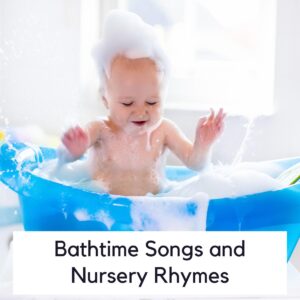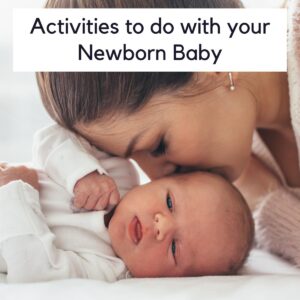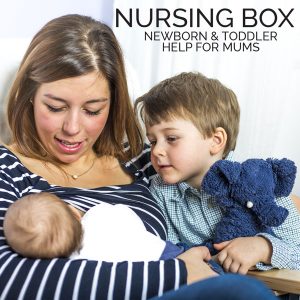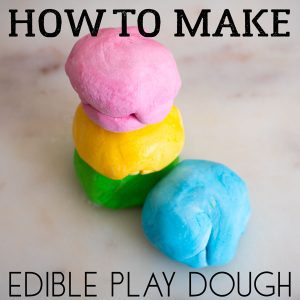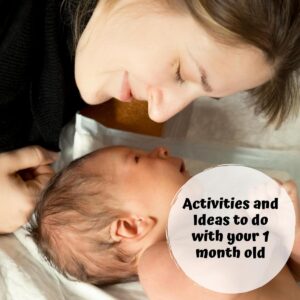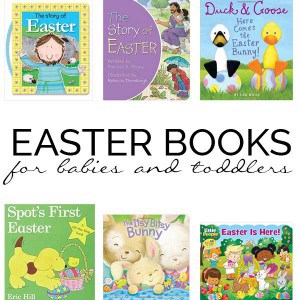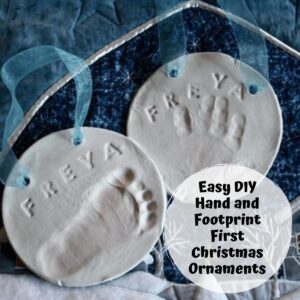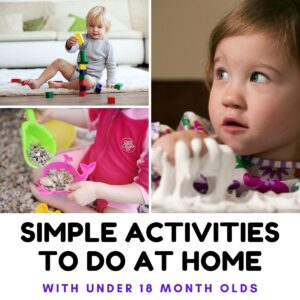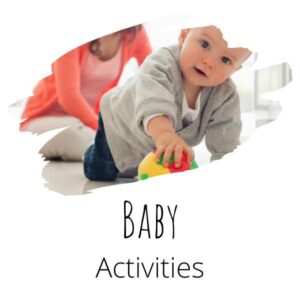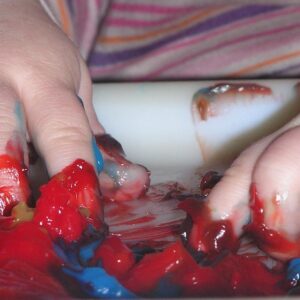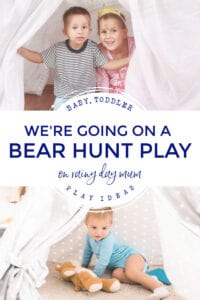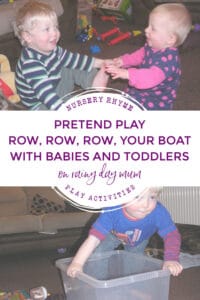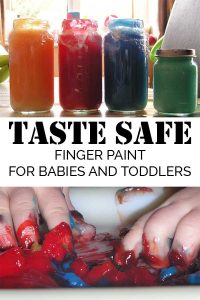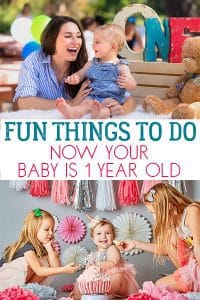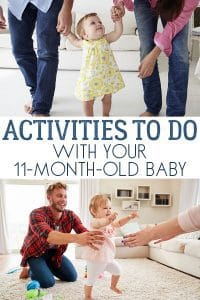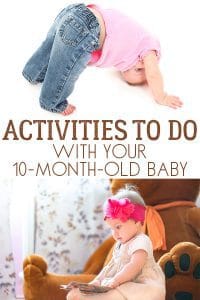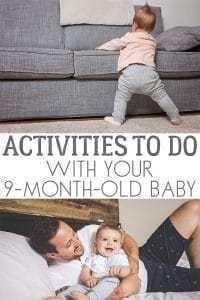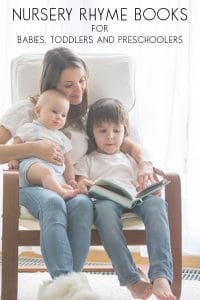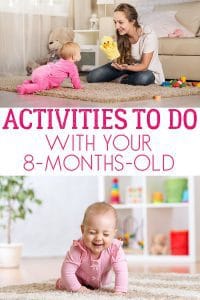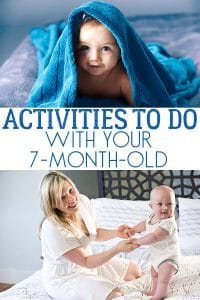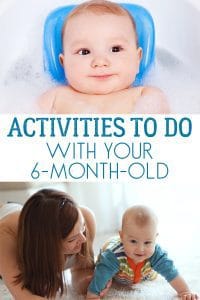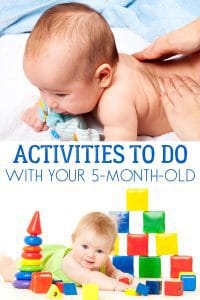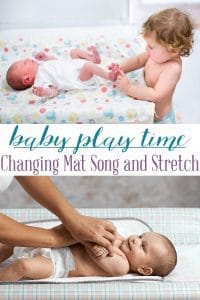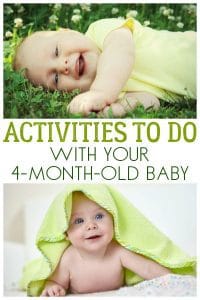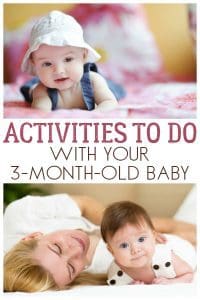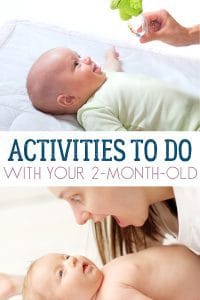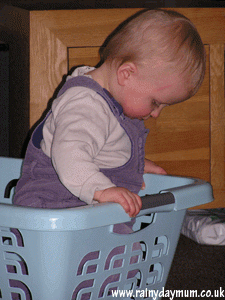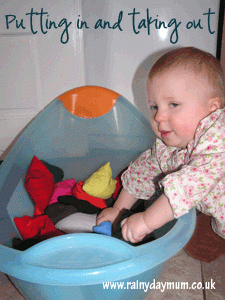Section 2
What does outdoor play look like for babies?
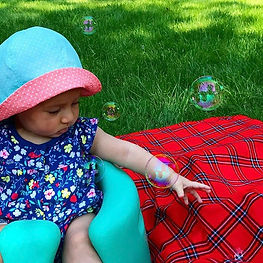
I’m totally inspired by www.365Outside.org and www.simplefamilies.com to incorporate outdoor play every day. If you’re not familiar with these two great blogs, let me tell you about them. 365Outside began August 2015 with a “part-challenge, part-way-of-life, all-mindset” to get their family outside every day of the year regardless of weather, knowing that it would make them happier and healthier. They’ve been outside every day and blogging about it, although less-so lately, come rain or shine, in sickness and in health. Similarly, Denaye at Simple Families says she is sending her kids outside every day “because sometimes they just need time to breathe,” and pledges that her family will spend time outdoors for the next 100 days. Both blog moms invite others to join them.
Did you know that 71% of today’s mothers said they recalled playing outdoors every day, but only 26% of them said their kids spend time outdoors every day? Young children learn so much from unstructured play, and we know that they truly benefit from being in nature. Exposure to nature may reduce symptoms of Attention Deficit Hyperactive Disorder (ADHD) and it improves cognitive abilities and resistance to negative stressors. So as an educator, nature enthusiast, and new mom, I’m all about unstructured outdoor play every day!
For older children, full of ideas for what this time could look like! It could be completely unstructured and imaginative, or it could involve magnifying glasses and cameras. It could be climbing trees, sports-based, or the time could be spent building forts out of sticks! We could do experiments together or art projects. The possibilities are endless.
One problem: my child is just a baby! At 5 months old and unable to sit by herself, how can I provide outdoor play (not just wiking!) for my daughter every day, come rain or shine? I don’t think it will be easy, but I’m up for the challenge. Starting today, we will be outside to play every day!
I’ve thought quite a bit about this, and I see a few barriers…
First: weather. I’m not sure how we will play outside when if it pours all day or is wicked hot, as we say up here. Bringing a young baby outside in the rain or heat to play is definitely questionable!
Another barrier: undeveloped motor skills. My little wike baby doesn’t even sit by herself yet! What can we do outside that would count as play?
Luckily, I’ve also thought of some solutions!
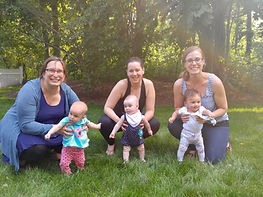
Regarding the weather, I think mild rain could be an interesting experience for my daughter. I will have to invest in some rain gear and think about how we can explore in the rain. When it’s super hot outside, like today, I will have to plan our outdoor play in the shade in the early morning. This is easy, because “we” like to wake up at the crack of dawn!
I’ve brainstormed some ideas for outdoor play with my baby, and I’ll continue to do so. I also truly welcome your ideas! Please! Send them my way. Here’s what I’ve got so far:
Blanket- We can bring out toys outside and simply play on a blanket! Staring at the sky with moving clouds and the breeze on our faces, little insects that wander over to us, the scents of the flowers… I think that definitely counts as being in nature for a baby!Swing- Today I purchased this swing from Amazon, which I will hang from our beautiful maple tree. I think she will love it! Our neighbors just gave us a great slide climbing structure that she slide down with mother’s assistance. It’ll be really great when she can walk!
Sandbox- We have a sandbox, and I’m in the process of changing the old sand out and purchasing a cover for it. I’ll have to have her sit between my legs for now, but I think she will enjoy exploring the textures of the sandbox. I’ll just have to make sure that sand stays out of her mouth! She loves exploring with her mouth right now…Bubbles- Today I brought out bubbles for her to watch. It’s simple, but watching the bubbles and reaching out for them entertained her for a good 30 minutes. And I’d argue it wasn’t just entertainment, it was a completely new visual experience for her and she engaged her motor skills by reaching out to touch them. This is learning through play…for babies!Baby Pool- For hot days, nothing beats time in a pool! I’m sure we will get to a real pool a few times this summer, but as we don’t currently own or belong to one, I think she will enjoy a baby pool! Again, without sitting skills, I’ll have to climb in there with her and hold her as she splashes around, but honestly I can’t think of anything better to do on a hot day!Water “table” with bath toys- For warm days when I don’t feel like filling up the enormous (haha) baby pool or dipping in myself, I can take a pan or tray of water outside with some bath toys or natural items like sticks, flowers, and leaves. We’ll put it between our legs and splash around.
Developmentally Appropriate Nature Play for Ages 0-2
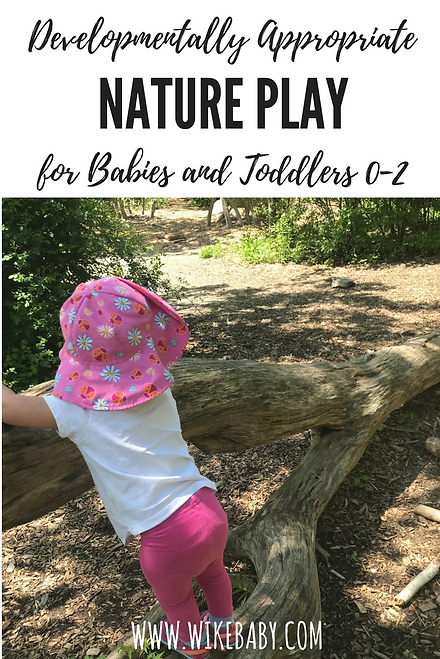
Just about one year ago, I committed to having my 5 month old play outside every day. I laid the foundation for why I feel so strongly about outdoor play and shared my ideas in a blog post about what outdoor play looks like for babies. The post provided a few ideas for what very young children can do when they are hanging around in the backyard. In full disclosure, we haven’t made it outside every single day since then, but we have made it a priority in rain, shine, or snow… and I’d say we’ve done a commendable job!
Now that my little one has grown a full year older and I’ve spend a full year thinking about, reading about, and experiencing outdoor play with young children, I have even more to share. Outdoor play is vital for all children, even the youngest of babies. Nature play synergizes the importance of active play with the benefits of a natural environment. Not only is nature play important for building physical, social, and cognitive development, it’s also a vital component for raising children who care about our Earth. Jacques Cousteau said, “People protect what they love,” and I completely agree. That’s why we need to teach children that they are a part of nature and not apart from it.
It may not seem like it, but there’s so much that even the littlest of children can do in nature. Children are never too young to begin appreciating nature nor too young to reap the benefits of spending time outdoors. Simple things like watching a bird fly through the sky nurture a baby’s development and begin fostering a love for nature.
I looked through developmental expectations for children from the Center for Disease Control and used it to create a list of outdoor experiences for babies and young toddlers from 2 months through 2 years old. I hope this list will inspire you with at least a few ideas for nature play given your child’s development!
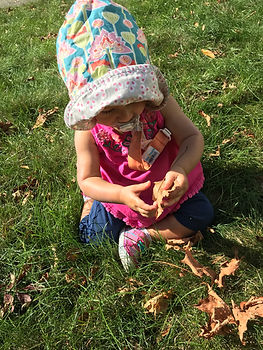
Before we move on, let's step back for a second. The purpose of this list is not to compare what your child can do to what is expected. As parents, especially new parents, it's natural for us to want to compare our child to what is "normal". I fully recognize that not all children progress through milestones at the same ages and that every child is unique. Keep in mind that even if a child's motor skills are developed age appropriately, language skills emerge at different rates. Some children showcase their oral vocabulary earlier on while others take it all in without expressing their thoughts to the world. Children also accept sensory experiences at different rates; some can adapt quickly, while others may need a slower introduction to learn that new settings, textures, and movements are safe to enjoy. I recommend that you consult an expert such as a pediatrician, pediatric OT or PT, or speech pathologist if you have questions about your child's development.
Use this list to help you answer the question: “What can nature play look like for my baby?” Find where your child falls developmentally (regardless of the age listed), and read about what you can do to support his development during nature play.
2 Months
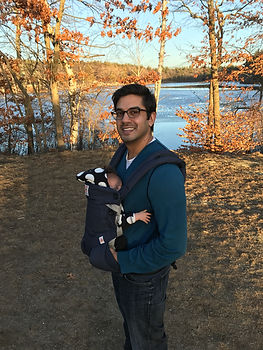
At this age, you can lay your child on a blanket outdoors. If you’re a seasoned parent or daring
(which I wasn’t when Wike Baby was this age!), try laying him on the bare ground. Put him on his back to stare up at the sky, trees, and birds, or put him on his belly with some nature items in front of him to try to view. Wear your baby in a carrier while you go for a hike or take a walk with your child while he’s nestled in his stroller.
Here’s what two month olds will generally do and what caretakers can do to support their development while outdoors:
Turns head toward sounds. Begins to follow things with eyes and recognize people at a distance. A natural setting is a great place to discover sounds-- it's quiet enough that sounds like bird calls, rustling of leaves, and running water are discernible but not overwhelming. This is also a fun age to play with light: duck in and out of shadows and watch the sun flicker through leaves or bounce off water. Everything is completely new, and watching your child discover these sensations for the first time is a beautiful thing!
Begins to act bored (fussy) if activity doesn’t change. Keep moving for a change of scenery. This is the age when Wike Baby started to LOVE being outdoors—there is so much to see, hear, and feel. Let your child feel the slight breeze on his face or the sun on his head, and let this sensation change for your child as you walk through different environments.
Can hold head up and begins to push up when lying on tummy. Try tummy time outdoors. Place nature items in front of your baby to encourage him to build those muscles. If he’s resistant, like Wike Baby was, put him on your chest as you lay down on the grass for some parent-child outdoor bonding.
4 Months
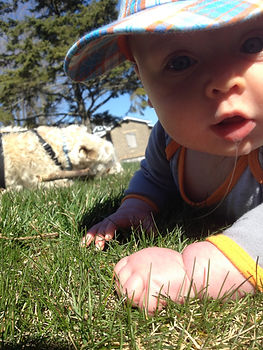
At four months or when your baby is able to hold his head up steadily (between 4-6 months
generally), your child is ready to face outward in your baby carrier, such as the Ergo 360 (our favorite). We tried this around 5 months, and Wike Baby LOVED it. It’s a whole new way for them to see the world. This is also when your child can sit with assistance, such as in your lap or in a Bumbo seat. Although it is certainly not recommended by pediatric physical therapists, we used our borrowed Bumbo for short periods of time, including sitting outside in our yard.
Here’s what four month olds will generally do and what caretakers can do to support their development while outdoors:
Copies sounds that are heard. Draw attention to sounds you hear by mimicking them yourself. Name the animal that made them to help your child begin to associate language with concrete items.
Uses hands and eyes together, such as seeing a toy and reaching for it. Can hold and shake a toy. This is a particularly great time to begin to lay nature items out around your baby for him to manipulate and explore: rocks, pinecones, flowers, grass, bugs, seeds, etc. Be aware that it’s also prime time for oral exploration to begin! Pro tip: if you’re lucky/unlucky enough to have a pacifier user on your hands, pop the paci in your child’s mouth before providing him with items to explore. (That’s my two cents; feel free to let your child put items in his mouth if that’s your parenting style! Judgment-free zone over here!)
Recognizes familiar people and things at a distance. Visit the same outdoor environments frequently to build familiarity. Name the items you see, and point out some of the same things each time you visit. Point out birds, planes, and critters that make noise, and watch them as they move. Point them out and follow them. When you hear something, stop to investigate what it is. Think aloud: "What was that noise?" or "Why did that tree move?" Then, together search for it. Look for the bird that tweeted or the squirrel that rustled the leaves. This lays the foundation for encouraging curiosity!
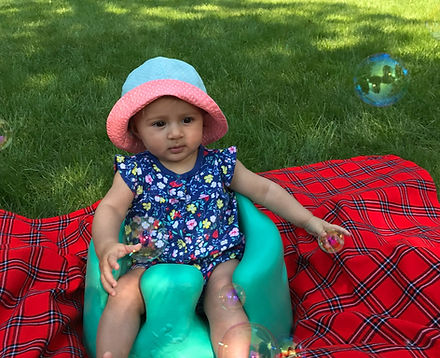
6 Months
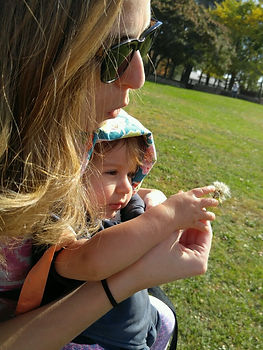
This is one of my favorite stages—your baby is becoming more and more fun! His personality is beginning to shine through, and he likes to play. Spending time outdoors together is a great way to bond, which is true at every stage, but it’s becoming even more fun for both of you at this point in your child’s development.
Here’s what six month olds will generally do and what caretakers can do to support their development while outdoors:
Likes to play with others, especially parents. Tummy time with your child on your belly while you lay on the grass, coupled with giving him an “airplane” ride (or pterodactyl ride, be creative!), can be ridiculously fun.
Responds to sounds by making sounds. Listen for nature sounds and mimic them. You may find your child mimicking them (or you), as well.
Makes sounds to show joy and displeasure. While walking with your child forward-facing in a carrier, try doing gentle hops or twirls along the way. Spinning, even with your child attached to you in a carrier, develops your child's vestibular system, which is responsible for balance, coordination and skills like head and trunk control and rolling. Your child’s understanding of object permanence is developing, so hide behind a tree and pop out to see your friends or have them do the same to you. Bounce and sing songs. What makes your child squeal with delight? Keep doing that!
Looks around at things nearby. There is SO much to see outside. Wike Baby always calmed down outside because she was taking in everything there is to see, feel, and hear!
Shows curiosity about things and tries to get things that are out of reach. When doing tummy time outside, place items just out of your child’s reach to motivate him to move.
Begins to sit without support. Break out your bubbles! When your child can sit and likes to reach for things, blowing bubbles begins to be super fun!
9 Months
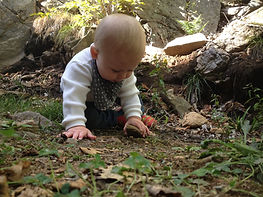
Around nine months is when your child may begin to show curiosity. In my opinion, curiosity is one of the most exciting things about childhood! Nurturing our children’s natural curiosities is one of the important things we can do for their cognitive development.
Here’s what nine month olds will generally do and what caretakers can do to support their development while outdoors:
Uses fingers to point at things. When your child points at things while on a walk, name the item and follow his finger to get close up and touch the item (if possible). You’ll be teaching your child how to follow his curiosity.
Watches the path of something as it falls. Leaves, snow, seeds, flower petals, rain: there’s something falling from the sky in every season. Take moments of time to stop and simply watch gravity in action with your child.
Looks for things he sees you hide. We played some epic hide ‘n’ seek with Dad behind trees while hiking at this stage. While sitting on the grass, you can also hide rocks (avoid rocks that are choking sized!) under leaves or cover items with grass or sand.
Puts things in mouth. As in everything. If you’re lucky/unlucky enough to still have a pacifier user on your hands, you can use it as a plug to keep your child from exploring nature items with his mouth. On the other hand, if you know something is safe for consumption, your child is eating table food in the home, and you know your child has no allergies, it could be a fun time to have him taste edible plants. Perhaps you’re into foraging or simply have an herb or vegetable garden. Use your discretion!
Crawls, pulls to stand, sits without support, and stands holding on. Your baby is on the move! Find safe outdoor spaces for your child to practice these skills. Remember that “clean dirt” (soil without chemicals) is healthy and comes off in the bath! This is also a time when your child may begin to play with push toys—why not bring them outside?
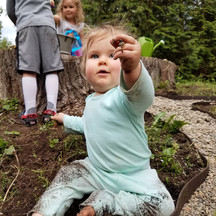
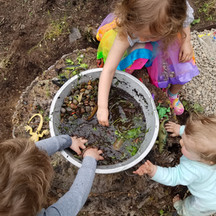
1 Year Old
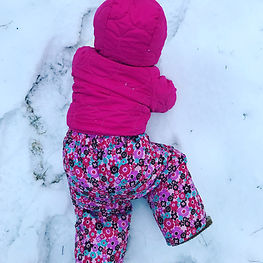
At one year, your child increasingly interacts with the world around him. Hopefully he is stronger now, so you can be outside experiencing the elements in rain, shine, or even snow. If you haven’t yet put your baby on your back while walking about or hiking, definitely try it now. At one year, Wike Baby loved being on my back while snowshoeing, and she especially loved being pulled in a sled on the snow. This is also the time when your child may begin to be even more mobile; embrace it, and let him build his skills on the varying terrain outdoors.
Here’s what one year olds will generally do and what caretakers can do to support their development while outdoors:
Explores things different ways, like shaking, banging and throwing. While hiking with your child on your back, pass things such as dandelions, cattails, or sticks back to your baby to hold and explore. Stand along the shore together and toss rocks in to the water. Show your child how two sticks or two rocks knock together to make a sound.
Looks at the right picture when it’s named. If you’ve been naming what you see outdoors since he was tiny, now he may be able to find an item (such as a flower or bird) when you say the word. Vocalize interesting things you see using the name (such as, “Look at the beautiful flower!” or “Do you see the pretty bird?” without pointing, and follow your child’s gaze as he interprets your words.
Puts things in a container, takes things out of a container. Wike Baby happily did this for hours on end. Bring a small bucket or bag with you on your outdoor adventure. When you locate a place with rocks or small sticks, show your child how to put them into the bucket. Watch as he then takes them out and puts them back in again. Over. And over. And over again!
Pokes with index finger. Encourage this! Poking at trees and feeling their different types of bark can be an interesting sensory experience for a one year old. Build oral language by naming the textures he feels.
Pulls up to stand. May take a few steps on own. May stand alone. As soon as your child starts to crawl and walk, let him experience different terrain. Walking on grass, sand, or snow outside is much different from the hardwood floors inside. You cannot replicate outdoor terrain indoors, and the outdoor terrain will help your child naturally develop balance, core strength, and spatial awareness. Allowing your child to walk outdoors without shoes is a physical and occupational therapist suggested activity that supports your child's development of balance, sensory processing, and proper muscle development in the feet.
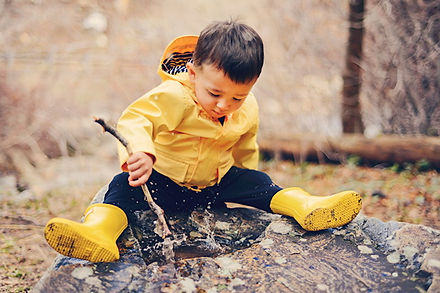
18 Months
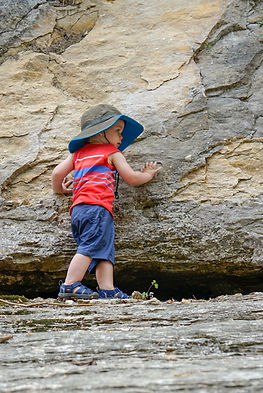
This is just about where Wike Baby is right now, and let me tell you how fun she is at this stage! She is able to engage herself in free outdoor play, she loves to climb, and she’s beginning imaginative play. She wants to walk on her own, but we don’t get too far while hiking because her goals are different from mine. At 18 months, letting your child take the lead outdoors should be priority number one.
Here’s what eighteen month olds will generally do and what caretakers can do to support their development while outdoors:
Likes to hand things to others as play. Let your child explore nature items he comes across. When he hands something to you, such as a stick, thank him, hold it, and hand it back. Engage in play by handing him things you find as well. As always, name the items with which you interact in full sentences to promote language growth.
Follows 1-step verbal commands without gestures. Practice this when you get ready to go outside by telling your child to get his socks. Then tell him to get his shoes. Then tell him to get his jacket. When you’re outdoors, there’s plenty of opportunity to use 1-step commands during play. “May I have the stick please?” “Walk over here.” “Look at that bird!”
Plays simple pretend, such as feeding a doll. This can be a good time to bring out the mud kitchen! You can fashion one yourself using old wood pallets, visit a nature play area or even a sandbox nearby, or simply bring some bowls and spoons outside for playtime. Finding nature items to put into your concoction is part of the fun. Remember that this is also the age when children follow 1-step demands, so be mindful if you stir up a beautiful dish of sand, crushed leaves, and grass and you say, “This is delicious! Try it!” Your child may actually take a taste! Not that I know from experience…
Explores alone but with parent close by. I can get so much yard work done now! She happily plays in the sandbox, picks up sticks around the yard, or goes down the slide on her own—as long as I’m nearby. I put a fort out in the yard for her to play in, and she loves bringing things inside, sitting in there for a while, and then coming out for more things. I know someone with a child this age who actually reads a book under a tree while her son plays on his own. Milk it, Mama.
Says several single words. Engage in conversation every time he says a word that corresponds with what he sees in order to encourage his language. If he points to a bird and uses the word, then tell him all about the bird, its colors, and what it is doing. Engage. Encourage.
Scribbles on own. Time to introduce sidewalk chalk! Sidewalk chalk is endless fun. On hot days, you can also “paint” on pavement with water and watch it disappear. Show your child how some rocks can be used to write on other rocks. We had a blast writing with shale when I was a child.
Walks alone. May walk up steps and run. Let your child take lead on “hikes”. I put “hikes” in quotation marks because you should set your expectations accordingly. You will not be traveling far with an 18 month old taking the lead. Wike Baby likes to go in the opposite direction of my goal. That’s fine. Embrace it. This is also a good time to encourage safe climbing. Climbing stairs, fallen logs, or natural rock formations is a worthy obstacle for an 18 month old.
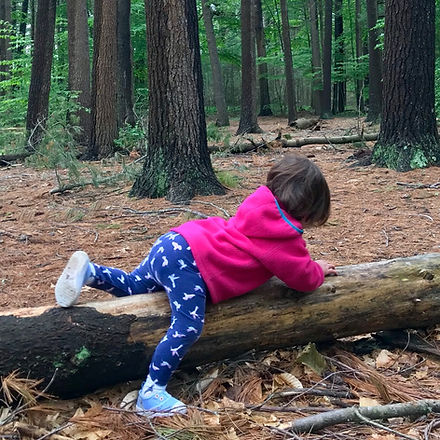
2 Years Old
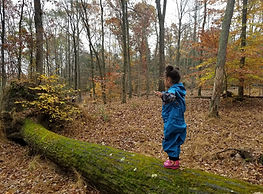
This is where we are headed in my house, and boy do I have ideas. I’ve consulted friends with two year olds or recent two year olds to ensure my suggestions are appropriate. I welcome your ideas, as well! Share them in the comments below.
Here’s what two year olds will generally do and what caretakers can do to support their development while outdoors:
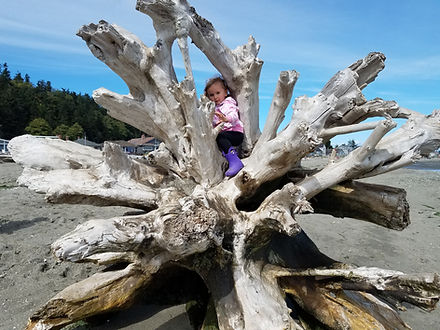
Copies others, especially adults and older children. Playing in nature with other children (especially older children) will give your child lots of ideas of things to do. This is the perfect age to start attending a mixed age nature play group near you, such as Free Forest School!
Points to things or pictures when they are named. When you see something interesting, tell your child. Don’t point to it, necessarily. You can foster language development this way by saying things like, “Let’s run to the big rock.” “Where is the red bird?” or “I see a gigantic puddle!”
Finds things even when hidden under two or three covers. Playing in sandboxes is a great experience to introduce now if you haven’t already done so. You can hide nature items like pinecones, flowers, and rocks in your sandbox and have your child find them. If you’re feeling particularly "Pinterest-y," there are tons of similar sandbox activities out there to try. For example, you can make “fossils” with plaster of Paris, hide them in your sandbox, and give your little paleontologist a shovel, paintbrush, and magnifying glass to help him excavate.
Begins to sort shapes and colors. There is so much to sort outside: leaves, rocks, sticks, and flowers are just a start. Use small bags or buckets for sorting or simply draw circles with chalk for a spot to place the items. When hiking, hunt for specific things like big pinecones and small pinecones. Support your child’s language of colors by naming the colors of things all around you—including the trail markers! We love to high-five all the “yellow dots” along our favorite trail.
Plays simple make-believe games. A twig might become a phone, a rock may become a steering wheel, you might pretend to fall asleep outside on a comfortable looking boulder. Engaging in imaginative play with your child is one of the finest things in life.
Builds towers of 4 or more blocks. Try building towers of flat rocks together or take your blocks outside. You can also cut wood for an outdoor block set or create a Waldorf-inspired block set like the one on this blog post.
Follows two-step instructions. Practice two-step directions when you’re getting ready to go outside. Say, “Get your shoes and jacket, so we can go outside.” When you’re out and about, there’s plenty of ways to practice this. “Give the big stick and the little stick to Daddy,” for example.
Names items in a picture book. It doesn’t have to be in a book; at this age, children can name some items they see in general, such as after you hike to the top of a mountain and look out. That being said, reading is SUCH an important experience for young children to have, and I would be remiss if I didn’t use this opportunity to encourage reading! Bring your books outside, especially your nature books. Bring your book Some Bugs by Angela DiTerlizzi outdoors while you explore and capture insect, or bring Over and Under the Pond by Kate Messner to the lake with you and see what you can find that matches the book. Bringing your books outside can really make nonfiction come to life!
Stands on tiptoe. Kicks a ball. Begins to run. Climbs onto and down from furniture without help. Walks up and down stairs holding on. Again, you cannot replicate outdoor terrain indoors. Even playgrounds do not give your child the opportunities for physical challenge that natural settings provide. Let your child climb on rocks, trek through puddles, roll down hills, and balance on logs. The natural terrain will help your child naturally develop balance, core strength, and spatial awareness
Throws ball overhand. If you haven't yet taught your child the pleasure of throwing rocks into giant bodies of water, now is the time. Big splashes are encouraged!
Some of the ideas I shared are super simple and some are more complex. Maybe just knowing that the simple things you’re doing outside with your baby matter and are contributing their development will support your efforts to get outside. Your child is never too young to start appreciating nature and never too young to reap the benefits of being outdoors!
How To Create A Nature Collection Tray & Other Nature Activities For BABIES
Nature activities for kids encourage exploring the marvels of the outdoors with your children. However, when you are stuck indoors, bring the wonders of nature to your child’s fingertips with a nature tray.
Do you remember running through the grass, picking dandelions, and watching the wind scatter their petals?
How about all the pebbles, sticks, leaves, and pine cones you collected and treasured?
In the busyness of our world, many children do not have the opportunity to connect with nature. Your child’s love of the outdoors can be encouraged with nature walk activities and a tray to explore their treasures.
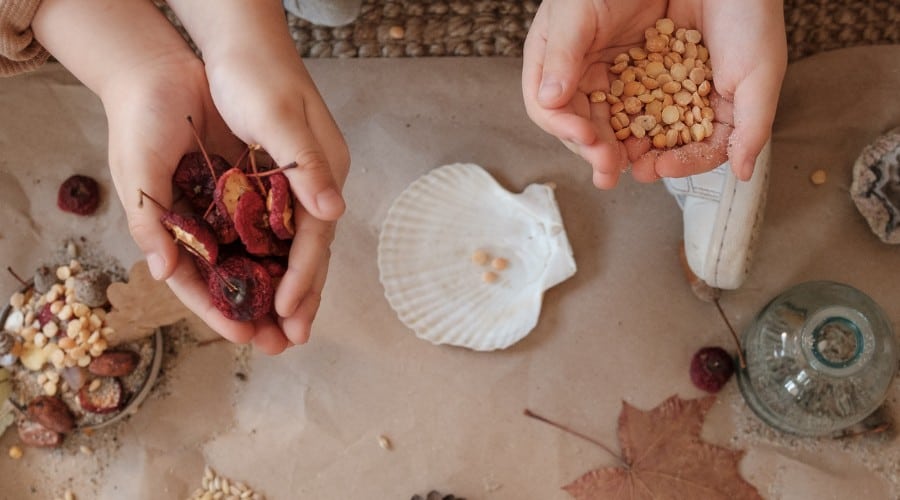
Bring the wonder of nature indoors with a nature tray.
Connecting With Nature
A nature tray or Treasure blocks are a perfect place to showcase your child’s riches. They can add things they have collected to examine, touch, and discover. It offers hands-on opportunities for creating, learning, and nature exploration activities.
When your youngster has moved on to finding new treasures, use the old materials for nature crafts.
Creating a nature tray can be as simple or elaborate as you want. It can be a one-trip project or something you build over time. What’s important is that you don’t rush the process. Step back and allow your child to discover and gather the items.
Kids love getting outside and exploring nature, so why not create something you can enjoy together, inside or out?
With their unique display windows, wooden blocks for kids (Treasure Blocks) are a wonderful addition to your nature activities. They hold things found in nature, such as leaves, flowers, twigs, shells, pebbles, sand, and more. Children can display their small treasures for investigation and observation.
Beautiful and versatile, these one-of-a-kind wooden building blocks are perfect for storing trinkets or natural treasures.
Creating Your Nature Tray
You will want to start with a large tray. It can be something you have lying around, found in a garage sale or a hobby store. Even a flat basket, cookie sheet, or cutting board will work.
Use a tray with compartments or include some small baskets or containers to keep the items organized.
There are many ways you can build and organize your tray with these nature tray ideas.
You can choose a category like a season – for instance, fall or spring.
Additionally, you can base it on a theme – for example, a beach or a forest. Of course, it is contingent on what you have nearby.
Once you have your tray and containers, you will need to gather the items.
One way to do this is to create a nature scavenger hunt list. Then head outdoors to engage in some nature activities for kids. One fun activity is to take a nature walk to find the items on your list. No need to go far; it could be your nearest park, forest, beach, or even your backyard.
Bring along some bags, baskets, or other containers for the collection process.
Try This List Of Things To Collect In Nature:
Flowers, leaves, and pine needles from a variety of plants and trees
Sand and shells in a variety of shapes, sizes, patterns, colors, and textures
Twigs, sticks, and tree bark from a variety of trees
Pine cones, acorns, pods, and seeds of contrasting shapes, sizes, and colors
Rocks, stones, and pebbles of different shapes, sizes, textures, and colors
Anything that your child finds attractive and is not harmful to themselves or the environment.
Other Outdoor Activities For Preschoolers
Before heading outdoors, grab your nature journal and nature books for kids. Be sure to make time for you and your child to note ideas or experiences. Encourage them to sketch their thoughts, feelings, or observations.
Remember how fun it was to run a crayon or colored pencil over the leaves to get a design?
Or how about pressing flowers?
Or tracking down that colorful bird you saw in your nature book?
Give them the freedom to pick the nature activities that interest them the most.
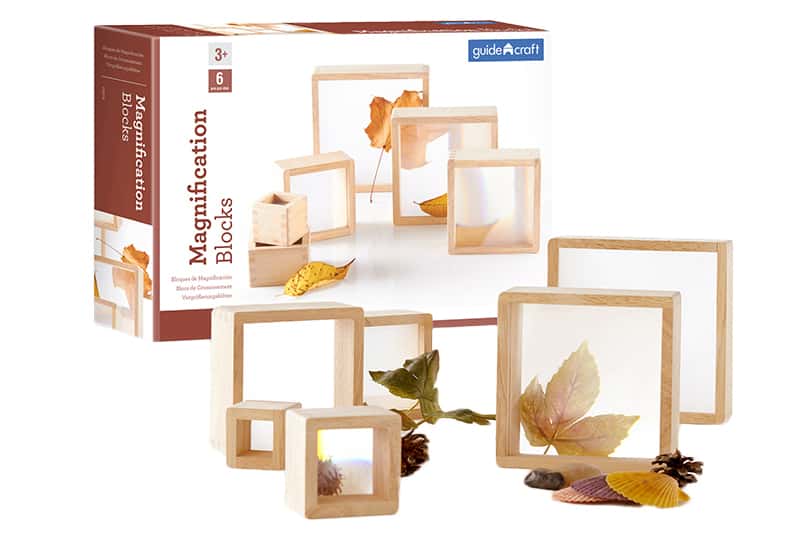
Wooden Square Blocks – Magnification Blocks
Finally, no nature tray would be complete without a magnifying glass or a set of wooden square blocks with magnification. With their compact storage, these wooden nesting blocks are ideal for adding to your tray or taking along on your next nature hike. Grab your set now!
exploring nature with babies
One of the most precious things in a parent’s life is to have the opportunity to re-live the joy and wonder of childhood. Did you know you’d be given this gift when you had your first child? I didn’t know how much I would appreciate and enjoy this second chance. Also, I didn’t know how easily I would forget and let this opportunity go to waste.
Slowing down and exploring nature with children is an easy way to grab hold of these experiences.
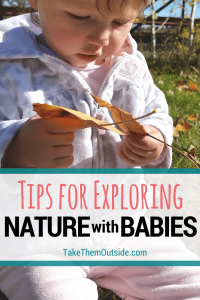
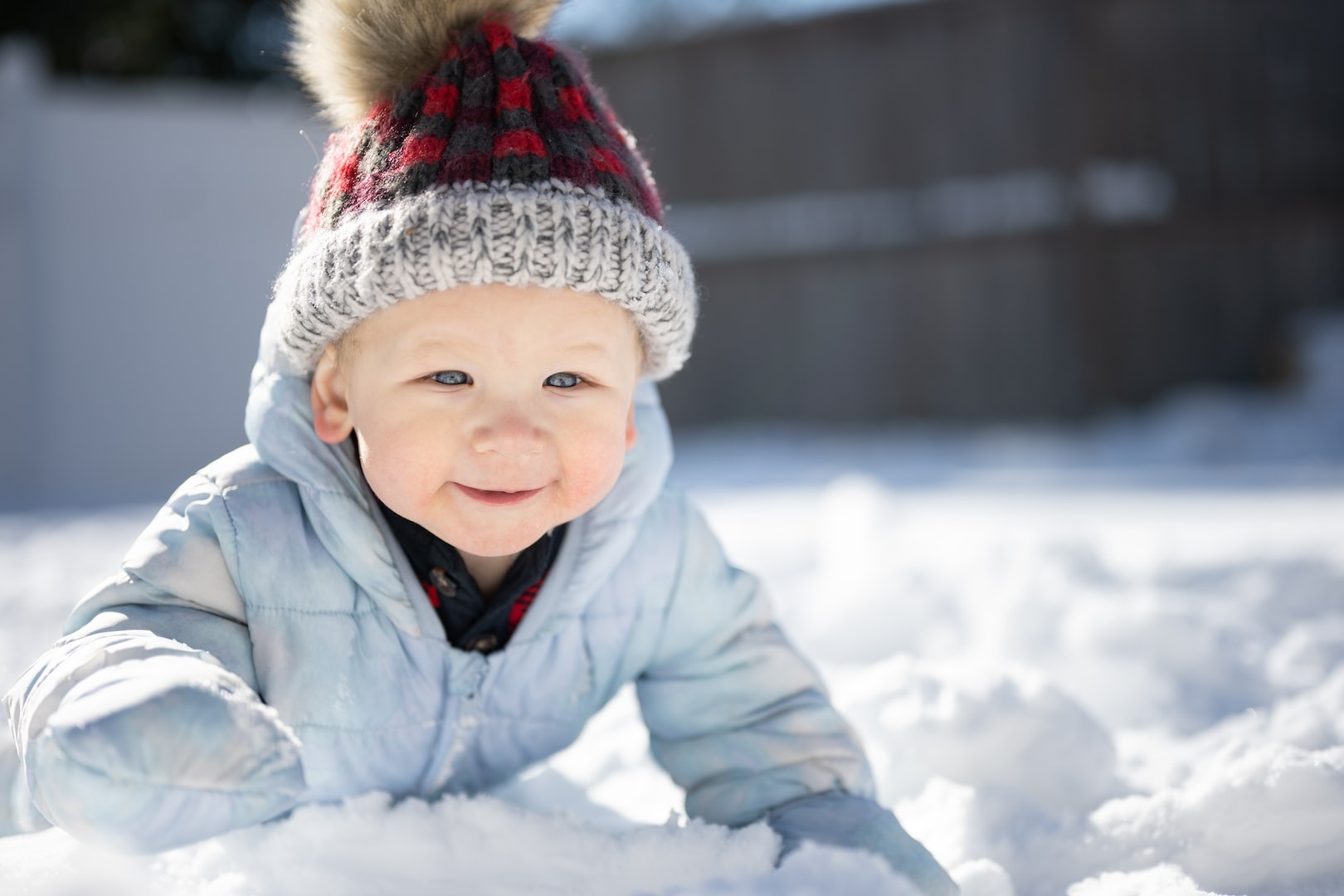
Have you heard the saying “the days go slow, but the years go fast”? You may not have fully appreciated the meaning of these words until your first child turns 2. At first parenting is amazingly hard. The range of emotions, the physical demands, and the sacrifices you make every day really do make those early days go by slowly. But then, one day they turn 2 and it seems like the years just flew by!
So, when my second child arrived I promised myself I would slow down and appreciate those slow days. Sure, two kids just made those days seem even harder! But I had the awareness now that one day I’d miss this precious baby time.
While I can’t make parenting easier for you I can assure you that one day it will all be easier. One day, and who knows when that day will arrive, you’ll think to yourself ‘wow, they don’t really need me that much anymore’. So, make sure you have some precious memories to think back on… like that time your little came running up to you, glowing eyes, wide-smiled to hand you the half-wilted dandelion they so lovingly chose just for you.
Don’t let this time slip you by. Slow down. Connect. Take them outside and explore nature with your children.
In this 3 post series, you’ll read about the why’s and how’s of exploring nature with children at different ages. The first post will discuss getting your infants and babies outside, the second post will discuss preschool and early elementary aged children, and the last post of the series will be aimed at older children.
Exploring nature with children:
Part 1
The why and how of exploring nature with babies and infants:
It’s easy to explore nature with infants. Get them into some appropriate clothing for the weather, and head out the door. Nature is a perfectly balanced sensory experience for children. They’ll be able to take in the muted colours and natural sounds without feeling overwhelmed. If you’re holding them against you for these experiences, then all the better as they are also being comforted and connected to you at the same time.
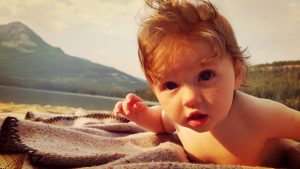
Some tips for exploring nature with infants
Really, this stage is most about your comfort levels with bringing baby outdoors. My first child was born in January. The cold Canadian winter gave me reason to stay indoors and cuddle with him for the first few weeks, but then it was time to get out of the house!
Below you can read all about infant carriers and stollers, but know that you don’t need either of these things to bring your infants outside. If you have a porch or balcony take advantage of that and head outside for nursing and cuddle time throughout the day. It will give you both a change of scenery and a healthy dose of fresh air.
Using Carriers to bring infants outside:
Get yourself a comfortable baby carrier appropriate for infants. Many new moms like to snuggle their babies up in a wrap like this one. I, however, could never get it to work properly and I always felt uncomfortable with baby on. But, I loved wearing my babies in the Ergobaby. There is a special insert to use with infants in this carrier.
If you plan to wear your baby in cool weather think about what you’ll wear to keep both of you warm. You can put baby into a warm bunting prior to getting into the carrier. There are special jackets to be worn over baby carriers. You can use blankets or a stylish shawl to wrap around you both for extra warmth. I found that my maternity jacket or my husband’s jacket could wrap us both up quite nicely. You may need to do some experimenting here.
You’ll also want to take precautions if it is hot out. Some carriers are designed with mesh for cooling in hot climates. Consider too how you’ll keep the sun off baby. A large wide-brimmed hat worn by you will help, or a shade umbrella, baby wearing long light clothing, and a sun hat as well. But, it can be a challenge to get a hat on a tiny baby in a carrier.
Another tip for hot weather is to try timing your outings for early in the morning or later in the evening if it is very sunny where you are.
Using Strollers to bring infants outside:
If you’d rather use a stroller to get outside then make sure it maneuvers well on unpaved trails and snowy paths (if you get snow). Usually this means you’ll want a stroller with larger wheels. We absolutely love our chariot! I can’t say enough good things about these. And I’m not the only one… sometimes it’s a little humorous to arrive at baby activities in Jasper and see a whole row of chariots lined up!
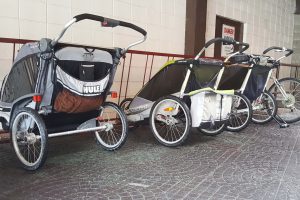
Just a regular day at the daycare bike rack!
Why do I love the chariot? These cougar chariots are perfect for infants right up to 5 year old kids. They have an attached screen cover as well as a rain protector. You can purchase accessories to pull the chariot behind a bike or cross-country skis. You can attach a single wheel in front which is good for rocky and rooty trails or for jogging. Or, you can use the smaller front wheels when tooting around town. If you end up getting an all-terrain stroller (or the chariot), make sure you consider how your infant will use it and if it supports them appropriately. The chariot has a special infant sling attachment you can use for the wee-ones. I don’t know if other all-terrain strollers are appropriate for infants.
I do talk up the chariot (for good reason), but you don’t have to have one to get outside. When my first baby was born, all I had was a regular basic stroller. It did remarkably well on the snowy sidewalks and I could bundle him up nice and warm inside.
If you are using a stroller to get your babies outside you’ll want to make sure they are warm and dry. For whatever stroller you use, try getting a rain and net cover for it. You may also want to look into stroller sleeping bags or stroller inserts for extra warmth. But, if you don’t want to go all fancy, you can use a big warm blanket. Just make sure baby has room to breathe and move.
It can be tricky to keep a baby cool in a stroller. I really appreciated these lightweight muslin blankets in the warm summer months. You might also want to rig up extra shade for your stroller with an attachable umbrella or a blanket thrown over the canopy. I have heard of parents using cooling mats in the stroller, but I am unsure what these are as it doesn’t often get overly hot here.
Lastly, your infant is so small that you don’t really need a carrier or stroller at all. Just wrap them up and bring them outside in your arms onto the porch, into the backyard, or out for a little walk.
Having a baby is life-changing! They’re so tiny and helpless and you are so tired and overwhelmed! But, believe me, you need to get out of the house. You need to get some fresh air and away from the laundry and dishes and that smelly diaper genie. Go for a walk. Go read on a park bench. Buy yourself some flowers.
You might want to get yourself a new pair of comfortable walking shoes. And yes, your feet might have changed sizes after having that baby…. It happens! You may also want to reconsider lugging around that huge diaper bag and decide instead on a smaller shoulder mom bag instead. (Read more on downsizing to a mom purse in this article.)
However you decide to get out, remember your excursions into nature don’t need to be long or challenging or overly involved. Only do what you’re comfortable doing. Just make sure you do it!
As infants grow and start to explore the world a little more independently they should be encouraged to explore outdoors as well. And hopefully you’ve already started getting out for regular walks and excursions, so continuing these should be easy, right?
Getting outside with your older babies continues to be a great way for you to step away from the distracting household tasks and mindless escape of social media. Not only is getting outside good for your baby, it’s continues to be supremely healthy for you at this stage. Spending time in nature will let your body and mind relax, pump up those ‘feel-good’ chemicals (which might seem quite lacking at this point), and help you focus solely on appreciating the time you have with your quickly growing baby.
Exploring nature with older babies:
Babies don’t need planned activities or outdoor toys. Let them experience nature for what it is. Take them for walks outdoors. Let them touch the leaves as you walk by. Point out birds and animals. Encourage them to touch the flowers and feel sand, water, rocks, and grass on their feet.
Throw down a blanket if you like or let them sit on the bare ground. Let them pick up the leaves and lay in the grass. Sure, you need to keep choking hazards out of their hands and away from their mouths and you’ll probably want to make sure the puppy hasn’t left a present in the lawn. But, other than that, a little dirt and germs are totally fine (and in fact are beneficial ) to growing healthy immune systems.
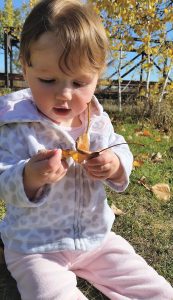
A few tips for getting outside with your infants and babies more often:
Have a stroller that is easy to maneuver and that you enjoy using. Keep an extra diaper, baby blanket, and some wet wipes in the pocket.
Keep a picnic blanket in the stroller, car, or by the door to make you more likely to take a break at the park and have a seat on the ground.
If you have a porch or balcony take advantage of that for cuddles and nursing, reading story books, and eating snacks outside.
Many new parents adopt a routine of taking a walk around the neighborhood in the evening as a way to reconnect as a couple, give baby some fresh air and cuddle time (if baby is being worn), and help rewind from a hard day of parenting.
Child carriers for the older baby:
There are many child carriers available and they all have different pros and cons associated with them. Do you want a carrier that brings baby directly against you or can the carrier be between your bodies? Do you want a hard frame or a soft carrier? Front or back? Baby facing you or away?
Also, who will be carrying the baby? My husband preferred to carry our babies in the hard frame. I did not. I felt off-balance wearing it. I preferred to carry the babies on my front in the Ergobaby. My husband’s back hurt when he used the Ergobaby, but his back didn’t hurt when he wore the babies in the Snugglie (which was uncomfortable for me)… so, you see what I mean… You might have to try a few different ones out before you and baby find the perfect fit.
If you do find that you are wanting to get out for longer excursions with baby in a carrier, the Deuter Kid Comfort is a very popular hard-framed carrier…. the Cadillac of carriers, if you will. Some of these baby backpacks will come with cushioned head supports, storage pockets, and sun and rain covers.
We, however, managed all our longer walks with an old hand-me-down carrier, a sun umbrella, and some baby blankets for a cushioning.
What about strollers, wagons, and sleds?
Sure, you can still use the all-terrain stroller for bringing your baby out for walks and exploring. But, you can also consider using a wagon once your baby can sit safely and comfortably. Our babies and toddlers absolutely loved going for wagon rides. In the winter you can take them out for rides on a sled.
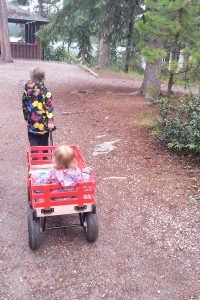
Out for a ride in our family’s favourite red wagon.
Wagons can get pretty fancy too. We have a lovely red wagon friends lent to us and it’s perfect. I can throw it in the van and bring it to town or the park. In the winter we pull a cheap plastic sled. But, if it’s really cold you can get sleds with covers on them for the little babies.
You don’t actually need any gear to get babies outside!
You’ve heard all about carriers and strollers and wagons, but those items really aren’t necessary for exploring nature with your babies. They help, sure. But, you can just go outside. Go for little toddling walks. Sit on the grass. Watch the birds from your balcony.
How to encourage nature interaction between you, your babies and nature?
Because babies are still taking in the world, don’t overwhelm them with too much all at once. Let them explore slowly. They might want to crawl around or be happy sitting in one spot. And since they are just little babies they won’t be too bothered if you bring them to the same old park bench or backyard spot time and time again!
When you’re down on the ground with your baby pick up things and hand it to them to explore, like leaves, larger rocks, and pine cones. You can point out birds or describe how the breeze feels on their skin. Direct them to look at the dancing leaves or the bright flowers. You are simply a guide for them… connecting words and feelings to what their senses are discovering.
However, if you find visiting the same places boring, try sightseeing in new parts of town, check out farmer’s markets, take a walk at the botanical gardens or zoo, visit outdoor festivals, and start exploring your local nature trails if you haven’t already.
If you’re a person who needs a little more motivation and company to go out for walks you might want to look into Hike it Baby. This organization has hike coordinators all over the United States and Canada who arrange group walks for young families.
You can also include nature at home too. When you’re reading books to your babies, find books with plants and animals in them. Describe how they look. Make the sounds. Talk about whether you see these things outside or not. These are little ways to start bringing nature into the home and into your interactions with baby so when you head outside you will be more likely to also take note of these things.
The short of it:
When your children are just babies getting outside should be easy. Don’t overstress and plan. Remember, simply sitting in the grass and feeling the breeze ruffle their hair is exciting enough for them. Instead, use this time to get yourself comfortable with bringing them outside. Figure out how to go for walks and do it regularly.
Creating a routine helps set the standard for your child as they grow into the more adventuresome toddler years and you’ll be more likely to continue heading out with your littles if you’ve gotten comfortable with the process already.
You don’t need any fancy gear and you don’t need to organize nature activities. Instead, let your baby’s eyes, ears, hands, and feet do all the work.
Exploring nature with babies can be a simple as you make it. A walk around the block, a blanket on the grass, a visit to the neighbor’s garden. The important thing is to just get outside and start.
What should you do now:
25 Outdoor Activities for Babies to Enjoy outside
After being cooped up indoors for a good portion of the week, my daughter and I are loving the summer sunshine and warm temperatures. She’s not capable of running and jumping yet, but that doesn’t mean she can’t enjoy playing outside.
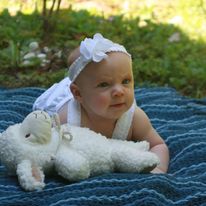
There are a number of age-appropriate outdoor activities that infants can take part in during the summer months. Here are 25 of these activities.
OUTDOOR SUMMER ACTIVITIES FOR INFANTS
Read books while sitting on a blanket in the shade of a tree.
Swing in a baby swing.
Gently ride down a slide on the lap of a parent or older sibling.
Go for walks through various settings (meadows, neighborhoods, wooded areas, etc.).
Watch birds perch on tree limbs or eat at birdfeeders.
Look at flowers in bloom. Gently feel their petals (make sure baby keeps flowers away from his or her mouth).
Listen to wind chimes and/or watch windsocks blow in the breeze.
Stand or crawl on grass and feel its texture (make sure the grass is free of fertilizers and pesticides).
Splash in a kiddie pool.
Eat fruit or breastmilk popsicles on hot days.
Enjoy watching and popping bubbles blow by a parent or sibling.
Take in the sights, sounds, and tastes of a farmers market.
From a safe distance, watch and listen to heavy equipment work at a construction site.
Feel the textures of rocks, twigs, pinecones, and sand (make sure baby keeps these away from his or her mouth).
Play with cups and similar toys in a water table (or a large bowl or tub of water).
From a safe distance, watch and listen to a parent mow the lawn.
Dance while taking in the sounds and sights of an outdoor concert.
Enjoy the sights and sounds of the zoo.
From a safe distance, enjoy the sights and smells of a parent using a barbeque grill.
Take in the sights and sounds of a state fair.
Watch and listen to the running water of a brook or small stream.
Play with paper streamers on a breezy day. Watch as the wind blows the streamers.
Sit on a blanket with several balls and an empty basket or box. Drop the balls into the basket or box.
Feel the raindrops while going for a walk during a light rainfall (make sure there is no lightening before going outside).
I’m excited for my grand-daughter to enjoy these activities!
INTRODUCING Babies to Summer
As the weather warms up, you want to get outside with your baby and find things to do together. From splashing at the local splash pad to sensory play in your back yard, I put together a list of some of my favorite activities for babies in the summer.
We live for the summer. Our winters in North Carolina are fairly mild compared to Northern states, but it’s not warm by any means. My kids look forward to all the summer activities like swimming, playing in the sprinkler, and more.
When you have babies underfoot, you may wonder what babies in the summer enjoy doing, and I have plenty of suggestions like getting a kiddie pool, a water table, and a bubble machine. Trust me, you’ll use the bubble machine like crazy!
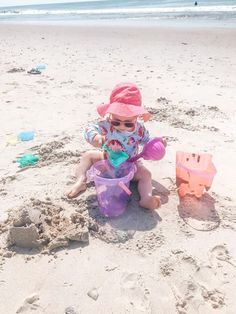
Related: The 7 Best Family Vacations with Babies
Activities for Babies in the Summer
1. Splash in a Kiddie Pool
My kids love splashing in their kiddie pools. You don’t need a big backyard pool – even though they are surely nice – to have fun with your babies in the water. Something I noticed is my babies are happier in a kiddie pool where they can splash and sit down without being held in the pool.
All you need is a little kiddie pool – I prefer the blow up ones rather than the hard plastic. Toss in some sand toys, and I promise this is one of the best activities for babies in the summer!
You can go a bit bigger and get this Dinoland Inflatable Pool – it’s so cute and I know babies and toddlers will love it!
2. Paint Outside with Finger Paints
Finger painting is such a fun sensory activity for babies, as long as you have non-toxic finger paints since babies eat everything. Put out a few sheets of card stock paper or a white sheet and let them go crazy!
It’s a great way to entertain your baby for quite awhile!
3. Sensory Scoop Bins
Babies thrive on sensory activities, and when summer comes, water and scooping bins are one of the best things for them to do. Fill a small, shallow plastic bin, add some measuring cups and little bath toys.
Your baby will love it!
4. Play with a Bubble Machine
Babies and bubbles go hand in hand. Nothing makes kids happier than bubbles to chase and hit with their hands. Instead of blowing the bubbles over and over – and driving yourself nuts – get a bubble machine. All you have to do is fill it up with soap and watch your baby go crazy.
5. Get Messy with Rainbow Spaghetti
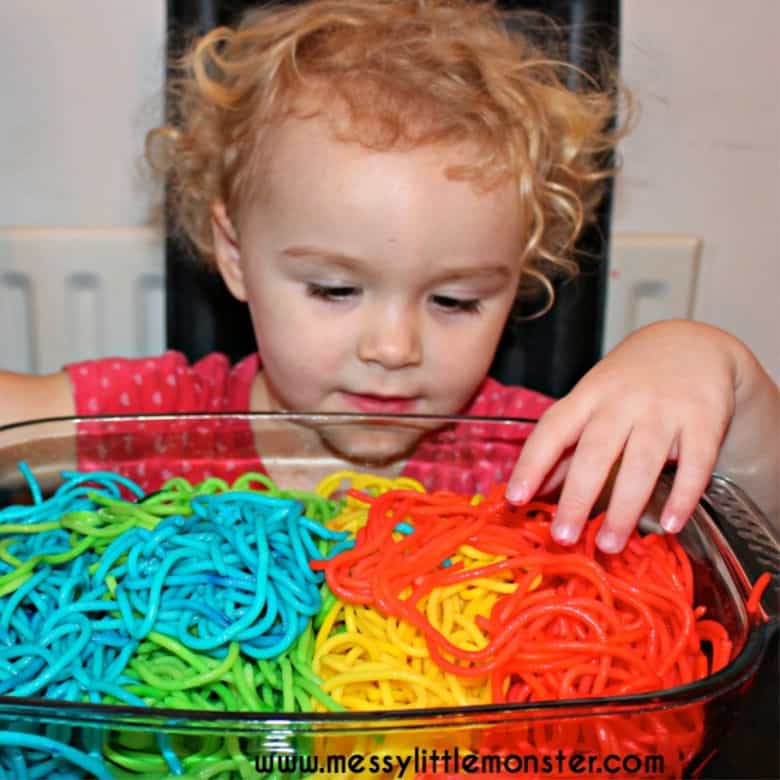
If you’ve never made rainbow spaghetti for sensory play, you have to give it a try. It’s one of my son’s favorite activities for babies in the summer. Plus, it’s cheap – you need some boxes of spaghetti noodles and food dye.
6. Ball Pit + Water
Here is an easy idea that you can do with your babies in the summer. Grab your inflatable ball pit – the one you keep inside – and bring it outside. Add some water to it with the balls. Your baby will have a field day with two of their favorite things in the world!
7. Play with Sidewalk Chalk
Sidewalk chalk is something babies, toddlers, and older kids enjoy together. Babies might not be able to draw beautiful pictures, but they’ll feel like they’re included with their older siblings.
8. Have a Picnic Together
When it’s nice outside, pack a picnic with some of your favorite lunch recipes or meals and bring it to the park for a fun picnic together. Your baby will get to crawl in the grass while your older kids play.
That’s the perfect way to spend a lovely summer day, and it’s cheap, something we all love.
9. Enjoy a Water Table
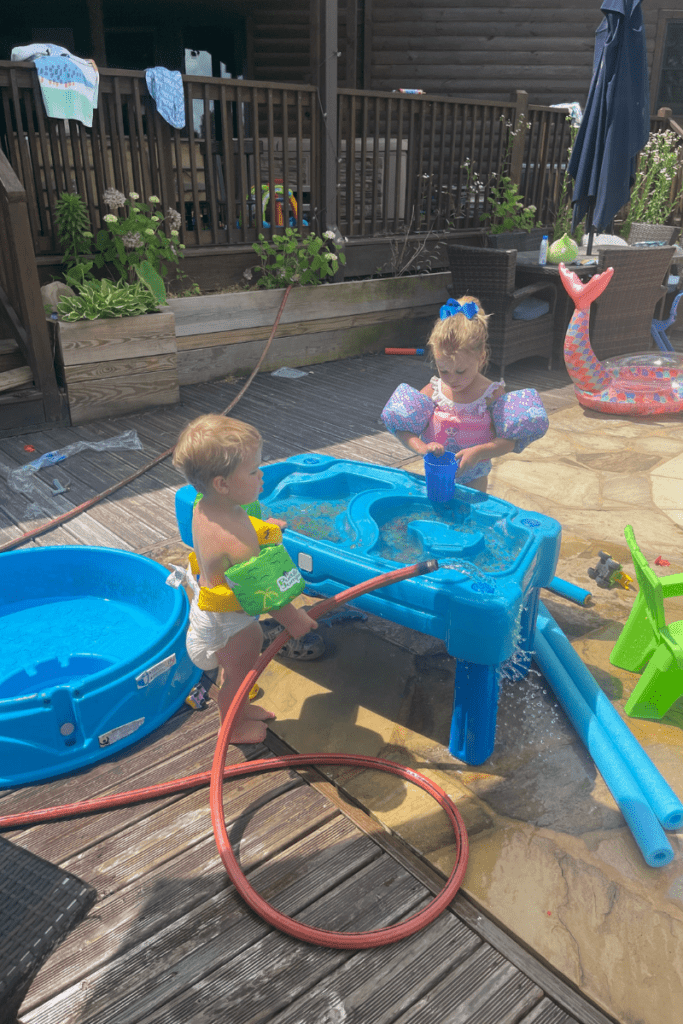
All babies need to have a fun water table to stand at and splash. Our favorite is the Little Tikes Fish ‘n Splash Water Table; kids get to pretend to fish in the table and it comes with little buckets.
10. Dig in the Sand
Some parents aren’t sure about sand with babies because they will take a bite or ten of the sand. However, a mouthful of sand is disgusting but not deadly to your baby. It’s a great sensory activity, and all little kids love a good sandbox.
This is an investment, but something all of your kids will use for years and years. I highly suggest getting one that isn’t plastic with a nice cover so it
11. Explore Your Backyard
You don’t have to go anywhere to have an adventure! Your backyard is full of excitement for your baby to explore dirt, rocks, insects, birds, and more.
12. Take a Stroller Walk
If you have a stroller, you have a great activity for babies in the summer. Put your baby in the stroller and walk around your neighborhood, enjoying all the sights and sounds.
13. Head to the Beach
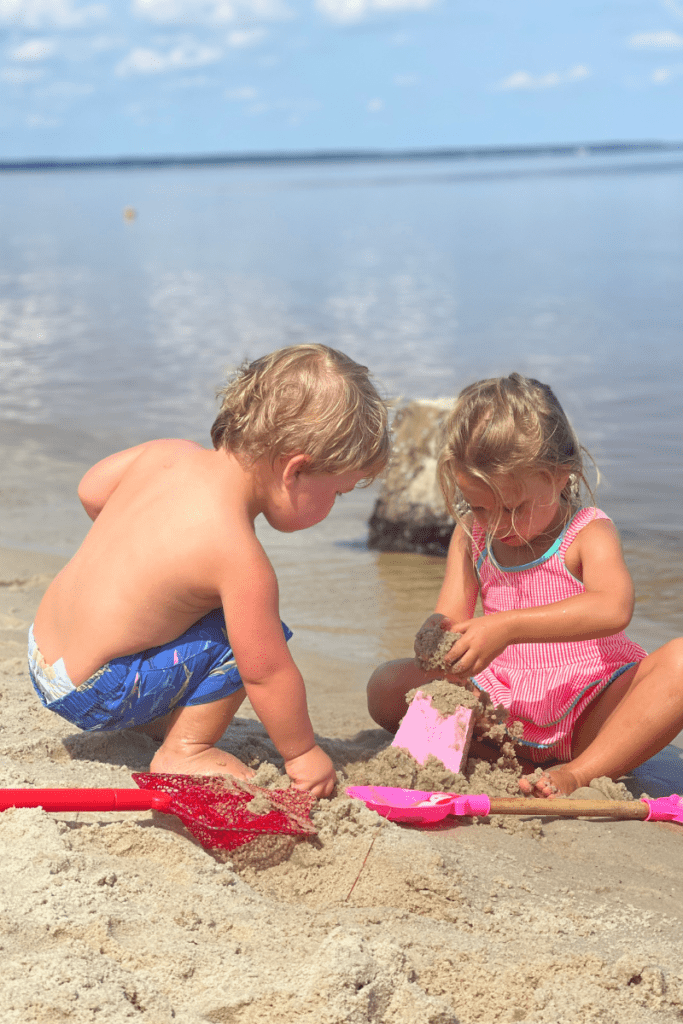
All babies love the beach. Sand, sun, and water – what is there not to love? Your baby will love to splash in the water, dig in the sand, and soak up the rays. I think a beach vacation is the best vacation to take with babies.
Related: 8 Best North Carolina Vacations for Families Everyone Will Love
14. Visit the Zoo or Aquarium
Another one of the best activities for babies in the summer is a trip to the local zoo or aquarium. Your baby can spend time looking at all the different animals, and if it’s hot outside, most aquariums feel nice and cool on a warm day.
Many zoos offer different activities for kids to participate in and enjoy for kids of all ages. Make sure you see what your local zoo offers!
15. Go on a Nature Walk
Nature walks are a great adventure for families and children of all ages. Put your baby in a baby carrier or an all-terrain stroller and go see what is awesome out in nature. Bring a picnic along with you and make a day of it.
16. Take Baby Swim Classes
I highly suggest babies take swim classes, and many times, they’re offered at local pools in the morning. Babies have to learn how to survive if they fall in the water – it’s truly for survival.
After your baby is done with class, take time to enjoy the pool together.
17. Go to the Playground
Another one of the popular activities for babies in the summer is to head to the playground. Some playgrounds are more baby friendly than others. Try a new park each week; it’s a great reason to get out with your baby and have some fun!
18. Visit the Local Splash Pad
I bet you have a local splash pad near you! Many community pools have splash pads connected, so get on that swimsuit – yes, even you mama! – and head out with your baby. Babies in the summer love splash pads almost more than pools; they love to run through the water and have all the fun.
Infant Sensory Science
Outdoor Sensory Science Activities are actually more relaxing when you are not worrying about the mess from the activity. Babies can be rinsed with the hose before they come inside. Parents can focus on a fun experince with
Rainbow Ice (6 months - 3 years old)
Fill ice cube trays with water and food coloring. Mix primary colors to create new colors. Freeze until hard, and put in a large container with a smaller container containing warm water. Also include tongs, hammers, tongs and turkey basters. As the ice cubes melt discuss what is happening, colors mixing, and temperature of the water. Compare if warm or cold water melts the ice cubes faster. To add a gross motor activity; ask children if they know how water moves, it dances, and when it stops dancing it freezes. Do a quick round of freeze dance before or after this activity.
Colorful Fizz (1 ½ - 3 years old)
Fill a small container with approximately half a box of baking soda, keeping the area smooth and even. Put white vinegar in 3 squirt bottles or bowls with pipettes or spoons, and add red, yellow, and blue food coloring to the vinegar. The use of primary colors will encourage color mixing of the vinegar in the baking soda. Encourage child to squirt or dump vinegar into the baking soda. Once the fizzing is done and the baking soda can’t be seen carefully dump out liquid to show the next layer of baking soda, can be repeated about four times.
Rainbow in a Bag (4 months - 3 years old)
Combine 1 cup cornstarch, 1/3-cup sugar, and 4 cups cold water in a large pot. Heat and stir constantly. Once the mixture begins to thicken (consistency of Vaseline), remove it from the heat and continue to stir for another minute. Divide the mixture into 2 bowls and set aside to cool. Add a few drops of food coloring to each bowl. (If you want to create a rainbow divide into 7 bowls.) Put some of each color mixture into a Ziploc gallon bag (and seal with duct tape if necessary). You can hang it in the window or tape to the table for your child to squish and move the colors together
Nature Walk (newborn - 3 years old)
Go for a nature walk in your neighborhood, back yard or a local park. In addition to enjoying the fresh air talk to your child about using their five senses (sight, sound, smell, touch and taste). While on your walk talk to your child about what you are seeing (blue sky, pink flowers, green grass, yellow flowers) As you continue walking try a game of I Spy; name a color and see how many different objects can be found with that color.
Talk to your child about what they are hearing while you are walking (leaves crunching, birds chirping, cars driving). You could also point out birds, animals or cars and ask your child what sounds they think they make?
Talk about how the smells you are smelling (flowers, leaves) and if your child enjoys those smells, if you enjoy those smells.
As you are walking look around for different textures for your child to explore (tree bark, green grass, dried leaves, flowers, pinecones)
Talk to your child about how those feel (smooth, bumpy, rough, crunchy, sharp) and if they enjoy how they feel. While you are outside enjoy a snack and use descriptive words to describe what you are eating or drinking (crunchy, sweet, red apples or crunchy, salty brown pretzels or cold, wet water).
A way to extend your nature walk is to collect some items and make a collage by either gluing on a piece of paper or sticking to a piece of contact paper. You can also make a masking tape bracelet for your child (sticky side out) to create a nature bracelet while walking.
2 Bubbles (2 months - 3 years old)
Using pre made bubble solution or a homemade solution (1/2 C. water, 1/4 C. detergent, 1 teaspoon sugar) bubbles provide an engaging sensory experience for your child. Bubbles are a great tummy time activity for your child that encourage your child to move their head to follow the bubbles, and as infants get older, they may reach out or even chase the bubbles.
Toddlers can help make bubble solution or use a wide range of materials for wands/blowers: empty straws, plastic bottles with the bottoms cut off (can add an old sock at the bottom of the bottle to create “elephant trunks,” cookie cutters, paper towel tube, empty berry baskets, any kitchen utensil with slots/holes.
Sensory Bottles (2 months - 3 years old)
Create a sensory bottle for your child by using objects around the house. Take an empty plastic bottle fill it with whatever you choose. Some ideas: colored water and oil, rice, beans, small bells, pom-poms or cotton balls, small toys, beads, glitter, or popcorn kernels.
Once you have the items in your bottle add some glue to the lid to ensure it is not taken off by curious hands. You can place bottles near baby during tummy time so they have something interesting to look at. You can extend this activity by creating a bowling game (line up bottles and roll a ball to knock them over) for your toddler and talking about the sounds that you hear as they fall over.
Sink vs. Float (2 - 3 years old)
With your child collect about ten items from around the house. Fill a medium sized container with water, and ask your child to make a hypothesis (guess) about which items will sink (go to the bottom of the container) or float (stay near the surface). Then test each hypothesis by placing items one at a time in the water. Allow your child time to analyze what is happening with each object, and ask questions about what they think is happening. Sort the objects into a sink and a float pile, and count how many sank vs floated.
Magnet Exploration (1 ½ - 3 years old)
Make a collection of random items be sure to include items that are magnetic, as well as, not magnetic. Place items on a magnetic cookie sheet or pie pan with a strong magnet. Show your child how some objects will stick to the magnet and others will not. Allow them to explore the materials. This activity can be extended by exploring magnets on metal surfaces such as cookie sheets, pie pans or doors (garage or front doors)
Sensory Exploration (4 months - 3 years old)
Fill a mediums sized container with a variety of materials for your child to explore. Examples: Tissue or wrapping paper, water and spoons/cups, soapy water, washcloth and baby dolls or other plastic toys to be washed, shaving cream, plastic Easter eggs and rice, dried bean or small animals, sand and scoops, Easter grass and animals. Sensory activities facilitate exploration and naturally encourage children to use scientific processes while they play, create, investigate and explore.
Sensory activities allow children to refine their thresholds for different sensory information helping their brain to create stronger connections to process and respond to sensory information
Plant a Garden (1 - 3 years old)
Planting a garden with your child can be a very rewarding experience. Decide where you will be creating your garden (a spot in your yard, flower beds, or a container garden on the patio) what you want to plant (flowers, herbs, fruit, vegetables) and get your plants or seeds. When you are ready to plant; make www.actionforchildren.org 3 sure your soil is ready before heading outside with your toddler. Help your child dig a hole for the plant, and gently place the plant or seed in the hole and cover with dirt. Talk to your child about what they are doing (scooping brown dirt, how the dirt feels or smells, placing the plant inside the hole, what the plant looks like (short or tall, leaves or no leaves, flowers or no flowers, how the flowers smell) and how helpful they are being. Once all the plants have been planted encourage your child to water the plants. Throughout the summer, have your child help you weed and water the garden, as well as, enjoying the new fruits or vegetables they help harvest from the garden.
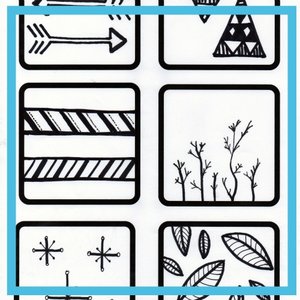
8 Baby Play Ideas With Black And White Picture Cards
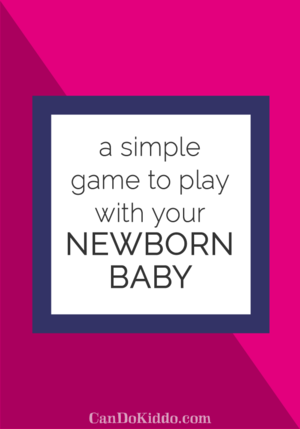
Simple Sensory Newborn Baby Play - Rub & Clap
